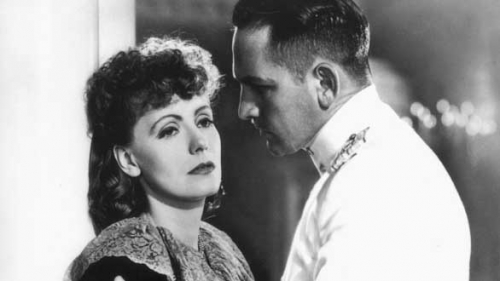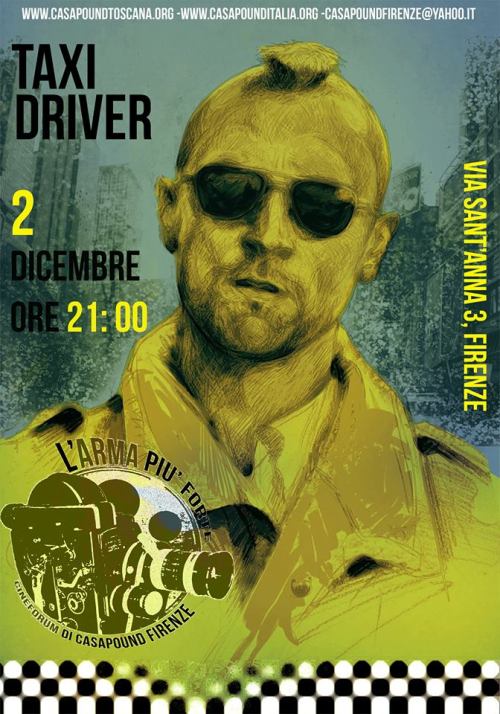mardi, 23 février 2016
Sept films à voir ou à revoir sur la Littérature russe

Sept films à voir ou à revoir sur la Littérature russe
Ex: http://cerclenonconforme.hautetfort.com
Il est un fait évident que la littérature russe compte parmi le fleuron des arts littéraires du Vieux continent, au sein duquel le 19ème siècle fait figure d'âge d'or. Jugeons-en plutôt à la lecture de l'école romantique d'Alexandre Pouchkine, Nicolas Gogol, Ivan Tourgueniev, Fiodor Dostoïevski, Léon Tolstoï ou Anton Tchekhov ! Avec moins de faste, le début du 20ème siècle poursuit un certain classicisme russe dont Maxime Gorki constitue la figure de proue. L'avènement du bolchévisme au pays du Grand Ours marque un coup d'arrêt dans la magnificence de la littérature russe, tant il est vrai que si le génie personnel de tout écrivain est la condition première à la réalisation d'un chef-d'œuvre, il est des climats politiques qui compliquent la tâche, voire la rendent impossible. Notons tout de même les œuvres de Boris Pasternak, Mikhaïl Boulgakov et Mikhaïl Cholokhov. Ces listes ne sont, bien entendu, pas exhaustives. Et comment pourrions-nous évoquer les lettres russes sans évoquer le caractère plus fiévreux des ouvrages d'Alexandre Soljenitsyne, bien sûr, dissident politiquement incorrect qui renvoie dos à dos le communisme et le capitalisme, mais également les théoriciens de l'anarchisme Mikhaïl Bakounine et Pierre Kropotkine ? Et plus proche de nous, l'inclassable écrivain franco-russe, fondateur du parti national-bolchévique, Edouard Limonov. Si comme toutes les littératures nationales, les lettres moscovite et saint-pétersbourgeoise furent très influencées par la littérature occidentale, plus particulièrement française, elles n'en conservent pas moins des aspects particuliers. Plus que tout autre, la littérature russe est certainement déterminée géographiquement et psychologiquement par l'âme de sa Nation, dont la construction identitaire est marquée par la violence des soubresauts de son Histoire récente. Le lecteur profane en Histoire russe pourrait rapidement se heurter à une littérature absconse qui lui ferait manquer la dimension charnelle de l'œuvre. Littérature pessimiste, voire nihiliste, dans laquelle les cicatrices et fractures morales de l'individu constituent des aliénations, littérature dense faisant figurer de nombreux protagonistes, acteurs d'une intrigue diffuse et compliquée, la littérature russe est très difficilement transposable sur une pellicule. Il est d'ailleurs à noter que ce ne sont pas des cinéastes russes qui s'attaquèrent aux monuments littéraires de leur patrie éternelle. Adapter, c'est trahir dit-on ! Cela vaut certainement encore plus pour Dostoïevski et Tolstoï ! Aussi, qui est exégète de ces œuvres littéraires, dont la force et la beauté demeurent un apport incommensurable à l'identité européenne, sera déçu des films présentés. Pour les autres, il s'agira d'une formidable découverte.
Anna Karénine
Film américain de Clarence Brown (1935)
La Russie tsariste dans la seconde moitié du 19ème siècle. Anna Karénine est l'épouse d'un sombre et despotique noble, membre du gouvernement. Prisonnière d'un mariage de raison, l'épouse délaissée n'a jamais vraiment manifesté de sentiment amoureux pour son mari, à la différence de son jeune garçon Sergeï qui constitue son seul rayon de soleil. L'amour qu'elle porte à son enfant ne lui suffit néanmoins pas. Sa vie faite de convenances bourgeoises et de respectabilité sociale l'ennuie terriblement. Aussi, lors d'un voyage à Moscou, succombe-t-elle aux avances du colonel Comte Vronsky, jeune cavalier impétueux. Vronsky ne tarde pas à suivre Anna à Saint-Pétersbourg. L'idylle adultère est bientôt découverte et provoque un scandale. Anna est chassée de la maison sans possibilité de revoir son enfant. Elle va tout perdre, d'autant plus que si le Comte est un fougueux prétendant, sa véritable maîtresse est l'armée du Tsar...
Fait rare ! Greta Garbo interprètera à deux reprises l'héroïne du roman éponyme de Tolstoï, après une première adaptation muette d'Edmund Goulding sept années plus tôt. La présente adaptation de Brown est soignée mais la retranscription hollywoodienne de la Russie tsariste a un côté "image d'Epinal" très décevant. On n'y croit guère ! On ne peut que se rendre compte qu'adapter à l'écran la richesse d'une œuvre dense de plusieurs centaines de pages est une gageure. Egalement, peut-être la volonté du réalisateur était-elle justement de gommer le caractère russe de l'œuvre de Tolstoï afin de délivrer une vision plus universelle de cet amour interdit. A cet égard, la mise en scène est impeccable, de même que les décors et les costumes. Garbo et Fredric March ont un jeu impeccable.
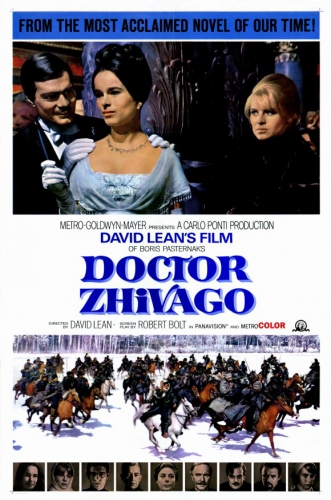
LE DOCTEUR JIVAGO
Titre original : Docteur Zhivago
Film américain de David Lean (1965)
Moscou en 1914, peu avant que la Première Guerre mondiale n'achemine la Russie tout droit vers la Révolution bolchévique. Le docteur Youri Jivago est un médecin idéaliste dont la véritable passion demeure la poésie. Jivago mène une vie paisible auprès de son épouse Tonya et leur fils Sacha, que vient bientôt bousculer Lara, fiancée à un activiste révolutionnaire, dont le médecin tombe immédiatement amoureux. Lorsqu'éclate la guerre, Jivago est enrôlé malgré lui dans l'armée russe et opère sans relâche les blessés sur le front. Sa route croise de nouveau celle de Lara devenue infirmière. D'un commun accord, ils se refusent mutuellement cette histoire sans lendemain. Après la Révolution d'octobre 1917, la vie devient précaire dans la capitale moscovite. Jivago se réfugie dans sa propriété de l'Oural avec sa famille afin d'échapper à la faim, au froid et à une terrible épidémie de typhus qui ravage le pays...
Film librement inspiré du roman éponyme de Pasternak et là aussi, un pavé de plusieurs centaines de pages à porter à l'écran. Lean s'en sort à merveille au cours de ces trois heures-et-demi, en retranscrivant magnifiquement l'épopée de ce jeune médecin en quête de vérité dans le tumulte de l'aube du vingtième siècle. Aussi, à la différence du livre, le film est-il recentré sur les protagonistes principaux. Pour que celui-ci soit à la hauteur, les producteurs y ont mis les moyens et ne se sont pas montrés avares en dépenses ! Le film, longtemps censuré au pays des Soviets, reprend bien évidemment avec la plus grande fidélité la critique du régime bolchévique par Pasternak. Ce qui n'est pas très surprenant non plus, concernant une production américaine en pleine période de guerre froide. Omar Sharif est convaincant. Une fresque grandiose qui a quand même un peu vieilli.
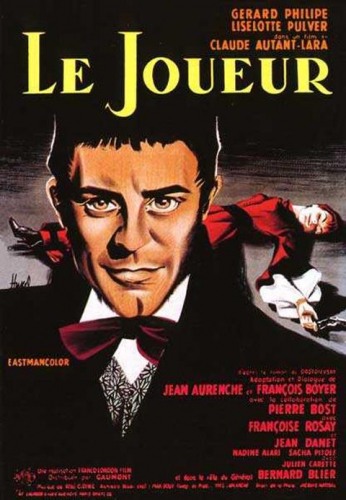
LE JOUEUR
Film franco-italien de Claude Autant-Lara (1958)
En 1867, Le général Comte russe Alexandre Vladimir Zagorianski prend du bon temps avec sa famille à Baden-Baden en attendant le décès de sa riche tante Antonina dont il espère l'héritage prochain. Le général est accompagné d'Alexeï Ivanovich, précepteur des enfants. L'oisiveté à laquelle la vie du général est toute dévouée le pousse à s'abandonner dans les bras de Blanche, habile intrigante. Quant à sa fille Pauline, elle est la maîtresse du marquis des Grieux, un riche aristocrate français qui entretient toute la famille du général tant qu'Antonia n'a pas expiré. Et la tante ne semble guère pressée de trépasser. Certes en fauteuil roulant, elle rend visite à son général de neveu en Allemagne. Ivanovich, qui avait prévu de retourner à Moscou après qu'il se soit fait éconduire par Pauline, change ses plans à l'arrivée de la riche tante qui le prend à son service. Antonia épouse le démon du jeu et a tôt fait de dilapider la fortune qui faisait tant l'espoir de Zagorianski...
Autant-Lara ne tire pas son meilleur film de sa libre adaptation du roman éponyme de Dostoïevski. Loin de là... Et Liselotte Pulver, Gérard Philipe et Bernard Blier ne sont pas au mieux de leur forme. Certes, Dostoïevski n'est pas l'auteur dont les personnages sont les plus simples à camper... Le film d'Autant-Lara est plus proche du Vaudeville que de la restitution de l'hédonisme russe en Allemagne. Néanmoins, cette fantasque description de l'univers du jeu au 19ème siècle, parfois trop caricaturale et mièvre, revêt des caractères plaisants bien rendus par les décors et l'atmosphère des villes d'eaux du duché de Bade. A réserver aux inconditionnels du réalisateur de La Traversée de Paris.

LOLITA
Film anglais de Stanley Kubrick (1962)
C'est l'été dans la petite ville de Ramslade dans le New Hampshire. Humbert Humbert est un séduisant professeur de littérature française récemment divorcé qui cherche une chambre à louer dans la ville. C'est dans la demeure de Charlotte Haze, veuve érudite en mal d'amour, qu'il trouvera son bonheur, surtout après avoir entraperçu Dolorès, quatorze ans, surnommée Lolita, la charmante fille de Charlotte. La propriétaire essaye par tous les moyens de s'attirer les faveurs du professeur bien plus tenté par le charme de la juvénile Lolita. Afin de pouvoir continuer à demeurer chez les Haze à l'issue de sa location, et ainsi à proximité de l'adolescente , Humbert n'hésite pas une seconde et épouse la mère. Le bonheur marial est de courte durée. Charlotte ne tarde pas à démasquer les véritables intentions de son nouveau mari...
Réalisation très librement inspirée du roman éponyme de Vladimir Nabokov qui ne fit pas l'unanimité. Certains allèrent jusqu'à hurler à la trahison de l'œuvre du moins russe des écrivains russes, dont la famille s'exila après la Révolution d'octobre 1917. Il est vrai que le film de Kubrick, qui n'a pourtant jamais craint d'érotiser son œuvre, contient une sensualité moindre que le roman. Il est vrai aussi que la censure exerçait encore de nombreuses contraintes à l'orée de la décennie 1960. Kubrick avait d'ailleurs déclaré, après avoir dû couper plusieurs scènes, qu'il aurait préféré ne pas tourner cette adaptation critique de la libéralisation sexuelle outre-Atlantique. La jeune Sue Lyon est merveilleuse, de même que James Manson. Il est difficile de juger si Lolita figure parmi les meilleurs Kubrick. Mais ça reste du grand Kubrick !
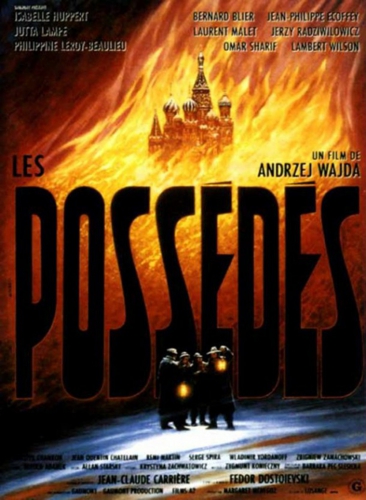
LES POSSEDES
Film français d'Andrzej Wajda (1987)
Vers 1870, dans une ville de province de l'Empire russe, un group d'activistes révolutionnaires tente de déstabiliser la Sainte-Russie. Aux réunions, grèves et diffusions de tracts, succède bientôt l'action clandestine. Conduits par l'exalté fils d'un professeur humaniste, Pierre Verkhovenski, la cellule nihiliste confie la direction du mouvement à Nicolas Stavroguine, de condition aristocrate, mais cynique et désabusé. Fanatique et charismatique, Stavroguine exerce un pouvoir sans pitié sur le groupe. Aussi, ordonne-t-il l'exécution de Chatov, ouvrier honnête qui manifestait ses distances avec la bande au sein de laquelle les tensions s'exacerbent. Verkhovenski intrigue afin que Kirilov, un athée mystique, endosse le crime. Kirilov est contraint au suicide...
Au risque de se répéter, une nouvelle fois, le film est inférieur au roman, bien que la présente réalisation de Wajda conserve un intérêt majeur et de splendides images. Le fond de l'intrigue est survolé et perd, ainsi, en intensité, au regard des centaines de pages de l'œuvre de Dostoïevski, mais comment pourrait-il en être autrement ? Si Omar Sharif incarne, de nouveau et de manière satisfaisante, un héros de la littérature russe, les personnages du film pourront être perçus comme excessifs à l'exception de Sjatov, révolutionnaire qui garde raison plus que les autres. Wajda semble assez peu à l'aise dans sa représentation de l'esprit révolutionnaire qu'il apparente trop vulgairement à une soif de violence gratuite. A voir quand même !
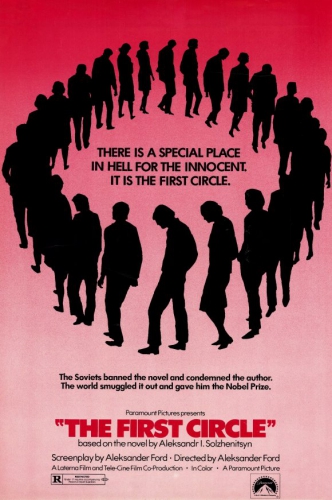
LE PREMIER CERCLE
Titre original : The First circle
Film américain d'Aleksander Ford (1972)
En 1949, un jeune diplomate découvre, à la lecture d'un dossier, l'arrestation imminente d'un grand médecin. Le diplomate prend la décision de prévenir anonymement le futur embastillé, ne se doutant que des oreilles mal intentionnées enregistrent la conversation téléphonique. La mise sur écoute n'est pas encore jugée suffisamment au point par les services secrets. Nombre de savants s'ingénient ainsi à perfectionner le système dans une charachka, laboratoire de travail forcé, de la banlieue moscovite. L'un des ingénieurs, conscient que l'écoute téléphonique est une arme coercitive précieuse pour les services secrets, entreprend de détruire sa création perfectionnée. Ce sabotage n'a d'autre issue que sa déportation en Sibérie. De même pour le diplomate bientôt identifié qui avait tenté de sauver la liberté du médecin. Parmi tout l'appareil répressif communiste, les laboratoires dans lesquels sont mis au point les armes de répression massive constituent le premier cercle de l'Enfer stalinien.
Il est surprenant que ce soit le cinéaste polonais rouge Ford qui se soit porté volontaire pour adapter à l'écran un roman de Soljenitsyne... Certainement revenu de ses illusions sur la nature du régime stalinien, Ford livre un plaidoyer en faveur de la liberté et de la dignité humaines. Soucieux d'une recherche esthétique, celle-ci n'est pourtant pas toujours réussie mais livre des passages intéressants que magnifie le noir et blanc. Le film est malheureusement tombé dans les oubliettes du Septième art. Quant au titre du récit éponyme et largement autobiographique de Soljenitsyne, il fait référence aux neufs cercles de l'Enfer de la Divine comédie de Dante Alighieri.
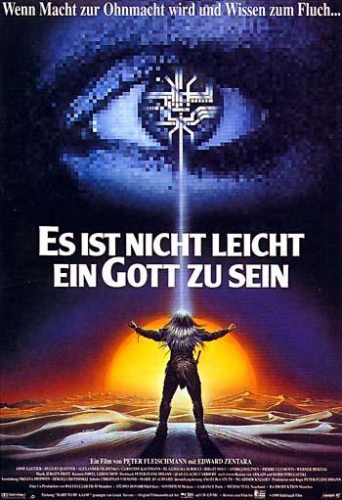
UN DIEU REBELLE
Titre original : Es ist nicht leicht ein Gott zu sein
Film germano-franco-russe de Peter Fleischmann (1989)
La Terre dans un futur loin de plusieurs siècles. Les Terriens sont parvenus à une parfaite maîtrise de leurs émotions afin de vivre dans une paix perpétuelle. A des fins d'étude, une équipe de chercheurs est envoyée en observation d'une autre civilisation humaine sur une lointaine planète. Afin de ne pas dévoiler leur présence, seul Richard est choisi parmi les siens pour aller à la rencontre des habitants. Un seul impératif guide son action : la non-ingérence dans les affaires autochtones. Le temps passe et Richard ne donne plus aucun signe de vie au reste de l'équipage demeuré dans le vaisseau spatial. Inquiet, Alan fait à son tour le voyage vers la planète semblable à la Terre mais sur laquelle les mœurs des habitants, brutales et cruelles, et la technologie accusent plusieurs siècles de retard...
Délaissons quelque peu l'univers de la littérature classique russe pour nous intéresser à un chef-d'œuvre méconnu de la littérature de science-fiction. Le présent film est une adaptation du roman Il est difficile d'être un Dieu des frères Arcadi et Boris Strougatski et est supérieur à la seconde adaptation éponyme d'Alexeï Guerman. Le présent film ne manque pas d'être subversif et peut être considéré comme une vive critique du soviétisme et, dans une perspective plus large, de la barbarie de la soumission à autrui qu'exerce la violence. La mise en scène est néanmoins faible, les cadrages serrés curieux au regard de l'immensité du décor et les effets spéciaux peu travaillés. Et pourtant ! Voilà un petit bijou que les passionnés de science-fiction considéreront comme culte. Les plus rationnels des spectateurs pourraient, quant à eux, s'endormir longtemps avant la fin. Tourné au Tadjikistan pour les décors naturels, il offre, en outre, de splendides paysages.
Virgile / C.N.C.
Note du C.N.C.: Toute reproduction éventuelle de ce contenu doit mentionner la source.
14:53 Publié dans Cinéma, Film, Littérature | Lien permanent | Commentaires (0) | Tags : russie, film, cinéma, 7ème art, littérature, lettres, lettres russes, littérature russe |  |
|  del.icio.us |
del.icio.us |  |
|  Digg |
Digg | ![]() Facebook
Facebook
jeudi, 24 décembre 2015
Comment l’Occident est passé de l’Iliade à Star Wars?

Une semaine après sa sortie aux États-Unis d’Amérique, le septième volet de la saga Star Wars – Le réveil de la Force – vient de battre un record de bénéfices, atteignant 238 millions de dollars. Quant au public français, l’intervalle de quelques jours qui sépara la sortie du film aux États-Unis et en France semble avoir été vécu comme un supplice, à en croire le Figaro qui titrait le 15 décembre : « En France, le monde de la culture s’impatiente. »
Jean Raspail et Renaud Camus ont le mérite d’avoir alerté le peuple français sur le Grand Remplacement orchestré par étapes, dans le plus grand silence. Mais ce remplacement n’est-il que démographique ? N’y a-t-il pas aussi une véritable substitution dans les fondements de notre culture ? Pour ce remplacement culturel, ce n’est pas dans les sables brûlants d’Arabie mais vers les tours métalliques de l’Oncle Sam qu’il faut porter le regard pour y trouver les réponses.
Qu’est-ce que la culture sinon un ensemble de mœurs, de techniques et de savoirs, cimentant l’unité d’un peuple, ayant pour fondement une tradition orale ou écrite ? Les textes dits « fondateurs » propres à chaque civilisation en ont à bien des égards façonné les mentalités. Que serait l’univers judaïque sans la Torah, le monde chinois sans Confucius ou l’Occident sans l’épopée homérique, la vaste littérature chrétienne et les nombreux récits d’aventures celto-germaniques qui en ont façonné l’esprit tout au long des siècles ?
Mais en 2015, Achille et le roi Arthur ont déserté nos esprits et nos discussions, sauf lorsqu’ils sont accaparés par des réalisateurs pour des films de qualité médiocre portant les mêmes messages lénifiants de tolérance et d’irénisme.
À la place, des allusions à Han Solo, Voldemort ou Gollum affleurent dans les conversations, quand ces personnages ne sont pas pris pour modèles par les jeunes générations. Détail révélateur : on parle de « saga » ou d’« épopée » pour désigner ces séries qui durent parfois pendant des décennies et engrangent des milliards de bénéfices.
ERTV (dont certes on peut avoir beaucoup à redire) a réalisé un reportage sur ce phénomène Star Wars, en interrogeant ces milliers de Français massés devant les cinémas pour espérer une place ne serait-ce qu’à la séance de 22 heures. L’effervescence était à son comble, les réactions étant quasi orgasmiques. Mais à la question « Pourquoi êtes-vous fan de Star Wars ? », cette joie frénétique laissait place au silence gêné ou, pire, aux poncifs sans cesse répétés : « Parce que c’est culte », dit l’un ; « C’est fondateur de notre culture », clame l’autre ; « Révisez vos classiques », affirme un troisième…
La culture est mobile, me direz-vous. Certes, l’art ne peut vaticiner indéfiniment entre Antiquité et Renaissance, la nouveauté est vitale pour l’esprit humain. Mais je ne conçois pas qu’Homère et Chrétien de Troyes s’effacent honteusement devant Rowling, Tolkien ou E. L. James au seul prétexte que « les temps changent ».
00:05 Publié dans Actualité, Cinéma, Film, Réflexions personnelles | Lien permanent | Commentaires (0) | Tags : actualité, star xars, cinéma, film, occident |  |
|  del.icio.us |
del.icio.us |  |
|  Digg |
Digg | ![]() Facebook
Facebook
jeudi, 17 décembre 2015
Sept films à voir ou à revoir sur les Nations sans Etat

Sept films à voir ou à revoir sur les Nations sans Etat
Ex: http://cerclenonconforme.hautetfort.com
Depuis la fin de la période de décolonisation amorcée au lendemain de la Seconde Guerre mondiale jusqu'au milieu des années 1970, les notions d'éternité et d'intangibilité des frontières nationales sont durablement inscrites dans la représentation mentale collective. Or, ces derniers mois, les aspirations à l'indépendance de l'Ecosse et de la Catalogne bouleversent ces certitudes qui n'avaient pas été aussi ébranlées, au sein des Etats piliers de l'Union européenne, depuis de nombreuses décennies. De nombreux Etats européens ne masquent pas leurs craintes que ces exemples ne créent un lourd précédent. En réalité, qu'est-ce qu'une frontière continentale si ce n'est une limite issue d'un traité de guerre ou d'une union par mariage ? Ainsi, les luttes indépendantistes constituent-elles un légitime moteur de l'Histoire. Depuis la dissolution de l'ancien bloc soviétique au début de la décennie 1990, qui a favorisé l'accession ou la ré-accession à l'indépendance de nombre d'anciennes républiques soviétiques, ce ne sont pas moins de six pays qui sont parvenus à l'indépendance ces vingt dernières années : de l'Erythrée en 1993 au Soudan du Sud en 2011, en passant par le micro-Etat du Pacifique des Palaos, le Timor Oriental et le Monténégro. Il nous sera permis d'être plus circonspect concernant le sixième cas. Car si de nombreux Etats européens ne masquent pas leurs craintes de voir leurs frontières remises en cause, ces Etats-dit-Nations, si prompts à se crisper sur leur intégrité territoriale avaient su se montrer plus favorables, en 2008, à soutenir l'indépendance de l'Etat-mafieux islamiste du Kosovo-et-Métochie, au détriment du caractère de berceau originel que représente le Kosovo pour une Nation serbe qui n'avait pas voulu se plier aux injonctions du Nouvel Ordre mondial... Mauvais apprentis sorciers, les arroseurs sont aujourd'hui les arrosés. "Aujourd'hui la Serbie, demain la Seine-Saint-Denis, un drapeau frappé d'un croissant flottera sur Paris".... La chanson prophétique Paris-Belgrade du groupe de rock In Memoriam fait dramatiquement écho aux récents événements survenus dans la très jacobine Nation française.

LA BATAILLE DE CULLODEN
Titre original : The Battle of Culloden
Film anglais de Peter Watkins (1964)
16 avril 1746, à Culloden, des membres des différents clans rebelles écossais des Highlands, menés par le Prince Charles Edouard Stuart, font face aux troupes anglaises du Roi George II de Grande-Bretagne, que commande le Duc de Cumberland. Il ne faut pas plus d'une heure pour que le destin de la bataille soit scellé. Les Ecossais, mal organisés, sont mis en pièce par l'armée royale mieux équipée. Le combat terminé, la pacification du gouvernement britannique est d'une férocité sans nom. L'objectif avoué est de totalement annihiler le système clanique et, ainsi, de prévenir toute nouvelle rébellion dans les Hautes terres. Ils seront plus de deux mille Ecossais à périr dans la lande marécageuse ce jour-là...
Watkins a curieusement opté pour un montage singulier. Aussi, le film se présente-t-il comme un documentaire d'actualités tourné caméra à l'épaule. Le réalisateur se balade donc sur le champ de bataille et interviewe les combattants çà-et-là sans manquer pas de commenter le déroulé de la bataille en voix off. Choix risqué mais, ô combien, magistralement réussi ! Tourné avec des comédiens amateurs et un maigre budget, on est loin de la grande production peu avare en mélodrame. Et voilà tout le charme de Watkins, le drame brut l'emporte sur le pathos, finalement assez anachronique. Culloden, c'est un peu un Braveheart réussi ! Un chef-d'œuvre !

BRAVEHEART
Film américain de Mel Gibson (1995)
En cette fin de treizième siècle, l'Ecosse est occupée par les troupes d'Edouard 1er d'Angleterre. Rien ne distingue un certain William Wallace de ses frères de clan lorsque son père et son frère meurent opprimés. Bien au contraire, Wallace souhaite avoir le moins d'ennuis possibles avec la soldatesque anglaise et s'imagine parfaitement en modeste paysan et époux de son amie d'enfance, Murron MacClannough. C'est en secret que les amoureux se marient afin d'épargner à la belle de subir le droit de cuissage édicté par la couronne anglaise. Mais Murron est bientôt violentée par un soldat anglais, provoquant la fureur de Wallace. La jeune femme est étranglée devant ses yeux. Wallace ne pense plus qu'à se venger. La garnison britannique du village est massacrée, première bataille d'une longue série de reconquête des clans écossais à l'assaut des Highlands...
Oui, Braveheart est un beau film ! Oui, les scènes de bataille sont fabuleuses ! Oui, le personnage de Wallace, imaginé et interprété par Gibson, ferait se soulever n'importe quel militant et s'enhardir du courage nécessaire lorsqu'il n'y a plus d'autre solution que le combat. Oui, Wallace est un héros nationaliste qui ne laisse pas indifférent. Oui, Gibson maîtrise toutes les ficelles du Septième art dès son deuxième long métrage. Oui, il est normal que vous ayez irrésistiblement eu une furieuse envie de casser la figure de Darren, brave étudiant londonien en Erasmus, qui vous tient lieu de pourtant si amical voisin. Oui, oui, oui et pourtant... Braveheart ne parvient pas au niveau de la réalisation de Watkins. La faute à un pathos romantique trop exacerbé et une idylle absolument mal venue avec Isabelle de France, bru du Roi Edouard 1er. Il est néanmoins impensable de ne pas le voir et l'apprécier.
FLB
Documentaire français de Hubert Béasse (2013)
En quatorze années d'existence, de 1966 à 1980, le Front de Libération de la Bretagne a commis pas moins de deux centaines d'attentats. Par tous les moyens, les F.L.B. entreprennent de défaire l'annexion de la Bretagne à la France, héritée du mariage de la Duchesse Anne, alors seulement âgée de douze ans, et du Roi de France Charles VIII. Les nombreux attentats visent l'ensemble des pouvoirs régaliens et symboliques de la France. Le plasticage de l'antenne de retransmission télévisée de Roc'h Trédudon, privant la Bretagne de télévision pendant plus d'un mois, et le dynamitage de la Galerie des glaces du château de Versailles comptent parmi les actions les plus spectaculaires menées par les mouvements indépendantistes en France. Evidemment, la répression ne tarde pas à frapper l'Emsav...
Divisé en deux parties, Les Années De Gaulle et Les Années Giscard, le remarquable documentaire de Béasse donne la parole à nombre d'anciens F.L.B., dont le témoignage est assorti de nombreux documents inédits. Provenant d'horizons politiques, parfois les plus opposés, l'extension du F.L.B. ne pouvait que rimer avec scission. S'ouvrant aux thèses socio-économiques anticapitalistes, l'Armée Révolutionnaire Bretonne entend marier ses initiales au sigle F.L.B. et lutter pour une Bretagne plus progressiste. Béasse, par bonheur, entend tendre le micro à toutes les tendances des F.L.B., et ce, avec une objectivité appréciable dans le traitement des témoignages. Les pendules sont remises à l'heure pour ceux qui ont la mémoire courte ou la dent dure sur la réalité du mouvement breton. Parfaitement intéressantes que ces deux heures documentaires.

GENERATION FLNC
Documentaire français de Samuel Lajus (2004)
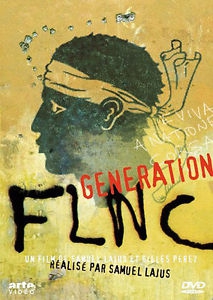
Il est dit que l'omerta règne en Corse. Pas dans ce passionnant et poignant documentaire en tout cas. De nombreuses images d'archives enrichissent les témoignages d'une trentaine d'ex-militants quinquagénaires du Front, de représentants du nationalisme corse mais également de hautes personnalités, tel le commissaire Robert Broussard, Jean-Louis Debré ou Charles Pasqua. La langue de bois n'est ainsi pas de mise, y compris sur les sujets les plus sensibles, des règlements de compte entre partisans de la même cause aux négociations secrètes entre les clandestins et l'Etat, mais aussi sur la dérive mafieuse de certaines factions. Finalement, ce sont les représentants de l'Etat qui en disent le moins ; tant il est vrai qu'ils n'ont pas les fesses complètement propres sur ces sujets. Deux années de tournage pour achever ce document, extraordinaire de décorticage d'un sentiment identitaire. Indispensable pour qui s'intéresse au sujet.
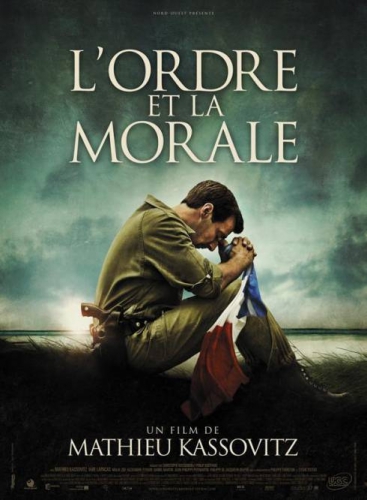
L'ORDRE ET LA MORALE
Film français de Mathieu Kassovitz (2011)
1988, loin de l'hexagone, sur l'île kanake d'Ouvéa, quatre gendarmes sont abattus dans l'assaut de leur caserne et vingt-sept autres retenus par des membres du mouvement indépendantiste du Front de Libération National Kanak et Socialiste. La situation se dégradait depuis de nombreux mois. Trois cents militaires sont dépêchés sur l'île calédonienne pour libérer les otages. Philippe Legorjus, patron de l'élite des gendarmes d'intervention, et Alphonse Dianou, leader des preneurs d'otages, partagent bien des valeurs communes, l'honneur surtout. Legorjus sent qu'il peut maîtriser la situation sans effusion de sang mais la France est alors à deux jours du premier tour des élections présidentielles. Dans le combat qui opposera Jacques Chirac et François Mitterrand en pleine cohabitation, la morale ne semble pas être la première préoccupation des deux candidats.
Tiré de l'ouvrage La Morale et l'action de Legorjus, le film ne manqua pas de faire scandale. Film militant pro-indépendantiste selon les partisans de la vérité d'Etat, film inutile pour de nombreux Kanaks estimant la réouverture des cicatrices inutile. C'est certainement Legorjus qui constitue la source la plus fiable pour expliquer ce bain de sang. Manipulation des faits pour de basses considérations électives, réalité d'un néo-colonialisme français, fortes rivalités entre de hauts gradés, la prise d'otages de la grotte ne pouvait connaître d'issue sereine. Les exécutions sommaires de militants indépendantistes fait prisonniers sont là pour le rappeler. Parfois manichéen dans sa caricature des militaires français, le film de Kassovitz demeure néanmoins extrêmement convaincant. A voir absolument !
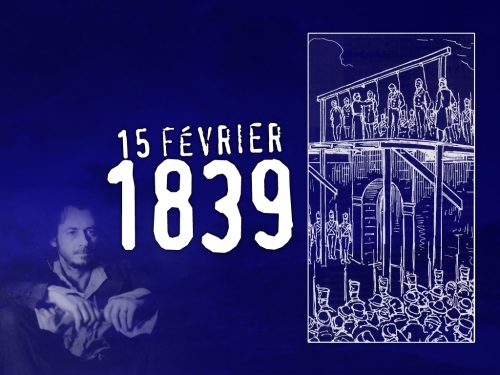
15 FEVRIER 1839
Film québécois de Pierre Falardeau (2001)
14 février 1839, sous le régne de la Reine Victoria, deux héros québécois de la lutte pour l'indépendance, Marie-Thomas Chevalier de Lorimier et Charles Hindelang, apprennent que la sentence de mort par pendaison sera appliquée le lendemain. Voilà deux années que ces hommes comptent parmi huit cents détenus emprisonnés à Montréal dans des conditions dégradantes après l'échec de l'insurrection de 1837, dont une centaine a été condamnée à mort par les autorités colonialistes anglaises. Entourés de leurs compagnons d'infortune, vingt-quatre heures les séparent de leur funèbre destin. De vagues sursauts d'espoir affrontent la peur et le doute. Une seule chose est sûre, affronter la mort sera leur dernier combat. Et ils ne regrettent rien...
Malgré une parenté historique et linguistique évidentes, que connaît-on aujourd'hui du Québec en France et de son aspiration à la liberté ? Inspiré de faits réels, Falardeau rompt avec sa filmographie satirique et a à cœur de rendre hommage aux luttes indépendantistes qui ont enflammé le pays québécois au 19ème siècle. Le réalisateur livre un huis-clos sombre de toute beauté. D'un parti pris indépendantiste évident, le film a légitimement été fortement égratigné par la critique anglophone dénonçant un déferlement de haine antibritannique. Quelques approximations historiques ne nuisent pas à un ensemble prodigieux.

SALVATORE GIULIANO
Film italien de Francesco Rosi (1961)
5 Juillet 1950, le corps criblé de balles du bandit indépendantiste sicilien Salvatore Giuliano est découvert dans la cour d'une maison du village de Castelvetrano. Si l'homme était traqué par la police et l'armée italiennes, il semblerait qu'il ait été retrouvé avant eux. Le constat du décès est dressé par un commissaire tandis que les journalistes sont à l'affût du moindre renseignement. La mort achève une existence intrépide commencée en 1945 lorsque Giuliano s'engage dans la lutte violente, avec l'appui de la Mafia, pour l'indépendance de son île. Le 1er mai 1947, il avait été notamment impliqué dans l'assassinat de militants socialistes. Son corps est bientôt exposé dans sa commune natale de Montelepre, où sa mère et les habitants viennent se recueillir avec une dévotion non simulée. Tous les regards convergent alors vers Gaspare Pisciotta, lieutenant de Giuliano, que tous soupçonnent de l'avoir trahi et assassiné...
Film subversif et engagé à plus d'un titre ! Rosi utilise un curieux procédé scénographique pour évoquer la vie de ce curieux personnage historique sicilien, moitié bandit indépendantiste, moitié Robin des Bois dont le souhait était de voler les riches pour donner aux pauvres et arracher l'île à la domination italienne pour en faire le quarante-neuvième Etat d'Amérique. Ainsi, le récit anarchique de Rosi parvient-il à ne pas être brouillon sans aucun ordre chronologique. Autre point fort, Rosi est l'un des premiers à dénoncer les rapports étroits de la Cosa nostra avec le pouvoir politique sicilien. Enfin, le réalisateur n'a pas hésité à faire appel à des acteurs non-professionnels, renforçant le caractère authentique de l'œuvre. Un grand film politique par l'un des maîtres du cinéma italien.
Virgile / C.N.C.
Note du C.N.C.: Toute reproduction éventuelle de ce contenu doit mentionner la source.
00:05 Publié dans Cinéma, Film | Lien permanent | Commentaires (0) | Tags : cinéma, film, 7ème art, peuples sans état, écosse, nationalisme écossais, indépendantisme écossais, bretagne, nationalisme breton, corse, indépendantisme corse, québec |  |
|  del.icio.us |
del.icio.us |  |
|  Digg |
Digg | ![]() Facebook
Facebook
samedi, 12 décembre 2015
CHEYENNE-MARIE CARRON: Cinéaste de l’insoumission

CHEYENNE-MARIE CARRON: Cinéaste de l’insoumission
Pierre-Emile BlaironEx: http://metamag.fr
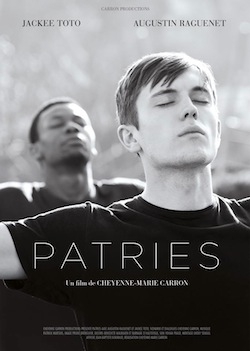 La bataille des régionales aura pour enjeu important la question des subventions attribuées au secteur culturel, là où la droite, suivie de la gauche, sont intervenues pour largement subventionner nombre d’associations dont la vocation consiste à détruire les structures traditionnelles, culturelles et artistiques de notre pays au détriment de créateurs, artistes, écrivains, cinéastes, revues, groupements de préservation de nos racines et traditions qui constituent les fondements même de notre avenir. Cheyenne-Marie Carron est, parmi de nombreux autres, l’exemple vivant de cette injustice et de ces dysfonctionnements.
La bataille des régionales aura pour enjeu important la question des subventions attribuées au secteur culturel, là où la droite, suivie de la gauche, sont intervenues pour largement subventionner nombre d’associations dont la vocation consiste à détruire les structures traditionnelles, culturelles et artistiques de notre pays au détriment de créateurs, artistes, écrivains, cinéastes, revues, groupements de préservation de nos racines et traditions qui constituent les fondements même de notre avenir. Cheyenne-Marie Carron est, parmi de nombreux autres, l’exemple vivant de cette injustice et de ces dysfonctionnements.
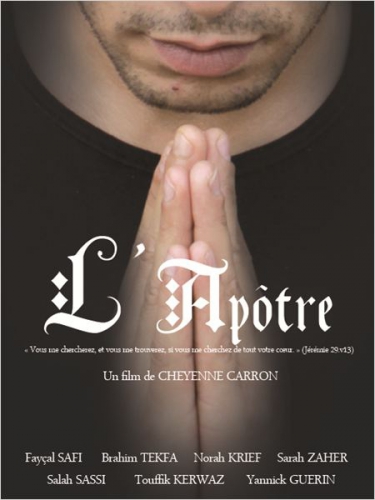 Quels sont les éléments que vous aimeriez apporter, après une certaine expérience, à votre façon de travailler et de concevoir les films, pour progresser dans votre métier ?
Quels sont les éléments que vous aimeriez apporter, après une certaine expérience, à votre façon de travailler et de concevoir les films, pour progresser dans votre métier ?
00:05 Publié dans Cinéma, Film | Lien permanent | Commentaires (0) | Tags : cheyenne marie carron, cinéma, film, france |  |
|  del.icio.us |
del.icio.us |  |
|  Digg |
Digg | ![]() Facebook
Facebook
lundi, 16 novembre 2015
ATTENTATS "Made in France" : l’affiche du film retirée, sa sortie repoussée

ATTENTATS "Made in France" : l’affiche du film retirée, sa sortie repoussée
Ex: http://sans-langue-de-bois.eklablog.fr
ATTENTATS "Made in France" : l’affiche du film retirée, sa sortie repoussée. « Une vague d’attentats va secouer toute la France. » Lorsqu’on la visionne au lendemain du vendredi sanglant qui a frappé Paris, la bande-annonce de Made in France glace le sang.
Ce film de Nicolas Boukhrief devait sortir en salles mercredi 18 novembre. Son scénario : un journaliste indépendant infiltre les mosquées clandestines de la banlieue parisienne et se rapproche d’un groupe de jeunes djihadistes qui s’apprêtent à semer le chaos au cœur de la capitale. Le distributeur du film, Pretty Pictures, a annoncé samedi que sa sortie était repoussée et sa promotion annulée.
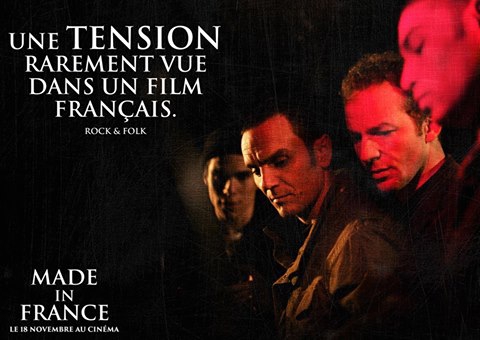
L’affiche de Made in France, elle aussi, a de quoi frapper les esprits. On y voit une tour Eiffel en forme de Kalachnikov géante, l’arme avec laquelle plusieurs assaillants ont tué plus de 120 personnes à Paris vendredi. L’affiche était placardée dans plusieurs espaces publicitaires de la RATP, gérés par la régie Metrobus. « Le producteur a demandé à ce qu’elle soit retirée, et nous avions décidé de la retirer de toute façon », indique un porte-parole de la RATP à Marianne. Un retrait qui a commencé dès la journée de samedi.
Made in France est un film d’autant plus prémonitoire qu’il a été tourné avant les attentats de janvier dernier. Dans la bande-annonce, l’un des personnages a cette phrase : « On est en guerre. Et dans toute guerre, il y a des victimes civiles. » Aucune nouvelle date de sortie n’a pour l’instant été communiquée.
(ndlr: La bande-annonce du films a été supprimée sur "youtube"!!!!!)
00:05 Publié dans Actualité, Affaires européennes, Cinéma, Film | Lien permanent | Commentaires (0) | Tags : terrorisme, cinéma, film, censure, état policier, attentats de paris, paris, france |  |
|  del.icio.us |
del.icio.us |  |
|  Digg |
Digg | ![]() Facebook
Facebook
mercredi, 28 octobre 2015
Patries. Un film choc de Cheyenne Carron sur le racisme anti-blanc et la remigration

Patries. Un film choc de Cheyenne Carron sur le racisme anti-blanc et la remigration
Le 21 octobre prochain sortira le nouveau film de la cinéaste indépendante Cheyenne Marie Carron , intitulé « Patries ». Un film particulièrement attendu car controversé avant même sa sortie, un film que nous avons pu visionner en exclusivité et en avant-première.
Cinéaste engagée, Cheyenne Marie Carron fait des films depuis 2001 sans bénéficier de la promotion et de l’aide dont bénéficient beaucoup de films qui ne font pourtant pas honneur au cinéma français. Sorti en 2014, son film L’Apôtre avait même suscité de violentes critiques et menaces parce qu’il évoquait l’histoire d’un jeune musulman désireux de se convertir au catholicisme. On se souvient même qu’une salle, à Nantes, avait déprogrammé le film après les attentats de janvier, de peur de représailles de la part d’islamistes.
N’ayant pas vu L’Apôtre, mon regard a donc pu se porter en toute objectivité sur le film Patries, film présenté comme traitant du racisme anti-blanc, dont j’avais vu la bande annonce au mois de mars dernier et lu le synopsis : « Sébastien et ses parents viennent d’emménager en banlieue parisienne. À son arrivée, il essaie de se faire accepter par un groupe de jeunes issus de l’immigration africaine. Malgré le rejet qu’il subit, une amitié complexe se noue avec Pierre, un jeune Camerounais en quête d’identité »
Quelle agréable surprise. Ou plutôt, quelle violente surprise. Car Patries est un film long-métrage coup de poing, une gifle en pleine figure, réalisé avec un budget équivalent à celui d’un clip publicitaire de 3 minutes effectués par des professionnels de la communication.
Un film intégralement tourné en noir et blanc et qui se divise en deux parties ; on suit d’abord principalement Sébastien (et le jeune acteur Augustin Raguenet) , jeune de la France périphérique obligé de suivre ses parents (dont son père aveugle) en banlieue parisienne, sa mère ayant trouvé un emploi à Paris. Très vite, il fait la connaissance de Pierre, un Camerounais qui le prends sous son aile et tente d’intégrer Sébastien à « sa bande », sans succès. Car Sébastien – éduqué par des parents ayant porté le « vivre ensemble » au statut de quasi-religion – va vite se rendre compte qu’il n’est pas le bienvenue dans cette banlieue, lui, le blanc, le babtou, la face de craie. La réalité des métropoles françaises et notamment de ses banlieues lui explose alors en plein visage sans que ses parents n’y comprennent rien et il deviendra rapidement une sorte de bouc émissaire pour deux « racailles » africaines ayant dès la première rencontre refusé de lui serrer la main en raison de sa couleur de peau. Seule solution pour lui ? Fuir, retourner dans la France périphérique, ou bien faire face, physiquement, et « s’intégrer » dans son propre pays.
La deuxième partie est centrée sur le personnage de Pierre, incarné par le brillant Jacky Toto, jeune Camerounais qui prend Sébastien sous son aile mais qui, suite à un mensonge non avoué de sa part, rompra de fait leur amitié et leur confiance naissante. Pierre – qui ne trouve pas de travail malgré sa volonté manifeste de réussir – est victime de DRH sans scrupules et d’une administration française qui ne pense qu’à l’aider, à l’assister, là où il voudrait réussir par lui même. Dans le même temps, il est en pleine crise identitaire, lui le Camerounais arrivé à 5 ans en France, jamais retourné au pays, mais n’ayant jamais su creuser sa place dans un pays qui n’est pas le sien. Doit-il partir et monter une entreprise au Cameroun, afin de réussir sa vie et d’aider son peuple , sur la terre de ses ancêtres ? Doit-il rester aux côtés de cette mère qui a tout sacrifié pour lui permettre une vie meilleure en France, et aux côtés de sa soeur, qui par le jeu d’une union mixte avec un bobo parisien français de souche, se sent beaucoup plus intégrée que lui ?
Le résultat est un film abouti, dont la scène finale ne pourra surprendre que ceux qui, habitant la France périphérique, ne connaissent pas ou n’ont pas connu la vie en banlieue, la vie d’un jeune blanc devenu étranger dans son propre pays. Durant ce film, qui, non sans un clin d’oeil appuyé à La Haine de Kassovitz , provoque un retour très violent au réel pour le spectateur, on se dit que du côté des enfants d’immigrés comme du côté des jeunes Français de souche, la cohabitation pacifique sera tout simplement impossible dans le futur, si ce n’est à la marge. Seuls les nantis ou les « vieux » comme dirait Julien Langella, et non pas les « anciens » , refusent de voir cette réalité, de l’admettre, alors même qu’elle est aujourd’hui communément admise par toute la jeunesse, quelle que soit sa couleur de peau ou son identité.
Patries est un film dur, violent psychologiquement, porté par une superbe bande-son particulièrement adaptée qui dévoile tantôt la foi chrétienne profonde de la réalisatrice, tantôt le ressenti de la rue, avec quelques morceaux de rap bien trouvés. C’est un film qui lève le voile sur une réalité jamais évoquée jusqu’ici par le cinéma français, trop souvent englué ces dernières années dans le politiquement correct et la médiocrité. Un film qui mériterait lui aussi d’être projeté dans toutes les salles obscures de France et d’être montré à la jeunesse de France, dans les collèges et les lycées. Car la réalité de la France des villes d’aujourd’hui, c’est plus Patries que L’Esquive, film médiocre sur des « jeunes de banlieue » qui avait, politiquement correct oblige, remporté 4 Césars alors même que la critique spectateurs ne lui accorde aujourd’hui que 2,6 sur 5 (2 962 notes) sur Allo Ciné.
Cheyenne Marie Carron est une cinéaste courageuse, au caractère bien trempé. C’est pourquoi elle a réussi avec brio ce film qui, au delà de ce qu’il montre, est techniquement réussi, surtout quand on connait le faible budget alloué. C’est pourquoi aussi, une certaine presse pourrait lui tomber rapidement dessus, ne pouvant admettre qu’une réalité certaine soit portée sur les écrans. Patries est en cette année 2015 au cinéma Français ce que « Catch Me Daddy » fut au cinéma anglais en 2014. Une révélation, une claque, à voir absolument à partir du mois d’octobre.
Plus d’informations sur le film ici
INTERVIEW
PATRIES
E.C : Le sujet du racisme anti-blanc, est assez tabou, avez-vous, vous-même subi du racisme ?
Cheyenne Carron : Je suis ni blanche, ni noire, mais marron clair de peau. Je n’ai jamais souffert de racisme de la part de personnes blanches ou noires. Depuis mon adolescence j’ai eu l’occasion de fréquenter des garçons et des filles issues de tous milieux et de toutes origines ethniques. J’ai observé les manifestations du racisme sous toutes ses formes. Aujourd’hui, j’ai pris assez de distance avec ce sujet pour pouvoir m’y intéresser. J’ai constaté que beaucoup de magnifiques films ont été fait dénonçant le racisme contre les noirs, je pense à « Imitation of Life », « 12 years a slave », ou « Dear white people », mais je n’ai jamais vu de films sur le racisme anti-blanc. Alors j’ai eu envie de corriger cela. Mais, avant de parler de racisme, Patries est surtout un film qui parle de différentes quêtes liées à l’identité.

E.C : N’avez-vous pas peur d’être taxée de racisme ?
C.C : Les valeurs dans lesquelles j’ai été élevée me mettent à l’abri de ce type de sentiment. J’ai des frères et sœurs blancs et un frère noir de peau. (Je viens d’une famille qui a adopté des enfants). Je ne suis pas raciste, et je pense donc qu’il est grand temps de parler des sujets qui fâchent ! Pour moi il ne s’agit pas de désigner des coupables et des victimes, mais il faut montrer le racisme mais aussi ceux qui l’exploitent en faisant mine de le condamner.
E.C : N’est-ce pas dangereux de traiter de ce sujet dans cette période compliqué ?
C.C : Il y a danger de se faire récupérer par des partis politiques extrêmes. Mais je pense qu’il y a aussi danger à ne pas s’emparer de ces sujets et de laisser à des gens sans humanité, et de les laisser pourrir dans la société… Et puis, je crois qu’un artiste doit s’emparer des problèmes de son temps.
E.C : Pour écrire ce scénario, vous êtes vous inspirée d’un livre, ou de faits divers ?
C.C : Je me suis inspirée du témoignage de plusieurs personnes. Elles m’ont raconté la manière dont elles tentaient de s’intégrer, mais aussi la manière dont elles vivaient une forme de rejet lié à leur couleur de peau, blanche ou noire.
E.C : Dans Patries vous nous montrez une famille, celle de Pierre, qui semble très attachée à son pays d’origine : le Cameroun.
C.C : Les sœurs de Pierre et sa mère, elles, sont très enracinées dans la culture Française, elles se sentent pleinement françaises. Pierre, lui, a un vrai désir qui grandit tout au long du film : celui de redécouvrir le pays d’où il vient. J’ai eu envie de parler d’un homme qui ne se sent pas heureux d’être en France, parce que sa culture d’origine lui manque. Je trouvais intéressant de montrer un immigré qui a soif de son identité perdue. Ça nous change du discourt habituel.. La France n’est pas son eldorado, il cherche autre chose. Pierre est aussi, d’une certaine façon, un héros. Il rêve de bâtir, et il croit en son destin. Mais pour lui, au fond de son cœur, son destin n’est pas en France. Son destin c’est le pays de ses ancêtres, alors que sa sœur ne jure que par la France.
E.C : Les deux mères de famille ont en point commun leur foi, c’est une thématique qui revient souvent dans vos films : la religion.
C.C : J’ai voulu faire le portrait de deux mères catholiques, à l’image de la mienne que j’aime. En tant qu’enfant abandonnée, j’aurais pu être adoptée par une maman noire, mais ce fut une maman blanche.
E.C : La notion de patrie incarne des réalités diverses selon le point de vue de chacun ; pour vous, quelle valeur a-t-elle ?
C.C : Moi qui ai été Pupille de l’État Français jusqu’à mes 19 ans, la patrie française ça a un sens. En tant qu’enfant abandonnée, j’ai bénéficié de la protection de l’État français et ça, ça n’a pas de prix. Mais il ne faut pas traiter les immigrés comme des enfants abandonnés ! Eux ont une terre quelque part, où ils sont nés, et où ils ont parfois une famille et des souvenirs. Un jour cette terre peut leur manquer, c’est le cas de Pierre.
E.C : Et où en êtes-vous avec le CNC ? J’ai cru comprendre que vos précédents films n’ont pas été subventionnés.
C.C : En 2014 le CNC m’a refusé deux scénarios (Hadès et Ma vie pour tes yeux lentement s’empoisonne), alors je ne présenterai plus mes scénarios à l’avenir. Je n’ai pas présenté Patries. J’ai beau faire ma maligne, à chaque refus ça me mine le moral et j’ai le sentiment que mon travail ne trouvera jamais grâce aux yeux du CNC. J’ai financé Patries avec l’argent que j’ai gagné sur les DVD de L’Apôtre.
E.C : Quels sont vos prochains projets ?
C.C : Je vais continuer à chercher le financement de « Hadès » et « Ma vie pour tes yeux lentement s’empoisonne », j’essaie d’élargir mon champ d’action à l’étranger. Si je n’y parviens pas, je vais devrais arrêter le cinéma. Je lui aurait donné tout ce que j’ai pu et Lui m’aura apporté beaucoup de joie et de réconfort.
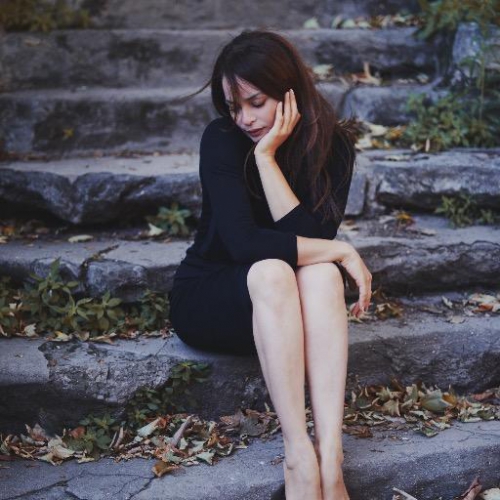
Entretien avec Cheyenne-Marie Carron, réalisatrice
Cheyenne-Marie Carron est un OVNI. On ne croise pas un petit bout de femme comme elle tout les matins devant la haie de son champ.
Elle a été adoptée toute petite par une famille qui compte deux autres enfants adoptés ainsi que deux enfants “bio”. Elle est la réalisatrice d’une petite dizaine de films et commence à faire parler d’elle et notamment dans les médias rattachés à ce qu’on appelle la réacosphère. Un caractère bien trempé et une personnalité solaire: elle fait son petit bonhomme de chemin et à l’occasion de la sortie prochaine de son nouveau film, Patries, Cheyene-Marie Carron nous permet de nous intéresser à elle en nous accordant un entretien.
-Bonjour Madame, qui êtes-vous ? Pouvez-vous vous présenter succinctement aux lecteurs de Belle-et-Rebelle ?
J’ai 38 ans. Je suis une réalisatrice, scénariste et productrice, catholique.
-Quelle est la motivation qui pousse une jeune femme comme vous à réaliser un film aussi polémique que Patries, qui porte sur le racisme anti-blanc, ce thème tellement controversé ?
Ce qui me pousse n’est pas la polémique, mais l’injustice. Beaucoup de très beaux films existent sur le racisme contre les noirs, mais aucun sur le racisme contre les blancs. J’ai eu envie de corriger cela.
-D’après vous, pour quelles raisons le racisme anti-blanc est-il l’un des tabous de la France moderne?
Peut-être la peur… La peur de se rendre compte qu’on ne déracine pas impunément les gens sans que cela n’entraîne de conséquences.
Comment se manifeste selon vous le racisme anti-blanc ? -
Je pense qu’il prend sa source d’abord dans un mal-être. Celui de se sentir étranger à la culture française, avec peut-être un sentiment de honte et rage d’avoir abandonné son pays d’origine. Puis vient la conséquence, c’est à dire l’agression verbale ou physique de l’homme blanc, du Français.
Dans cette situation tout le monde souffre, d’abord la victime, le Français blanc de peau, mais aussi celui qui agresse.
-Quels obstacles avez-vous rencontrés dans la réalisation de votre film?
Aucun, car je n’ai rien demandé !
Le CNC m’a été refusé sur tous les films, et j’ai décidé de ne plus rien demander à cet organisme, ni aux régions. Je fais mes films sans argent, et je galère pas mal… mais je m’accroche.
-Cheyenne-Marie, soyez honnête, vous aimez vous compliquer la vie: femme, entrepreneure, politiquement incorrecte, catholique, artiste, j’en passe et des meilleures, vous cherchez les ennuis ?
Je ne cherche pas les ennuis, et si l’on m’en fait, je me défends, car j’ai le sentiment d’accomplir des choses justes.
-Est-ce que d’après vous, le harcèlement de rue des femmes ne relève pas aussi du racisme anti-blanc?
Ce harcèlement s’étend aussi à des femmes qui ne sont pas blanches. Il provient je crois d’un regard sur la femme occidentale qui prend sa source dans le mépris de notre culture.
Il faut que la femme occidentale par sa dignité et sa fierté en impose aux barbares.
-J’ai cru comprendre que vous n’êtes pas dans le circuit de distribution classique des films. Comment faites-vous pour faire voir vos films ? Avez-vous des idées de leur audience ?
Effectivement personne n’accepte de distribuer mes films, alors je prends mon courage à deux mains et frappe aux portes des cinémas. De manière étonnante, mes films voyagent aux quatre coins du monde grâce aux DVD et la VOD [Vidéo à la Demande; NDLR], et je reçois parfois des courriels d’encouragements venant de très loin. C’est ça aussi la magie d’un film, une fois terminé, il fait sa vie !
-Qu’est-ce qui vous révolte au quotidien?
Le manque de courage.
-Qu’est-ce qui vous fait garder l’espoir?
Ma foi en l’Eglise et en la France.
-Qu’est-ce qui vous émerveille ?
En ce moment, c’est le printemps qui m’émerveille…
-Qu’est-ce qui vous dégoûte?
L’orgueil.
-Les livres/images/œuvres/artistes/films qui ont fait de vous ce que vous êtes.
Ça n’est rien de tout ça.
Ce qui a fait ce que je suis devenue, c’est ma mère. Une sainte femme qui m’a recueillie lorsque j’avais 3 mois, et le prêtre de mon village qui m’a inspiré le film L’Apôtre. Cet homme a tendu la main à la famille du tueur de sa soeur.
Ces deux personnes sont les deux figures qui ont fait ce que je suis.
Ensuite, il y bien sûr des centaines de gens qui ont croisé ma route, et qui m’ont tendu la main !
-Votre idée du bonheur?
Avoir des enfants… ce que je n’ai pas pour le moment.
-Première chose que vous feriez si vous étiez présidente de la République.
Je restaurerai la Monarchie !
-Votre sucrerie préférée.
Les chocolats de Patrick Roger.
Son film, L’apôtre, est disponible en VOD ainsi qu’en DVD.
Patries sortira en septembre 2015.
00:05 Publié dans Cinéma, Film | Lien permanent | Commentaires (0) | Tags : cinéma, film, cheyenne-marie carron, france, racisme, anti-racisme |  |
|  del.icio.us |
del.icio.us |  |
|  Digg |
Digg | ![]() Facebook
Facebook
mercredi, 14 octobre 2015
Un autre cinéma est possible
Méridien Zéro #249: "Un autre cinéma est possible"
Cette semaine, Méridien Zéro a l'honneur et l'avantage de vous proposer un entretien avec la réalisatrice Cheyenne-Marie Carron, à quelques jours de la sortie de son film Patries (le 21 octobre). L'occasion pour nous d'éclairer l'oeuvre de cet auteur atypique et de revenir sur quelques aspects du cinéma français...
A la barre et à la technique Eugène Krampon et Wilsdorf.

00:05 Publié dans Cinéma, Entretiens, Film | Lien permanent | Commentaires (0) | Tags : cheyenne-marie caron, cinéma, méridien zéro, entretien, film |  |
|  del.icio.us |
del.icio.us |  |
|  Digg |
Digg | ![]() Facebook
Facebook
samedi, 05 septembre 2015
Lars von Trier’s The Idiots

Lars von Trier’s The Idiots
By Tonio Kröger
Ex: http://www.counter-currents.com
I. (Minor Spoilers)
The Idiots (Idioterne) is not an accessible film, and neither is it is easy to digest. The sexual content is so extreme that The Idiots is rated the same as any pornographic film in the United Kingdom, Spain, Australia, Norway, and several others. The depiction of mentally disabled individuals, both real and those merely acting as such, is alarming and controversial. During the screening at the Cannes Film Festival in 1998, film critic Mark Kermode was removed from the venue for exclaiming, ‘Il est merde!’ He was responding less to the actual quality of the film, and more to its remarkably provocative and unsettling subject matter.
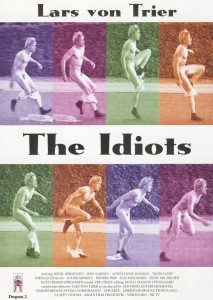 Lars von Trier, of course, thrives on such reactions. His aim is to disturb and unnerve, to stir the viewer out of his seat and out of his comfort zone. This is done not simply for the ‘shock value’ in itself, as there is no legitimate artistic worth in managing to provoke or enrage the audience; instead this is done in order to communicate something through the shocking material. By knocking the viewer out of his ordinary perspective, where everything is comfortably perceived and organized according to a familiar worldview, Lars von Trier can assault him with a new perspective, a new challenge that might threaten his old way of viewing reality.
Lars von Trier, of course, thrives on such reactions. His aim is to disturb and unnerve, to stir the viewer out of his seat and out of his comfort zone. This is done not simply for the ‘shock value’ in itself, as there is no legitimate artistic worth in managing to provoke or enrage the audience; instead this is done in order to communicate something through the shocking material. By knocking the viewer out of his ordinary perspective, where everything is comfortably perceived and organized according to a familiar worldview, Lars von Trier can assault him with a new perspective, a new challenge that might threaten his old way of viewing reality.
This is truer of The Idiots than any other LvT film, and that includes the psychological horror of Antichrist and the raw sexual trauma of Nymphomaniac. This is due to the highly abrasive nature of the film’s narrative, which tells the story of a group of people who act like they are mentally retarded as a form of rebellion against what they understand to be a constrictive, conformist, and sterilizing society. Their antics, which they call ‘spazzing,’ include going into town to sell Christmas ornaments that they have made, going to the pool to create mischief with the other swimmers, and eating at restaurants only to spazz and leave without paying.
It is during the last antic that the group comes into contact with Karen, a seemingly ordinary person who becomes drawn and intimately attached to the spazz community over the next two weeks. Karen initially provides the neutral perspective of the group, the backdrop of normality to their witting insanity; she is very curious, though, and constantly questions the reasoning behind their activities, allowing the viewer to get a keener understanding of what they do. She firstly represents the ignorant audience who nevertheless desire to know more, but later, as we will see, she represents the fulfilment of the ‘spazz way of life.’
The group is led by a man named Stoffer, who is clearly the one who takes their mission the most seriously, ostensibly giving it an ideological basis and a higher cause than merely acting like idiots. Karen asks Stoffer why they do what they do, and Stoffer replies, ‘In the stone age all the idiots died. It doesn’t have to be like that nowadays. Being an idiot is a luxury, but it is also a step forward. Idiots are the people of the future. If one can find the one idiot that happens to be one’s own idiot . . .’ Stoffer finds in idiocy an outlet for what bourgeois society has repressed or camouflaged, namely a kind of personal creativity that does not accord with social normalcy. It is a new freedom, one which was obviously unavailable in a more brutal time, but which is presently imperative in an era that prizes comfort, material luxury, and ostracizes everything that is not conducive to ‘making one’s way in the world,’ i.e., becoming rich and popular. Stoffer asks meaningfully, ‘What’s the idea of a society that gets richer and richer when it doesn’t make anyone happier?’ Stoffer’s idea is instead to make one happier regardless of riches.
The means of achieving this are chiefly to ‘find the one idiot that happens to be one’s own idiot,’ a demonstrably individualistic and interiorized path that cannot help but hearken back to the Dionysian nature of the Breaking the Waves heroine, Bess. The idea is to determine the other side of oneself, the side that society has dispelled and rejected from its embrace. It is in this sense that we are reminded of C. G. Jung’s conception of the ‘shadow,’ or the secret personality that is imbued with our darker elements, with everything that has been evicted from and cannot fit into conscious life. Stoffer’s aim is essentially to reconcile modern man with his shadow self in a radical way; he aims to reintegrate man with his inner darkness to create something that is once again whole, independent of outer definitions and social parameters. When one character wakes him up, telling him that another spazzer is breaking things on the property, Stoffer responds, ‘Sheds are bourgeois crap. Smashing windows is obviously part of Axel’s inner idiot.’ The smashing of windows is an act that is socially reprehensible, but, since it allegedly exists as part of Axel’s ‘inner idiot,’ his ‘shadow self,’ it is perfectly acceptable in spazzer society.
This opposition between consciousness and the shadow is present not only in the individual sense, where the characters play out this drama in themselves, but in the collective sense as well. What this means is that the bourgeoisie, which is invariably treated as a great evil and as something to be rebelled against, represents the conscious side, and the spazzer society represents the shadow side; they are the ‘reservoir of darkness’ that has spilled out from respectable society, and has come to life after society has failed to suppress it. They even use society’s own tools against it, inverting the logic of social machinations to serve immoral ends. In one scene, for example, Stoffer has one of the spazzers pretend to have tripped over a loose cobblestone near a well-to-do homeowner’s property, then pesters the man to pay them off in order to avoid a lawsuit. When the wealthy man asks whether the spazzer didn’t simply trip on his own rather than a loose stone, Stoffer answers, ‘Are you saying they drag their feet? that they are clumsy?,’ which forces the man to retreat, unwilling to be responsible for anything that might be considered ‘politically incorrect.’ Stoffer considers this to be a victory over the ‘fascist’ system that he hates, contemptuously gazing into its soul and mocking it.
There are other scenes, too, that reveal other ‘victorious’ moments against other, more typical members of society. The house where they are staying, for example, is that of Stoffer’s uncle, who has entrusted Stoffer to sell it. When he visits the house, he remarks that he take better care of it, saying that, ‘These floors have been waxed every day for fifty years,’ which of course exemplifies the hated bourgeois attitude. Later on, coming into possession of caviar, Stoffer shows his group how to ‘eat it the way they eat caviar in Soelleroed [their town],’ stuffing it into his mouth as though he were a child eating chocolate. Allured by the antics of her new friends, Karen also learns to spazz, and though she meaningfully does not participate to the same extent as the others, she says that, ‘We’re so happy here. I’ve no right to be so happy.’
II (Major Spoilers)
The ‘paradise’ of Soelleroed is largely an illusion, however, as the final third of the film reveals. It is in these segments that the real darkness of the shadow comes out, which altogether reflects the failure of Stoffer’s mission to reconcile it with their conscious lives. This is as manifest in Stoffer himself as in any of the others. In one scene, for instance, a city official arrives at the house to offer them a government grant and a new location where they might stay, somewhere that is further away from normal society and which therefore makes it harder for them to intrude upon normal people. Stoffer of course reacts violently to this, ripping off his clothes and chasing the official all the way back to town naked, screaming ‘Fascist! fascist!’ the whole time. The others drag him back to the house, but they have to physically restrain him, strapping him to a bed overnight as he has reverted to a purely irrational state, succumbing to an episode that was formerly merely an act.
Another character, too, after the girl he fell in love with is stolen away from the house by her father, chases after him, running into his car, gesturing wildly and speaking nonsense. Affected so deeply by his feeling for her, he is no longer able to bridge the gap between his conscious self and the primitive he used to play at but has now become reality. This is not a successful integration between consciousness and the shadow; this is the conquest of the former by the latter, resulting in the personality regressing to something animalistic and instinctual. Stoffer’s experimentation in human happiness has failed, because there is no longer anything human in his subjects.
There are more obvious instances of this darkness, too. After the night which Stoffer spends in straps, they have a party, and at the end of the party he requests a gangbang. Most of his fellows willingly participate, but some do not; this leads Stoffer and another to chase one of the unwilling women down, essentially raping her in a violently disturbing scene of spazz sex. It is significant that Karen retreats from this scene altogether, abstaining from the evil that has infiltrated the rest of the ‘shadow group.’ It is even more significant that she is not raped, for she has maintained her own sense of self in contradistinction to the others; her personality is still intact while those of the others have been overwhelmed and utterly ransacked of their humanity.
Nearing the end of the film, Stoffer comes to doubt the sincerity of his fellow idiots, suspecting that this is all just some sort of game to them. He orders them to play ‘spin the bottle,’ with whomever the bottle points at having to demonstrate his commitment to the cause by spazzing in ‘real life’ places such as at work or at home with the wife and kids. The first fails completely, refusing to spazz in front of his family; he elects a normal life instead of the idiot life and the mistress he kept among them. The second opts to spazz in front of an art class he will be teaching, but he fails as well, causing Stoffer to storm out of the class, saying, ‘You love this middle class crap. These old dames use more make-up than the national theatre.’ The teacher, Henrik, says, ‘I had no pride in my inner idiot.’ The shadow self was just an illusion for them, something to play at in an insubstantial expression of inward identity.
Stoffer himself comes no closer to the reconciliation between the shadow and the ego. Instead of being the romantic and anarchic hero revolting against the oppressive bourgeois system that he likes to consider himself, he is infact a representation of it in its inverted sense; he is the ‘other side of the same coin,’ reflecting the absence of a genuine morality that extends to both the ‘middle class’ and the bohemian individualism. His ethos is fundamentally the same as that of his bourgeois uncle: ‘In reality, the acceptance of the shadow-side of human nature verges on the impossible. Consider for a moment what it means to grant the right of existence to what is unreasonable, senseless, and evil! Yet it is just this that the modern man insists upon. He wants to live with every side of himself — to know what he is. That is why he casts history aside. He wants to break with tradition so that he can experiment with his life and determine what value and meaning things have in themselves, apart from traditional presuppositions’ (C. G. Jung, ‘Psychotherapists or the Clergy’).
Stoffer is the epitome of the ‘modern man’ in that he wants to throw off all social inhibitions, not merely those of the 20th Century middle class, but the entire framework of human society. His revolt is the same as the student and hippy revolts of the sixties, revolts which were ultimately codified into the same bourgeois vassals that they originally reacted against. This is what makes Stoffer the superficial counterpart to the bourgeoisie; this is what makes him its useful idiot.
Karen is the only one who volunteers to spazz in her own life. Taking along her friend Suzanne for company, Karen returns to her home, somewhere she has not been for two weeks. We soon learn that her son had died, and that her son’s funeral was the day after she joined the group. Her husband comes home, and they sit down to eat – and Karen drools and dribbles at her food, which causes her family to stare, and her husband to hit her. Suzanne takes her hand, and they leave together, smiling naively, innocently.
Earlier in the film, Karen says to Stoffer, ‘I just want to be able to understand why I’m here,’ to which he replies, ‘Perhaps because there is a little idiot in there that wants to come out and have some company.’ While that is true in a certain, limited sense, it is truer to say that Karen’s ‘little idiot’ needed to come out to save her conscious self. Besieged by an impossible grief and a mother’s mourning, Karen’s ego longed for an escape route from the world’s immense difficulty. That she alone found it amongst all the idiots testifies both to the extent of her trauma and her extraordinary capability of dealing with it; she alone could make real sense of what the idiots were only playing at. Their reactions (aside from Stoffer, who was overcome by his own shadow) were conditioned by their belonging to the bourgeois order, something from which they recoiled in theory, but which they nevertheless could not do without; Karen’s reaction, on the other hand, was conditioned by a more profound disorder, which demanded an extreme process in order to be able to cope with it. Her struggle was far more real than that of the others, which is why she was the only one to find the solution to it.
The Idiots reveals both the positive and the negative scenarios that are the consequence of a Dionysiac revolt against the Apollonian dream-world. In order to ‘revolt successfully,’ to truly indulge in Dionysian fruit, the individual’s actions must be founded on something universally real that transcends particular circumstances; he must determine himself based on who he really is rather than merely a perception or a projection of who he is. This is where most of the idiots failed: ‘The shadow is a moral problem that challenges the whole ego-personality, for no one can become conscious of the shadow without considerable moral effort. To become conscious of it involves recognizing the dark aspects of the personality as present and real. This act is the essential condition for any kind of self-knowledge’ (C. G. Jung, Aion). The idiots never really became conscious of their shadow; they acted it out either as a meaningless game that allowed them an illusion of rebellion against their bourgeois lives, or, in the case of Stoffer, as a license to perform whatever irrational and pernicious acts that occurred to him, as long as they did not agree with the prevailing social order. They never addressed the shadow as a ‘moral problem,’ as something that directly influences the person; they addressed it as a ‘social problem,’ and thus remained chained to the illusions of Apollo’s dream-world.
Karen alone represents Dionysus as the purveyor of dynamic, uninhibited truth. She refused the moral violations of the other idiots, she refused their pretensions of abandoning society, and she refused their needless and unlawful interdictions with the rest of the town; in a word, Karen rejected rejection, and she did so because her rebellion was founded on an affirmation of self rather than on its negation. Unlike Stoffer, who loses control when he is confronted with that which he hates and fears most (the bourgeois city official), Karen maintains perfect control as she releases her inner idiot in front of her family, again exemplifying a personal command that eluded the others.
Speaking of her return home, where she demonstrates her restored personal strength, she says to the idiots, ‘We’ll see if I can show you if it has all been worthwhile.’ This follows a farewell in which Karen expresses an open, authentic love for many of the idiots, and repeats her avowal of happiness to have been amongst them. Karen’s family, cold, unfeeling, and uncomprehending of what it must be for a mother to lose her son, failed to ease her grief; it was only in her introspection, the confrontation with her ‘inner idiot’ as a lifeboat that carries her from the drowning ego, that actually saves the ego. By acknowledging her despair in this radical context, she could dilute and eventually sublimate it into something far more positive, to the extent that, all things considered, she does not even know why or how she can be so happy. In this sense, the freedom of Dionysus is attained not as a rejection of Apollo, but as a victorious affirmation of the reconciliation between the unconscious and the conscious; while the rest of the idiots founded their shadow-search on a rejection of Apollo, Karen had to be rejected by him instead. This is what led to her final freedom; this is what made it all worthwhile.
Article printed from Counter-Currents Publishing: http://www.counter-currents.com
URL to article: http://www.counter-currents.com/2015/08/lars-von-triers-the-idiots/
URLs in this post:
[1] Image: https://secure.counter-currents.com/wp-content/uploads/2015/08/TheIdiots.jpg
00:05 Publié dans Cinéma, Film | Lien permanent | Commentaires (0) | Tags : lars von trier, cinéma, film, danemark |  |
|  del.icio.us |
del.icio.us |  |
|  Digg |
Digg | ![]() Facebook
Facebook
dimanche, 26 avril 2015
Pasolini : le chant de l’abyme

Pasolini: le chant de l’abyme
« Scandaliser est un droit. Être scandalisé est un plaisir. Et le refus d’être scandalisé est une attitude moraliste. »
Devant le journaliste français qui l’interroge, Pier Paolo Pasolini ne mâche pas ses mots. Il ne l’a jamais fait. Il vient de terminer Salo ou les 120 journées de Sodome. Le lendemain, il sera mort. C’est ainsi que débute le beau film qu’Abel Ferrara a consacré à cet homme qui paya de sa vie son droit sacré au blasphème moderne.
Rassurons d’emblée ceux que les biopics convenus lassent ou exaspèrent : le film de Ferrara n’a pas l’ambition, ni la volonté, d’embrasser toute la vie du poète italien de façon linéaire. Son récit se concentre sur les derniers jours de sa vie, comme si ces ultimes instants recelaient en eux-mêmes toute sa puissance tragique et artistique.
Alternant les scènes de vie familiale avec les interviews politiques, Ferrara s’aventure également, à la manière des récits en cascade des Mille et une nuits, dans le champ de l’imaginaire en illustrant son roman inachevé Pétrole et les premières esquisses du film Porno-Teo-Kolossal racontant le voyage d’Epifanio et de son serviteur Nunzio à travers l’Italie à la recherche du Paradis, guidés par une comète divine. Enchâssant la fiction dans la réalité (et même la fiction dans la fiction), Ferrara trace une ligne de vie viscérale entre Pasolini et ses œuvres : « Pasolini n’était pas un esthète, mais un avant-gardiste non inscrit, affirme Hervé Joubert-Laurencin. Il n’a pas vécu sa vie comme un art mais l’art comme une vie, il n’était pas « décadentiste » mais « réaliste », il n’a pas « esthétisé la politique » mais « politisé l’art ». »
Et sa voix politique, frontale mais toujours respectueuse, a eu un retentissement phénoménal dans les années 1960/1970 en Italie et en Europe, en se heurtant au conservatisme politique et au puritanisme moral. La beauté de son cinéma politique résidait dans le regard cru qu’il portait sur les choses, notamment les plus triviales. Devant sa caméra elles ne se transformaient pas en verbiage théorique. Les choses restaient des choses, d’un réel trop éclatant, trop beau, trop vrai : « Je n’ai pas honte de mon « sentiment du beau ». Un intellectuel ne saurait être qu’extrêmement en avance ou extrêmement en retard (ou même les deux choses à la fois, ce qui est mon cas). C’est donc lui qu’il faut écouter : car la réalité dans son actualité, dans son devenir immédiat, c’est-à-dire dans son présent, ne possède que le langage des choses et ne peut être que vécue. » (Lettres luthériennes)
Vent debout face à la houle
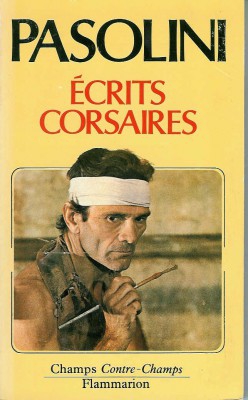 Pasolini était un homme du refus. Mais pas circonstancié et tiède : « Pour être efficace, le refus ne peut être qu’énorme et non mesquin, total et non partiel, absurde et non rationnel. » (Nous sommes tous en danger) C’est tout ou rien. Pasolini était CONTRE. Contre la droite cléricale-fasciste et démocrate-chrétienne mais aussi contre les illusions de son propre camp, celui du gauchisme (cette « maladie verbale du marxisme ») et de ses petit-bourgeois d’enfants.
Pasolini était un homme du refus. Mais pas circonstancié et tiède : « Pour être efficace, le refus ne peut être qu’énorme et non mesquin, total et non partiel, absurde et non rationnel. » (Nous sommes tous en danger) C’est tout ou rien. Pasolini était CONTRE. Contre la droite cléricale-fasciste et démocrate-chrétienne mais aussi contre les illusions de son propre camp, celui du gauchisme (cette « maladie verbale du marxisme ») et de ses petit-bourgeois d’enfants.
Il était contre les belles promesses du Progrès qui font s’agenouiller les dévots de la modernité triomphante, ces intellos bourgeois marchant fièrement dans un « sens de l’Histoire » qu’ils supposent inéluctable et forcément bénéfique. « La plupart des intellectuels laïcs et démocratiques italiens se donnent de grands airs, parce qu’ils se sentent virilement « dans » l’histoire. Ils acceptent, dans un esprit réaliste, les transformations qu’elle opère sur les réalités et les hommes, car ils croient fermement que cette « acceptation réaliste » découle de l’usage de la raison. […] Je ne crois pas en cette histoire et en ce progrès. Il n’est pas vrai que, de toute façon, l’on avance. Bien souvent l’individu, tout comme les sociétés, régresse ou se détériore. Dans ce cas, la transformation ne doit pas être acceptée : son « acceptation réaliste » n’est en réalité qu’une manœuvre coupable pour tranquilliser sa conscience et continuer son chemin. C’est donc tout le contraire d’un raisonnement, bien que souvent, linguistiquement, cela en ait l’air. […] Il faut avoir la force de la critique totale, du refus, de la dénonciation désespérée et inutile. » (Lettres luthériennes)
« Les saints, les ermites, mais aussi les intellectuels, les quelques personnes qui ont fait l’histoire sont celles qui ont dit « non« , et pas les courtisans ou les assistants des cardinaux. »
C’est aussi son rejet de la nouvelle langue technique qui aplatit tout sur son passage, écrasant les particularismes culturels et linguistiques, réduisant en poussière le discours humaniste et faisant du slogan le nouveau port-étendard d’un monde mort sur lequel l’individu narcissique danse jusqu’à l’épuisement. Et la gauche, qui ne veut pas rester hors-jeu, s’engouffre dans cette brèche en prêtant allégeance à la civilisation technologique, croyant, de façon arrogante, qu’elle apportera Salut et Renouveau sans percevoir qu’elle détruit tout sentiment et toute fierté chez l’homme. Les regrets pointent : « L’individu moyen de l’époque de Leopardi pouvait encore intérioriser la nature et l’humanité dans la pureté idéale objectivement contenue en elles ; l’individu moyen d’aujourd’hui peut intérioriser une Fiat 600 ou un réfrigérateur, ou même un week-end à Ostie. » (Écrits corsaires)
Si Pasolini était épris de cette belle passion triste qu’est la nostalgie, c’était non pas celle, réactionnaire, d’un Âge d’or fantasmé, mais celle d’une époque où le peuple avait le sens de la mesure, la dignité chevillée au corps et le ventre plein. Celle d’une Italie créatrice et glorieuse. Quand les petites gens n’avaient pas la pauvre ambition de devenir les puissants qu’ils combattaient : « J’ai simplement la nostalgie des gens pauvres et vrais, qui se battaient pour renverser ce patron, mais sans vouloir pour autant prendre sa place ! Puisqu’ils étaient exclus de tout, personne ne les avait même colonisés. […] Dis-moi, maintenant, si le malade qui songe à sa santé passée est un nostalgique, fût-il idiot ou misérable avant d’être atteint ? » (Nous sommes tous en danger) Quelque chose d’humain semble fini et Pasolini pleure un monde en ruine.
L’abrutissement de masse du monde bourgeois
Ferrara filme Pasolini comme le dernier homme d’une Terre dévastée, cette Italie tant aimée et tant haïe. L’ultime représentant d’une Humanité désormais asservie par l’aliénation de la mentalité bourgeoise qui dépasse le cadre de la classe sociale. « Par bourgeoisie, je n’entends pas tant une classe sociale qu’une pure et simple maladie. Une maladie très contagieuse ; c’est si vrai qu’elle a contaminé presque tous ceux qui la combattent, des ouvriers du Nord aux ouvriers immigrés du Sud, en passant par les bourgeois d’opposition, et les « solitaires » (comme moi). Le bourgeois – disons-le par un mot d’esprit – est un vampire, qui n’est pas en paix tant qu’il n’a pas mordu le cou de sa victime pour le pur plaisir, naturel et familier, de la voir devenir pâle, triste, laide, sans vie, tordue, corrompue, inquiète, culpabilisée, calculatrice, agressive, terrorisante, comme lui. » (Contre la télévision)
 La télévision étant, pour lui, le bras armé de cette aliénation de masse. « La télévision, loin de diffuser des notions fragmentaires et privées d’une vision cohérente de la vie et du monde, est un puissant moyen de diffusion idéologique, et justement de l’idéologie consacrée de la classe dominante. » (Contre la télévision) Pasolini découvre, horrifié, la propagande moderne du divertissement de masse dont la bêtise n’a d’égale que la vulgarité, sous couvert d’un manichéisme moral mis au goût du jour : « Il émane de la télévision quelque chose d’épouvantable. Quelque chose de pire que la terreur que devait inspirer, en d’autres siècles, la seule idée des tribunaux spéciaux de l’Inquisition. Il y a, au tréfonds de ladite « télé », quelque chose de semblable, précisément, à l’esprit de l’Inquisition : une division nette, radicale, taillée à la serpe, entre ceux qui peuvent passer et ceux qui ne peuvent pas passer. […] Et c’est en cela que la télévision accomplit la discrimination néo-capitaliste entre les bons et les méchants. Là réside la honte qu’elle doit cacher, en dressant un rideau de faux « réalismes ». » (Contre la télévision)
La télévision étant, pour lui, le bras armé de cette aliénation de masse. « La télévision, loin de diffuser des notions fragmentaires et privées d’une vision cohérente de la vie et du monde, est un puissant moyen de diffusion idéologique, et justement de l’idéologie consacrée de la classe dominante. » (Contre la télévision) Pasolini découvre, horrifié, la propagande moderne du divertissement de masse dont la bêtise n’a d’égale que la vulgarité, sous couvert d’un manichéisme moral mis au goût du jour : « Il émane de la télévision quelque chose d’épouvantable. Quelque chose de pire que la terreur que devait inspirer, en d’autres siècles, la seule idée des tribunaux spéciaux de l’Inquisition. Il y a, au tréfonds de ladite « télé », quelque chose de semblable, précisément, à l’esprit de l’Inquisition : une division nette, radicale, taillée à la serpe, entre ceux qui peuvent passer et ceux qui ne peuvent pas passer. […] Et c’est en cela que la télévision accomplit la discrimination néo-capitaliste entre les bons et les méchants. Là réside la honte qu’elle doit cacher, en dressant un rideau de faux « réalismes ». » (Contre la télévision)
Mais cet avilissement général est aussi de la responsabilité des hommes politiques qui acceptent tacitement de voir leur parole simplifiée, leur image dégradée, leur rôle discrédité. « L’écran de télévision est la terrible cage de l’Opinion publique – servilement servie pour obtenir un asservissement total – qui tient prisonnière toute la classe dirigeante italienne : la mèche blanche d’Aldo Moro, la jambe courte de Fanfani, le nez retroussé de Rumor, les glandes sébacées de Colombo, sont un spectacle représentatif qui tend à spoiler l’humanité de toute humanité. » (Contre la télévision)
C’était vrai du temps de Pasolini, ça l’est encore plus de nos jours. Un simple coup d’œil sur la prodigieuse machine consensuelle à fabriquer du bouffon qu’est Le Grand Journal de Canal + suffit à s’en convaincre. Un bref regard sur un quelconque programme de télé-réalité dont le but, toujours le même, est d’humilier les participants en flattant le spectateur suscite le dégoût.
Pour le romancier italien, seule une prise du conscience des téléspectateurs, un sursaut salvateur du peuple, contre cet instrument mesquin et vulgaire permettra de sortir le pays de sa torpeur générale. Il ne se faisait pourtant guère d’illusion : « Quand les ouvriers de Turin et de Milan commenceront à lutter aussi pour une réelle démocratisation de cet appareil fasciste qu’est la télé, on pourra réellement commencer à espérer. Mais tant que tous, bourgeois et ouvriers, s’amasseront devant leur téléviseur pour se laisser humilier de cette façon, il ne nous restera que l’impuissance du désespoir. » (Contre la télévision)
Le fascisme au carré de la société de consommation
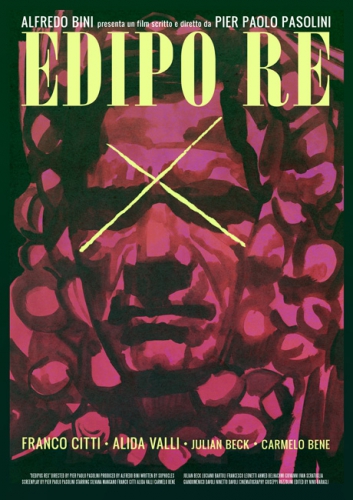 Si le fascisme avait détruit la liberté des hommes, il n’avait pas dévasté les racines culturelles de l’Italie. Réussissant le tour de force de combiner l’asservissement aux modes et aux objets à la destruction de la culture ancestrale de son pays, le consumérisme lui apparut comme, pire que le fascisme, le véritable mal moderne à combattre. Un mal qui s’est immiscé dans le comportement de tous les Italiens avec une rapidité folle : en l’espace de quelques années, l’uniformisation était telle qu’il était désormais impossible de distinguer, par exemple, un fasciste d’un anti-fasciste. Il n’y a plus que des bourgeois bêtes et vulgaires dans un pays dégradé et stérile.
Si le fascisme avait détruit la liberté des hommes, il n’avait pas dévasté les racines culturelles de l’Italie. Réussissant le tour de force de combiner l’asservissement aux modes et aux objets à la destruction de la culture ancestrale de son pays, le consumérisme lui apparut comme, pire que le fascisme, le véritable mal moderne à combattre. Un mal qui s’est immiscé dans le comportement de tous les Italiens avec une rapidité folle : en l’espace de quelques années, l’uniformisation était telle qu’il était désormais impossible de distinguer, par exemple, un fasciste d’un anti-fasciste. Il n’y a plus que des bourgeois bêtes et vulgaires dans un pays dégradé et stérile.
La longue plainte de Pasolini est celle d’un homme qui assiste, impuissant, au génocide culturel de son pays : « Aucun centralisme fasciste n’est parvenu à faire ce qu’a fait le centralisme de la société de consommation. Le fascisme proposait un modèle réactionnaire et monumental, mais qui restait lettre morte. Les différentes cultures particulières (paysannes, sous-prolétariennes, ouvrières) continuaient imperturbablement à s’identifier à leurs modèles, car la répression se limitait à obtenir leur adhésion en paroles. De nos jours, au contraire, l’adhésion aux modèles imposés par le centre est totale et inconditionnée. On renie les véritables modèles culturels. L’abjuration est accomplie. On peut donc affirmer que la « tolérance » de l’idéologie hédoniste voulue par le nouveau pouvoir est la pire des répressions de toute l’histoire humaine. » (Écrits corsaires)
L’injonction hédoniste et la fausse tolérance ont également souillé la naïveté des cœurs tendres. Les hommes et les femmes sont devenus des machines se fracassant les unes contre les autres. « Le consumérisme a définitivement humilié la femme en créant d’elle un mythe terroriste. Les jeunes garçons qui marchent presque religieusement dans la rue en tenant, d’un air protecteur, une main sur l’épaule de la jeune fille, ou en lui serrant romantiquement la main, font rire ou bien serrent le cœur. Rien n’est plus insincère qu’un tel rapport réalisé concrètement par le couple de la société de consommation. » (Lettres luthériennes) La fausse libération sexuelle est en réalité une obligation sociale, créant un désarroi chez ceux qui ne se conforment pas à la panoplie du parfait petit consommateur de corps. Le couple est désormais maudit.
« Je sais qu’en tapant toujours sur le même clou, on peut arriver à faire s’écrouler une maison. »
Pasolini refuse ce bonheur factice dont l’unique cause est la satisfaction immédiate des besoins matériels, l’achat compulsif et jovial dans une société au bord du gouffre, la grande fête des magasins accueillants : « Tout le monde est malin et, par conséquent, tout le monde a sa bonne tête de malheureux. Être malin est le premier commandement du pouvoir de la société de consommation : être malin pour être heureux (hédonisme du consommateur). Résultat : le bonheur est entièrement et totalement faux, alors que se répand de plus en plus un malheur immédiat. » (Lettres luthériennes)
Le crépuscule d’un homme haï par tous
« Je suis complètement seul. Et, de plus, entre les mains du premier qui voudra me frapper. Je suis vulnérable. Soumis à tous les chantages. Je bénéficie peut-être, c’est vrai, d’une certaine solidarité, mais elle est purement virtuelle. Elle ne peut m’être d’aucune aide dans les faits. » (Contre la télévision) Prophète de sa propre destinée, Pasolini a succombé à la haine de ses contemporains.
Il fut assassiné la nuit du 1er au 2 novembre 1975 sur la plage d’Ostie, près de Rome, par une bande de misérables lâches, ces « ragazzi di vita », héros de ses romans et de ses films, qu’il côtoyait régulièrement. Assassiné par ceux qu’il aimait. Ferrara, qui a toujours été fasciné par la chute des figures mythiques, ne nous épargne pas la cruauté de ces derniers instants d’horreur. Ceux d’un homme battu à mort parce que porteur de la marque infamante du scandale. Il avait 53 ans.
À la suite de cette ignominie, certains n’hésitèrent pas à brandir cette justification puante selon laquelle « il l’avait bien cherché, ce sale PD ». Une excuse d’assassins que, sous couvert d’un puritanisme moral, on entend encore de nos jours pour justifier les pires crimes (viols, lynchages ou attentats). Pour légitimer la violence physique des bourreaux, il faut commencer par accuser « la violence symbolique » et « oppressante » des victimes. Soit la barbarie qui considère, in fine, le meurtre comme une réponse appropriée à un poème, un film ou un dessin. Une perte de sens de la mesure ahurissante. Une logique proprement fasciste.
Profondément pessimiste, Pasolini était descendu en Enfer, au-delà de l’horizon, et nous avait mis en garde : « Je ne crois pas que l’homme puisse être libre. Il ne faut jamais rien espérer : l’espérance est une chose horrible que les partis ont inventée pour garder leurs militants. » Mais il a paradoxalement chanté le plus beau des conseils à Gennariello dans ses Lettres luthériennes, celui qui mérite notre attention en tout lieu et en tout temps, celui qui fait danser la grâce avec la rage : « Ne te laisse pas tenter par les champions du malheur, de la hargne stupide, du sérieux joint à l’ignorance. Sois joyeux. »
Nos desserts :
- La dernière interview de Pasolini, sur Ballast
- Vidéo : fascisme et société de consommation
- Documentaire : Enquête sur l’assassinat de Pasolini
- Émission INA : Pier Paolo Pasolini : une vitalité désespérée
- Film La Ricotta
- Film L’Évangile selon saint Matthieu
- Extrait du film Salo ou les 120 journées de Sodome
00:05 Publié dans Biographie, Cinéma, Hommages | Lien permanent | Commentaires (0) | Tags : pier paolo pasolini, cinéma, film, italie |  |
|  del.icio.us |
del.icio.us |  |
|  Digg |
Digg | ![]() Facebook
Facebook
vendredi, 13 mars 2015
Le dernier loup: le grand retour de l'éthologie
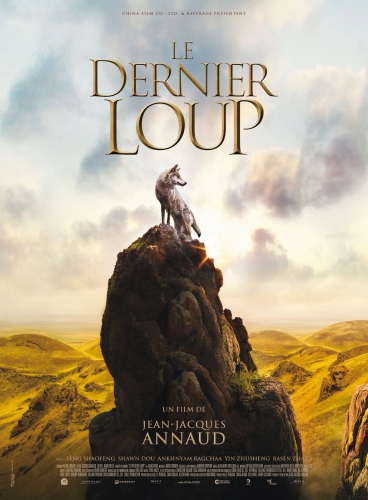
Jean Ansar
Ex: http://metamag.fr
Le dernier film de Jean jacques Annaud renoue avec ce qui fait l'originalité et le succès de cet immense cinéaste français. Il fera vite oublier le médiocre "Or noir" et viendra rappeler le souffle de "L’ours", des "Deux frères", de "La guerre du feu", du "Nom de la rose" ou de "7 ans au Tibet".
Le souffle de la vie et la beauté des images sont au rendez vous de ce "Dernier loup", film franco-chinois qui est une ode aux peuples premiers, en l’occurrence aux mongols et à leur conception du monde. Un peuple dont le dieu totem est le loup. Gengis khan, le plus grand conquérant du monde, a adapté la stratégie de la meute dans son art militaire.
L’histoire est classique
C’est un « eastern » où le loup joue le rôle du bison et l'administration communiste celui de l'homme ennemi de la nature et des mongols, ces autres indiens. 1969, Chen Zhen, un jeune étudiant originaire de Pékin, est envoyé en Mongolie Intérieure afin d'éduquer une tribu de bergers nomades. Mais c'est véritablement Chen qui a beaucoup à apprendre, sur la vie dans cette contrée infinie, hostile et vertigineuse, sur la notion de communauté, de liberté et de responsabilité, et sur la créature la plus crainte et vénérée des steppes, le loup. Séduit par le lien complexe et quasi mystique entre ces créatures sacrées et les bergers, il capture un louveteau afin de l'apprivoiser. Mais la relation naissante entre l'homme et l'animal ainsi que le mode de vie traditionnel de la tribu et l'avenir de la terre elle-même, est menacée lorsqu'un représentant régional de l'autorité centrale décide par tous les moyens d'éliminer les loups de cette région.
Cela étant ce film n’est pas manichéen et l’administrateur chinois ne veut que le bien des mongols par le progrès et il détruit avec bonne conscience un équilibre naturel fragile. Le loup lui-même est cruel, le louveteau mord la main qui le nourrit et la meute est impitoyable pour les ruminants.
C’est un grand film éthologiste sur les rapports des animaux entre eux, des animaux et des hommes, sur le comportement et l'agressivité comme ressort de la survie. Les écologistes n’aimeront pas ce film, trop brutal et sanglant pour leur exquise sensibilité. Leur monde est celui où le loup mongol cohabiterait avec le mouton chinois. Mais le mongol comme le loup sait que, s’il renonce à sa cruauté vitale, il disparaîtra mais ne deviendra pas mouton. Il n’y a pas de théorie du genre dans la vraie vie.
L'Éthologie : apprendre la vie
Ce film devrait plus que d’autres relancer l'intérêt pour cette science formidable mais souvent ignorée pour des motifs politiciens qu’est l’Éthologie. Le terme "éthologie" signifie étymologiquement « étude des mœurs ». Ce domaine, sous le nom générique, englobe surtout l'étude du comportement animal tel qu'il peut être observé chez l'animal sauvage ou domestiqué, dans son milieu naturel ou en captivité. L'éthologie humaine quitte le champ d'investigation des spécialistes de l'instinct animal pour décrire le comportement individuel et collectif. Il faut inclure dans cette signification l'étude comportementale des êtres humains et des relations homme-animal. L'éthologie se définit originellement comme l'étude des comportements instinctifs puis, actuellement, plus généralement, comme la biologie du comportement.

Le plus célèbre des éthologistes est Konrad Lorenz. Il a popularisé l'éthologie dans des livres admirables, mais voilà il n’est pas politiquement correct. Konrad Lorenz, est un biologiste et zoologiste autrichien titulaire du prix Nobel de physiologie ou médecine. Lorenz a étudié les comportements des animaux sauvages et domestiques. Il a écrit des livres qui ont touché un large public tels que "Il parlait avec les mammifères", "les oiseaux et les poissons" ou "L'Agression, une histoire naturelle du mal". En 1940, il devient professeur à l'université de Königsberg où il occupe la chaire d'Emmanuel Kant. Il est mobilisé en 1941 dans l'armée comme médecin psychiatre et fait prisonnier par les Russes en 1944 puis déporté en Arménie soviétique jusqu'en 1948. Dans ses travaux ultérieurs, Lorenz se servira de cette expérience (enthousiasme nationaliste et constat des dégâts du lavage de cerveaux chez les allemands nazifiés et les russes communisés) pour élaborer une critique des dérives de l'instinct d'agression chez l'homme, de la psychologie de l'endoctrinement et du danger de celui-ci.
De 1949 à 1951, il dirige l'institut d'éthologie comparée d'Altenberg puis l'Institut Max Planck de physiologie comportementale (un des 80 instituts de recherche de la Société Max-Planck) de Buldern (1951-1954) puis celui de Seewiesen (Bavière) (1954). Il reçoit en 1973, conjointement avec Karl von Frisch et Nikolaas Tinbergen, le prix Nobel de physiologie ou médecine pour leurs découvertes concernant « l'organisation et la mise en évidence des modes de comportement individuel et social » ; il s'agit du seul prix Nobel jamais remis à des spécialistes du comportement. Leurs travaux constituent les fondements d'une nouvelle discipline de la biologie : l'éthologie.
Devenu humaniste et écologiste, il est cependant diabolisé
Konrad Lorenz fut membre du parti nazi à partir de 1938. Eugéniste, il fut également membre du « département de politique raciale » du parti, produisant conférences et publications. Adoptant pleinement l'idéologie nazie il écrivit, par exemple, dans une lettre à Oskar Heinroth, lors de la déclaration de guerre de la Grande Bretagne à l'Allemagne : « Du pur point de vue biologique de la race, c'est un désastre de voir les deux meilleurs peuples germaniques du monde se faire la guerre pendant que les races non blanches, noire, jaune, juive et mélangées restent là en se frottant les mains» . La controverse publique sur l'affiliation de Konrad Lorenz au parti nazi prit naissance lors de sa nomination pour le prix Nobel. Cette controverse porta sur un article publié dans le Journal de psychologie appliquée et d'étude du caractère (Zeitschrift für angewandte Psychologie und Charakterkunde) en 1940, « Désordres causés par la domestication du comportement spécifique à l'espèce » (Durch Domestikation verursachte Störungen arteigenen Verhaltens). Cet article fut publié dans un contexte de justification scientifique de restrictions légales contre le mariage entre Allemands et non Allemands. Jamais Lorenz ne cacha cette publication, il la cita abondamment et il reprit ces idées dans la plupart de ses livres. Il y développe le concept de l'auto-domestication de l'homme, soit que la pression de sélection de l'homme par l'homme aurait conduit à une forme de dégénérescence de l'espèce humaine dont les plus touchées sont les races occidentales. Les souches primitives étant celles qui ont été épargnées par cette dégénérescence.

Il s'agit d'un article foncièrement anti-suprémaciste aryen. Cette publication lui retira toute possibilité d'une carrière politique et signa son abandon de tout contact avec la vie politique. Il dit à ce propos: « L'essai de 1940 voulait démontrer aux nazis que la domestication était beaucoup plus dangereuse que n'importe quel prétendu mélange de races. Je crois toujours que la domestication menace l'humanité ; c'est un très grand danger. Et si je peux réparer, rétrospectivement, l'incroyable stupidité d'avoir tenté de le démontrer aux nazis, c'est en répétant cette même vérité dans une société totalement différente mais qui l'apprécie encore moins. »
Ce fut le style de cet article, adoptant un ton délibérément politique et non scientifique, publié dans un contexte de haine raciale que les détracteurs de Lorenz soulevèrent. La remise du prix Nobel à Lorenz entraîna un grand remous dans la communauté des sciences humaines, en particulier au sein de l'école de behaviorisme américain. Le long combat que Lorenz fit contre les théories de cette école, sur les comportements innés et acquis, lui valut beaucoup d'ennemis. Notons, entre autres, l'article de Lehrman de 1953, dans Quarterly Review of Biology : « Une critique de la théorie du comportement instinctif de Konrad Lorenz » citant le caractère et les origines « nazis » des travaux de celui-ci qui démarra la guerre.
La controverse au sujet de l'article de 1940 prit véritablement racine après la publication dans Sciences en 1972 d'un discours prononcé au Canada par Léon Rosenberg, de la faculté de médecine de Harvard, et la publication par Ashley Montagu, un anthropologue opposé à la théorie des instincts de l'homme de Lorenz, de la conférence d'Eisenberg : « La nature humaine de l'homme ». Dans cette conférence, l'article de 1940 est critiqué comme s'il s'agissait d'un article à caractère scientifique et actuel. Il s'agit d'une demie-page (sur plus de 70) des pires passages politiques cités hors contexte et se terminant par : « Nous devons - et nous le ferons - compter sur les sentiments sains de nos meilleurs éléments pour établir la sélection qui déterminera la prospérité ou la décadence de notre peuple… ».
Si cette dernière proposition semble prôner un eugénisme nazi, l'affirmation que les meilleurs éléments ne sont pas nécessairement « aryens » et donc que certains devraient céder leur place à des représentants d'autres races, était totalement suicidaire à l'époque. Lorenz laisse sous entendre, dans sa biographie, qu’il fut mobilisé lors de la guerre germano-soviétique et envoyé sur le front de l'est pour cette raison.
Les médias s'emparèrent de ce scandale et le montèrent en épingle. Lorenz fut alors présenté comme un partisan pro-nazi. ….. Le mal absolu n’allait pas épargner l’éthologie. Les rapports avec les animaux, d’Alain de Benoist à Franz olivier Giesbert, sont de nouveaux d'actualité. L'éthologie devrait reprendre tout sa place, sans occulter le travail de Lorenz, qui aurait aimé ce « dernier loup ».
00:05 Publié dans Cinéma, Film | Lien permanent | Commentaires (0) | Tags : cinéma, film, 7ème art, jean-jacques annaud, le dernier loup, loups, konrad lorenz, éthologie, biologie |  |
|  del.icio.us |
del.icio.us |  |
|  Digg |
Digg | ![]() Facebook
Facebook
mardi, 17 février 2015
Cinquante nuances de Grey, ou le nouvel opium du peuple
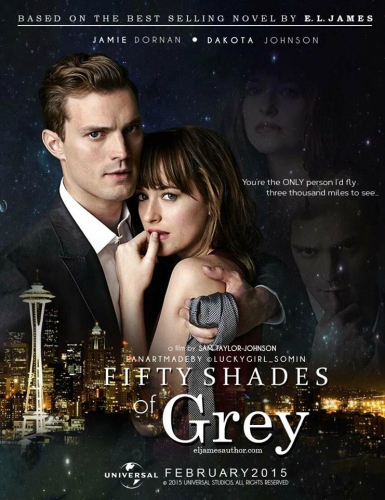
La manipulation des opinions, c’est-à-dire des peuples, c’est une affaire d’opium, d’opium du peuple. Il y a les grandes manipulations et les petites manipulations qui sont parfois plus grandes qu’on ne le croit. Jugez-en.
En France, traditionnellement et comme chacun sait, l’opium du peuple, c’était la religion, catholique et quasi absolue. La lutte contre cet opium-là est séculaire dans notre beau pays. Pour faire simple, le premier assaut fut la Réforme, suivie du cortège des guerres de religion. Le siècle de Louis XIV et la Contre-Réforme furent des réponses politique et religieuse vigoureuses. Mais un nouvel assaut se préparait, les Lumières du XVIIIe siècle, encyclopédistes et autres francs-maçons. On en connaît le couronnement, la « Grande Révolution », comme disent encore ses fidèles.
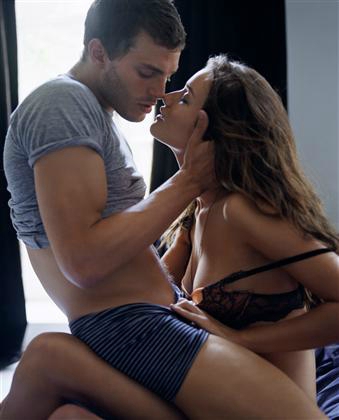 De soubresaut en soubresaut, de rémission (Napoléon) en nouvel accès de fièvre (la Commune), notre « opium » des peuples de France s’enlise, se délite, se désagrège, se décompose, se métamorphose. Péguy et tant d’autres n’y pourront rien. Un grand coup lui est porté par la loi de séparation de l’Église et de l’État en 1905.
De soubresaut en soubresaut, de rémission (Napoléon) en nouvel accès de fièvre (la Commune), notre « opium » des peuples de France s’enlise, se délite, se désagrège, se décompose, se métamorphose. Péguy et tant d’autres n’y pourront rien. Un grand coup lui est porté par la loi de séparation de l’Église et de l’État en 1905.
Depuis, et sans porter atteinte aux espoirs des croyants, ni dénigrer leur foi séculaire, laquelle fait partie de mon identité, j’observe un haut clergé de France pour le moins frileux, pour ne pas dire maso. Il ne fait plus rêver, il ne distille plus l’opium du peuple. Parle-t-il encore de Lui ?
Alors, vers quel paradis se tournent certains de nos compatriotes ? Vers les Cinquante nuances de Grey.
C’est une petite histoire commencée en 68, libération sexuelle, peace and love. On continue avec l’essor spectaculaire du porno (Emmanuelle), qui bénéficie des « nouvelles techniques d’information et de communication ». Et on en arrive à ce succès de librairie et à l’écran… avec le manuel théorique et les exemples pratiques en plein écran. La foule se rue.
Petite manipulation pas si innocente que ça. L’opium du peuple n’est plus la consolation de la grenouille de bénitier, c’est la partie de pattes en l’air à cache-cache.
Depuis Mitterrand, c’est l’opium fornicateur dont la gauche gave le bon peuple. « Chacun fait, fait, fait, c’qui lui plaît, plaît, plaît », tra la la.
B…z, braves électeurs, on s’occupe du reste…
00:06 Publié dans Cinéma, Film, Sociologie | Lien permanent | Commentaires (0) | Tags : cinquante nuances de grey, cinéma, film, sociologie, moeurs contemporains, problèmes contemporains |  |
|  del.icio.us |
del.icio.us |  |
|  Digg |
Digg | ![]() Facebook
Facebook
lundi, 16 février 2015
Celluloid Heroism and Manufactured Stupidity in the Age of Empire
From Citizenfour and Selma to American Sniper
Celluloid Heroism and Manufactured Stupidity in the Age of Empire
by HENRY A. GIROUX
Ex: http://www.counterpunch.org

America’s addiction to violence is partly evident in the heroes it chooses to glorify. Within the last month three films appeared that offer role models to young people while legitimating particular notions of civic courage, patriotism, and a broader understanding of injustice. Citizenfour is a deeply moving film about whistleblower Edward Snowden and his admirable willingness to sacrifice his life in order to reveal the dangerous workings of an authoritarian surveillance state. It also points to the role of journalists working in the alternative media who refuse to become embedded within the safe parameters of established powers and the death-dealing war-surveillance machine it legitimates.
Snowden comes across as a remarkable young man who shines like a bright meteor racing across the darkness. Truly, the best of what America has to offer given his selflessness, moral integrity, and fierce commitment not only to renounce injustice but to do something about it. Selma offers an acute and much needed exercise in pubic memory offering a piece of history into the civil rights movement that not only reveals the moral and civic courage of Martin Luther King Jr. in his fight against racism but the courage and deep ethical and political americas-ed-deficit-300x449commitments of a range of incredibly brave men and women unwilling to live in a racist society and willing to put their bodies against the death dealing machine of racism in order to bring it to a halt. Selma reveals a racist poison at the heart of American history and offers up not only a much needed form of moral witnessing, but also a politics that serves as a counterpoint to the weak and compromising model of racial politics offered by the Obama administration.
The third film to hit American theaters at about the same time as the other two is American Sniper, a war film about a young man who serves as a model for a kind of unthinking patriotism and defense of an indefensible war. Even worse, Chris Kyle himself, the hero of the film, is a Navy Seal who at the end of four tours of duty in Iraq held the “honor” of killing more than 160 people. Out of that experience, he authored an autobiographical book that bears a problematic relationship to the film. For some critics, Kyle is a decent guy caught up in a war he was not prepared for, a war that strained his marriage and later became representative of a narrative only too familiar for many vets who suffered a great deal of anguish and mental stress as a result of their war time experiences. This is a made for CNN narrative that is only partly true.

A more realistic narrative and certainly one that has turned the film into a Hollywood blockbuster is that Kyle is portrayed as an unstoppable and unapologetic killing machine, a sniper who was proud of his exploits. Kyle models the American Empire at its worse. This is an empire steeped in extreme violence, willing to trample over any country in the name of the war on terrorism, and leaves in its path massive amounts of misery, suffering, dislocation, and hardship. Of the three films, Citizenfour and Selma invoke the courage of men and women who oppose the violence of the state in the interest of two different forms of lawlessness, one marked by a brutalizing racism and the other marked by a suffocating practice of surveillance.
American Sniper is a film that erases history, spectacularizes violence, and reduces war and its aftermath to cheap entertainment, with an under explained referent to the mental problems many vets live with when they return home from the war. In this case the aftermath of war becomes the main narrative, a diversionary tacit and story that erases any attempt to understand the lies, violence, corruption, and misdeeds that caused the war in the first place. Moreover, the film evokes sympathy not for its millions of victims but exclusively for those largely poor youth who have to carry the burden of war for the dishonest politicians who send them often into war zones that should never have existed in the first place. Amy Nelson at Slate gets it right in stating that “American Sniper convinces viewers that Chris Kyle is what heroism looks like: a great guy who shoots a lot of people and doesn’t think twice about it.” Citizenfour and Selma made little money, were largely ignored by the public, and all but disappeared except for some paltry acknowledgements by the film industry. American Sniper is the most successful grossing war film of all time.
 Selma will be mentioned in the history books but will not get the attention it really deserves for the relevance it should have for a new generation of youth. There will be no mention in the history books regarding the importance of Edward Snowden because his story not only instructs a larger public but indicts the myth of American democracy. Yet, American Sniper resembles a familiar narrative of false heroism and state violence for which thousands of pages will be written as part of history texts that will provide the pedagogical context for imposing on young people a mode of hyper-masculinity built on the false notion that violence is a sacred value and that war is an honorable ideal and the ultimate test of what it means to be a man. The stories a society tells about itself are a measure of how it values itself, the ideals of democracy, and its future.
Selma will be mentioned in the history books but will not get the attention it really deserves for the relevance it should have for a new generation of youth. There will be no mention in the history books regarding the importance of Edward Snowden because his story not only instructs a larger public but indicts the myth of American democracy. Yet, American Sniper resembles a familiar narrative of false heroism and state violence for which thousands of pages will be written as part of history texts that will provide the pedagogical context for imposing on young people a mode of hyper-masculinity built on the false notion that violence is a sacred value and that war is an honorable ideal and the ultimate test of what it means to be a man. The stories a society tells about itself are a measure of how it values itself, the ideals of democracy, and its future.
The stories that Hollywood tells represent a particularly powerful form of public pedagogy that is integral to how people imagine life, themselves, relations to others, and what it might mean to think otherwise in order to act otherwise. In this case, stories and the communal bonds that support them in their differences become integral to how people value life, social relations, and visions of the future. American Sniper tells a disturbing story codified as a disturbing truth and normalized through an entertainment industry that thrives on the spectacle of violence, one that is deeply indebted to the militarization of everyday life.
Courage in the morally paralyzing lexicon of a stupefied appeal to patriotism has become an extension of a gun culture both at home and abroad. This is a culture of hyped-up masculinity and cruelty that is symptomatic of a kind of mad violence and unchecked misery that is both a by-product of and sustains the fog of historical amnesia, militarism, and the death of democracy itself. Maybe the spectacular success of American Sniper over the other two films should not be surprising in a country in which the new normal for giving out honorary degrees and anointing a new generation of heroes goes to billionaires such as Bill Gates, Jamie Dimon, Oprah Winfrey, and other leaders of the corrupt institutions and bankrupt celebrity culture that now are driving the world into political, economic, and moral bankruptcy, made visible in the most profound vocabularies of stupidity and cruelty.
War machines and the financial elite now construct the stories that America tells about itself and in this delusional denial of social and moral responsibility monsters are born, paving the way for the new authoritarianism.
Henry A. Giroux currently holds the McMaster University Chair for Scholarship in the Public Interest in the English and Cultural Studies Department and a Distinguished Visiting Professorship at Ryerson University. His most recent books are America’s Education Deficit and the War on Youth (Monthly Review Press, 2013) and Neoliberalism’s War on Higher Education (Haymarket Press, 2014). His web site is www.henryagiroux.com.
00:05 Publié dans Cinéma, Film, Sociologie | Lien permanent | Commentaires (0) | Tags : cinéma, film, sociologie |  |
|  del.icio.us |
del.icio.us |  |
|  Digg |
Digg | ![]() Facebook
Facebook
mercredi, 11 février 2015
Filmbespreking: Michiel de Ruyter
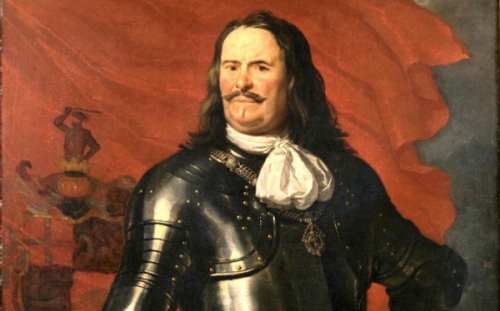
Filmbespreking: Michiel de Ruyter
door Sjors Remmerswaal
Ex: http://rechtsactueel.com
Het is bepaald geen sinecure om de Nederlandse volkheld Michiel Adriaanszoon de Ruyter waardig te verfilmen, die een groot deel van zijn leven ten dienste van het vaderland de zeeën heeft bevaren. Op allerlei functies binnen de Nederlandse vloot heeft hij zich uitermate verdienstelijk gemaakt. Internationaal bekend is de overwinning bij Kijkduin in 1673, de Engelse en Franse vloot was in aantallen veel te sterk voor de Nederlandse vloot, maar De Ruyter wist de overwinning te behalen en te voorkomen dat de vijandige troepen aan wal gingen en Nederland bezetten.
Een dergelijke man van de daad, doorheen de eeuwen zeer geliefd onder het Nederlandse volk, ja ga dat verhaal maar eens verfilmen…. Toch is het filmregisseur zeker geslaagd, het is een knappe verfilming geworden vol met actie en romantiek en het redelijk vast aanhouden van de historische werkelijkheid. De producent is Klaas de Jong, die eerder verdienstelijk de Scheepsjongens van Bontekoe verfilmde.
De hoofdrol wordt gespeeld door Frank Lammers, die Michiel de Ruyter goed weet te spelen, als gewone Zeeuwse volksjongen die vanwege zijn grote kwaliteiten opklimt binnen de marine, sterk en krachtig, aangevuld met wat Zeeuwse humor. Ook zijn er andere rollen die alleraardigst naar voren komen, zo schittert Barry Atsma als een daadkrachtige en intelligente Johan de Witt en Sanne Langelaar als de vrouw van de Ruyter, als een ijzersterke moeder en liefdevolle vrouw.

Prins van Oranje Willem III komt er minder van af, die wordt geportretteerd als homofiele slappeling, die wordt gestuurd en gemanipuleerd door Oranjegezinde intriganten. Daarentegen wordt de Republiek opgehemeld en haar verdedigers grote kwaliteiten aangemeten. Wellicht is ook interessant daarbij te vernoemen dat de Republiek vooral ook talloze ontwortelde bureaucraten voortbracht, die zich op behoorlijke schaal gingen verrijken ten koste van de Nederlandse bevolking.
Echter dit doet nauwelijks af van de heerlijke kijk- en luisterbeleving die de film is. Vechtpartijen en romantische scènes wisselen elkaar af onder het genot van ophemelende muziekdeunen. Meerdere malen zien we ook de Ruyter knokken met de bemanning van de Engelse vloot en ook zien we de elite eenheid Korps Mariniers aan de slag op de Theems. Ja, het zijn natuurlijk ook mooie stukken Nederlandse geschiedenis.
Het zeker een film om in het filmhuis te gaan bezoeken, want met de extra effecten en dramatische muziek en de knappe beelden van op de schepen, krijgt men zo meer dan een extra kijkervaring.
00:05 Publié dans Cinéma, Film | Lien permanent | Commentaires (0) | Tags : cinéma, film, pays-bas, michiel de ruyter, marine, 17ème siècle, histoire |  |
|  del.icio.us |
del.icio.us |  |
|  Digg |
Digg | ![]() Facebook
Facebook
jeudi, 05 février 2015
Aux côtés des derniers samouraïs
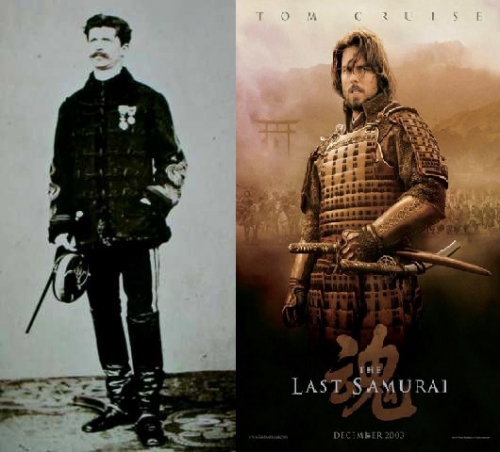
Rémy Valat
Ex: http://metamag.fr
La France n'a pas les honneurs du cinéma à grands spectacles (et à grands effets visuels) hollywoodiens. L'Histoire non plus d'ailleurs, la réalité des faits n'est que secondaire. Il suffit de prendre pour exemple le film Master and Commander : The Far Side of the World, réalisé par Peter Weir en 2003, mettant en scène les aventures du capitaine Jack Aubrey de la Royal Navy, héros d'une série de romans de l'écrivain britannique Patrick O'Brian. Cette histoire s'inspire des aventures de Thomas Cochrane, un célèbre officier de la marine britannique, et le roman original se déroule pendant la guerre anglo-américaine de 1812. Or au cinéma, Russel Crowe (qui campe le rôle de Jack Aubrey) fait face avec ses hommes et son navire aux méchants marins français de la frégate Acheron, tandis que dans l'œuvre originale, les « méchants » sont embarqués sur la frégate américaine Norfolk. Certes, un roman n'est pas la vérité historique pourrait-on nous rétorquer. La même année, était diffusé sur le grand écran le Dernier Samouraï (The Last Samurai), réalisé par Edward Zwick. Un film de qualité, à l'esthétique remarquable appuyé par la musique de Hans Zimmer, mais prenant d'étranges libertés avec l'histoire. Certes le cinéma est un divertissement, mais cet argument ne justifie pas tout. Il y a surtout, dans l’hégémonique politique culturelle nord-américaine (Hollywwood et Disney en tête), une volonté de s’accaparer du patrimoine d’autrui.
L'histoire du Dernier Samouraï, calquée sur celle du Dernier des Mohicans de Fenimore Cooper, met en scène les aventures d'un officier, américain forcément, Nathan Algren, (incarné par l'acteur et scientologue Tom Cruise) qui apporte son soutien, après sa capture, aux samouraïs de Takamori Saigo entrés en conflits contre l'empereur Meiji. Cet officier, survivant de la bataille de Little Big Horn, est devenu alcoolique pour avoir été le témoin des atrocités des guerres indiennes. Il gagne sa vie comme acteur au service d’un marchand d’armes faisant la promotion des carabines Winchester, réputées pour leur efficacité contre les Amérindiens (bien que le 7ème de cavalerie était équipé de carabines Springfield, modèle 1873, et selon les témoignages de survivants de la bataille, les canons de celles-ci, surchauffés par les tirs incessants, n’auraient plu permis l’extraction des balles par la culasse...). Nathan Algren, donc, arrive en vue du Japon, le 12 juillet 1876 !? Beau tour de force pour un militaire survivant d’une bataille qui s’est déroulée les 25 et 26 juin 1876 dans le Montana, rejoint la côte Est, trouve un travail chez Winchester et s’embarque illico pour le Japon, tout cela en 16 jours ! Et en 1876 ! Passons aussi sur les équipements des samouraïs, affublés d'armures du XVIe siècle et abandonnées depuis des lustres. On est loin de la rigueur et du désir d'authenticité des films de Kurozawa Akira.
 D'un point de vue historique, Saigō Takamori (1827-1877), incarné par Watanabe Ken, a bien pris les armes contre l'empereur Meiji en 1876. Saigô s'est longtemps opposé au shogunat et a apporté son soutien à l'empereur pendant la guerre du Boshin (1868-69), mais n’acceptera pas les profondes réformes structurelles de l'État et de la société nippone entreprises après la restauration impériale. La rupture sera consommée lorsque le projet d'invasion de la Corée qu'il propose sera rejeté (1873). Replié sur ses terres, il prendra la tête d'une insurrection qui sera réprimée par l'armée impériale. Vaincu militairement, Saigô se suicide selon les règles du code de l'honneur des samouraïs. Toutefois, ce « dernier samouraï » n'avait pas, quel dommage, de conseiller militaire américain.
D'un point de vue historique, Saigō Takamori (1827-1877), incarné par Watanabe Ken, a bien pris les armes contre l'empereur Meiji en 1876. Saigô s'est longtemps opposé au shogunat et a apporté son soutien à l'empereur pendant la guerre du Boshin (1868-69), mais n’acceptera pas les profondes réformes structurelles de l'État et de la société nippone entreprises après la restauration impériale. La rupture sera consommée lorsque le projet d'invasion de la Corée qu'il propose sera rejeté (1873). Replié sur ses terres, il prendra la tête d'une insurrection qui sera réprimée par l'armée impériale. Vaincu militairement, Saigô se suicide selon les règles du code de l'honneur des samouraïs. Toutefois, ce « dernier samouraï » n'avait pas, quel dommage, de conseiller militaire américain.
En revanche, l'armée shogunale, vaincue par les troupes impériales après la guerre du Boshin, avait à sa disposition des officiers.... français : les cadres d'une mission dirigée par le capitaine Jules Chanoine à laquelle était associée un officier de talent, un certain Jules Brunet. Relatons brièvement leur histoire, la vraie.
La première mission militaire française au Japon
En réponse à l'intrusion occidentale, le dernier shôgun, le jeune Tokugawa Yoshinobu, fît appel à des spécialistes de différents pays d'Europe et des États-Unis, les industriels et ingénieurs français était forts prisés, surtout dans les domaines du génie civil, des chantiers navals, de la métallurgie et des textiles. La France soutint cette politique de développement économique et industriel depuis la signature du traité de paix, d’amitié et de commerce de 1858 ; un partenariat revitalisé par le succès de l’Exposition universelle de 1867. Paris espérait également contre-carrer les projets britanniques dans l’île, Londres soutenant l’empereur Meiji. Du point de vue militaire, la France contribua surtout au développement de la marine de guerre, notamment par la construction du chantier naval de Yokosuka (lire sur cette question la thèse de Elisabeth de Touchet, Quand les Français armaient le Japon. La création de l’arsenal de Yokosuka (1865-1882), PUR, 2003) et prit part un temps à la réorganisation de l'armée de terre. Après avoir fait appel au ministère de la Guerre britannique, qui laissa tarder sa réponse, les autorités shôgunales réclamèrent le conseil de cadres militaires français pour former un embryon d'armée moderne, caserné à Yokohama et comportant 1 000 fantassins, 650 artilleurs et 350 cavaliers.
La mission, moins d'une vingtaine d'officiers, arriva au Japon au début de l'année 1867. Elle est surprise par la guerre civile et la crise de régime, le ministère de la Guerre réclamant prudence et circonspection à ces hommes dont la sympathie penche pour le Shôgun. Les sudistes, partisans de l’empereur, remontent vers le nord et s’emparent de Kyôtô, puis d’Edô, la capitale siège du shôgunat. Tokugawa Yoshinobu capitule (27 avril 1868), mais des jusqu’au-boutistes, dont l’amiral Enomono Takeaki, refusent la défaite et se replient pour poursuivre la lutte dans la partie septentrionale de l’île de Honshû. Le capitaine Jules Brunet, qui a succédé au capitaine Chanoine envoyé en mission en Sibérie en juillet 1868, prend fait et cause pour les derniers samouraïs, au moment où le prince Higashikuze réclame le départ des instructeurs français encore présents au Japon. Avant de déserter en compagnie de trois autres officiers de la mission (Bouffier, Fortant, son ami du régiment des artilleurs à cheval de la garde, Marlin et Bouffier), il écrit quelques mots à son supérieur, le capitaine Chanoine : «Je vous ai présenté ma démission, mais vous ne l’avez pas acceptée. J’ai attendu le jour du départ pour la France. Réfléchissant dans mon for intérieur, j’ai décidé que devant l’hospitalité chaleureuse du gouvernement chôgounal, il fallait répondre dans le même esprit. Impatient d’agir, j’ai décidé de rejoindre les serviteurs de l’ancien régime et mes élèves qui aiment leur patrie. »
Ces officiers français embarquent avec l’amiral Enomono Takeaki, à bord du navire amiral cuirassé, Kaiyô-Maru, fraîchement sorti des chantiers navals hollandais, tandis que le reste de la mission retourne en métropole. Enomono, conseillé par Jules Brunet va tenter d’organiser la résistance dans la province du Sendai, mais les forces impériales équipées d’artillerie lourde de fabrication américaine, s’emparent rapidement du principal bastion de la résistance shôgunale : la forteresse de Tsugaru. La flotte rebelle se replie et jette l’ancre dans la baie de Hakodate, actuelle préfecture de Hôkkaidô (20 octobre), et s’empare, après de vaines négociations, de la forteresse défendant la rade (28 octobre). Le 25 décembre, un scrutin est organisé et Enomono Takeaki est élu président de la République d’Ezo (ancien nom de Hôkkaidô). La supériorité numérique et matérielle de l’armée régulière est écrasante, mais qu’importe, les combattants français, qui ont reçu le renfort de trois autres officiers venus de Shanghaï (Nicole, Crateau et Eugène Collache) tentent le tout pour le tout en tentant l’abordage du navire amiral adverse, le Koketsu-Kan dans la baie de Miyako : les assaillants seront repoussés par les mitrailleuses Gatling déployées sur le pont du bâtiment (6 mai 1869). Le 20 mai, l’armée impériale débarque en différents points de l’île et les positions rebelles s’effondrent une à une, les derniers combattants et Enomono Takeaki, refugiés dans la forteresse de Goryokaku, se rendent. Remis aux autorités françaises, les officiers seront jugés et condamnés, mais la guerre de 1870 leur ouvrira la porte de leurs cachots.
Qui était Jules Brunet, cet officier aventureux qui a inspiré le personnage de Nathan Algren du film Le dernier samouraï ?
Jules Brunet (Belfort, 2 janvier 1838-Fontenay-sous-Bois, 12 août 1911) est le fils d’un vétérinaire aux armées (Jean Brunet du 3e régiment de dragons). À 19 ans, il intègre l’École Polytechnique (1er novembre 1857), puis l’école d’application de l’artillerie et du génie avec le grade de sous-lieutenant (1er octobre 1859). Le 1er octobre 1861, il est affecté au 3e régiment d'artillerie, avec le grade de lieutenant en second, et participe à la campagne du Mexique. Officier intelligent, doué en écriture et en dessins, il croque sur le vif sur des carnets à dessin des moments de la vie militaire ou les mets en scène sous forme de sketches qui seront publiés dans des revues françaises. Nathan Algren, le « Jules Brunet » de la fiction hollywoodienne possède des carnets de dessins, comportant des croquis et des études sur les tribus indiennes, mais ce point du scénario paraît être un clin d’œil au film Danse avec les Loups (le lieutenant John Dunbar, interprété par Kevin Costner, tient lui aussi un journal illustré). Jules Brunet sera ensuite affecté au régiment d’artillerie à cheval de la garde impériale (3 février 1864). C’est le 3 août 1867 qu’il est officiellement attaché à la 1ère mission française au Japon. Après l’aventure nippone, Jules Brunet gravira tous les échelons : capitaine en 1er (5e régiment d’artillerie à cheval, 24 novembre 1870), chef d’escadrons (en qualité de conseiller auprès de l’attaché militaire de l’ambassade de France en Autriche, 8 octobre 1875), lieutenant-colonel (attaché militaire à l’ambassade de France en Italie), général de brigade (état-major général de l’Armée, 29 décembre 1891), général de division (en qualité de membre du comité technique de l’artillerie, 8 novembre 1898). Jules Brunet a épousé Anne Viguié le 7 février 1870 (mairie du 10e arrondissement).
La geste de Jules Brunet n’est pas sans rappeler les aventures d’un autre artilleur, Charles-Nicolas Fabvier (1782-1855), héros de l’expédition de Morée et du siège d’Athènes . Il reste de belles réalisations cinématographiques à faire, mais pour cela, il faut plus que de l’argent, il faut de l’attachement à l’histoire de son pays. C’est la chose que l’on peut réellement envier au cinéma hollywoodien.
00:05 Publié dans Cinéma, Film, Histoire, Militaria | Lien permanent | Commentaires (0) | Tags : samourais, japon, affaires asiatiques, asie, jules brunet, cinéma, film, militaria, 19ème siècle |  |
|  del.icio.us |
del.icio.us |  |
|  Digg |
Digg | ![]() Facebook
Facebook
dimanche, 14 décembre 2014
Citizenfour, Snowden, and the Surveillance State

Citizenfour, Snowden, and the Surveillance State
A viewing of the film Citizenfour, real-life drama of Edward Snowden’s first days on the run from the National Security Agency (NSA), is bound to elicit one visceral response: chilling. We see in Laura Poitras’ splendid documentary not only Snowden’s by-now familiar personal saga, but the specter of modern technological domination at its most frightening. The film, by way of Snowden’s revelations and commentary, poses searing questions about the impact of surveillance technology on American society and, in turn, on the future of democratic politics anywhere.
Snowden’s journey is well-known enough: hasty departure from Hawaii, where he worked as a technician for the NSA, to Hong Kong as whistleblower in possession of vast information related to the agency’s worldwide eavesdropping activities, then on to Moscow where he finally gains residential status. Poitras’ film centers on eight tense days Snowden spent at a hotel in Hong Kong, where his stunning revelations are turned into dramatic footage along with a series of reports by Glenn Greenwald and others for the London Guardian on U.S. surveillance programs, which have become more intrusive than generally believed. With these programs, Snowden comments, “we are building the biggest weapon for oppression in the history of mankind,” adding that, despite accumulated evidence of domestic NSA espionage, protest in the U.S. is barely visible: Congress, the White House, mass media, and public remain virtually silent in the face on escalating threats to privacy and freedoms.
The Snowden narratives depict a system, NSA at the center, of nonstop secret monitoring and tracking of American citizens, with no accountability and little justification beyond stale references to “national security” and the need to detect and monitor terrorists. In the film we see a post-9/11 technological labyrinth that vacuums up billions of electronic transactions daily and locates millions of people through cellphone and other GPS coordinates. In partnership with corporations like Microsoft and Verizon, the NSA routinely shares data with the Drug Enforcement Administration (DEA), Defense Intelligence Agency (DIA), CIA, and IRS, all ostensibly to spy on terrorists, drug traffickers, and assorted criminals. One result of all this data processing is an exhaustive watch list, currently identifying more than a million “threats”, funneled through the shadowy Terrorist Identities Datamart Environment (TIDE), maintained by the shadowy Terrorist Identities Group (TIG)..
With its sprawling acres of supercomputers, the NSA has been the largest and most intrusive spy agency since 1952, its “black” operations initially driven by the Cold War – a history thoroughly chronicled by James Bamford in a series of books (most recently The Shadow Factory). Thanks to the exhaustive work of Bamford and such whistleblowers and William Binney and Snowden, we currently know far more about this presumably super-secret, or “deep state” realm of the American power structure than will ever be officially acknowledged. The subtitle of The Shadow Factory, written in 2008, is “The Ultra-Secret NSA from 9/11 to the Eavesdropping on America”, indicating that Snowden’s domestic revelations were not as pathbreaking as often depicted. (Unnecessary disclosure: I worked three youthful years for the NSA as a Russian linguist – but never part of any war effort.)
In Citizenfour we learn that in 2013 alone the NSA collected 124.8 billion telephone data items and 97.1 billion pieces of computer data on unsuspecting people around the world, including theoretically off-limits domestic targets. Such “metadata” collection is of course the stuff of totalitarian scenarios that match or exceed the worst Orwellian nightmares. The film (and Snowden’s accounts in general) raises questions about the fate of individual privacy, political freedoms, and democratic governance in an era of ever-expanding (and elusive) surveillance technology.
The first question goes directly to the predicament of democracy itself, already under siege. When government agencies can create eavesdropping resources well beyond the reach of laws, policies, and conventions, what public leverage can ordinary people hope to secure over the machinery of state and military power? Can nonstop mega-data collection and processing, carried out by intelligence organizations with little regard for its consequences, ever be compatible with democratic politics? Can the “deep state” of modern communications, more far-reaching with each technological innovation, serve anything but elite domination?
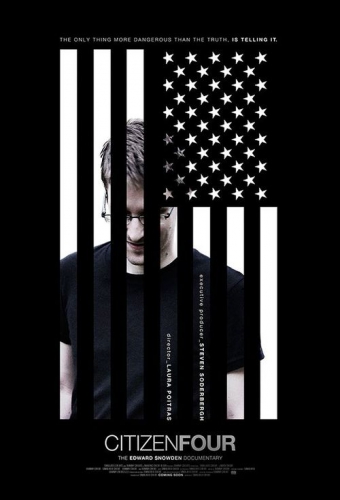 A second – equally crucial – question turns on the already-deteriorating character of public discourse: feeble resistance to technological authoritarianism in the U.S. is palpable and alarming. Congress has done nothing to tame the juggernaut, while the Obama administration remains essentially content with dancing around the issue, obsessed with Snowden’s notoriety (and imputed criminality). Despite what has been revealed by Snowden – and Bamford and Binney before him – few dare to speak out, surely fearful of being derided as “soft on terrorism”. Further, NSA programs are so “deep”, so shrouded in mystery, that hardly anyone seems able to penetrate the technological fortress sufficiently to fathom what is taking place. And of course NSA work is in highly-classified, including even its budget (estimated at possibly $20 billion yearly).
A second – equally crucial – question turns on the already-deteriorating character of public discourse: feeble resistance to technological authoritarianism in the U.S. is palpable and alarming. Congress has done nothing to tame the juggernaut, while the Obama administration remains essentially content with dancing around the issue, obsessed with Snowden’s notoriety (and imputed criminality). Despite what has been revealed by Snowden – and Bamford and Binney before him – few dare to speak out, surely fearful of being derided as “soft on terrorism”. Further, NSA programs are so “deep”, so shrouded in mystery, that hardly anyone seems able to penetrate the technological fortress sufficiently to fathom what is taking place. And of course NSA work is in highly-classified, including even its budget (estimated at possibly $20 billion yearly).
Transparency and accountability are meaningless concepts when it comes to the NSA playbook. We have seen how those recently in charge of agency operations – General James Clapper and Keith Alexander – have blatantly lied to Congress about the extent of NSA domestic spying, as shown in Citizenfour. Unlike baseball players denying they took performance-enhancing drugs, Clapper and Alexander could stonewall everything in broad daylight with legal impunity, protected by their status within the warfare state. In November, meanwhile, Vermont Senator Patrick Leahy offered up a bill to limit NSA access to domestic phone records, a tepid reform that nonetheless failed to muster enough votes to cut off debate. The USA Freedom Act, as it was called, was too extreme for Senate Republicans, whose freedom-loving rhetoric got hopelessly lost in the maze of surveillance priorities. They insist that meta-data collection is required to combat terrorism – though, as Bamford convincingly shows, domestic espionage activities have actually done little to track or intercept domestic terrorism.
Third, abundant evidence shows that surveillance order rests on a tight partnership of government, corporations, and the military – a power structure extending far beyond the familiar “Big Brother”, understood strictly as a matter of state controls. The now infamous PRISM program, undertaken by George W. Bush in 2007, relies on extensive data-mining shared by the NSA and such corporations as Microsoft, AT&T, Google, Verizon, Yahoo, and Apple. Telephone and computer information is often simply turned over to the NSA, usually without much legal fuss – a system of cooperative ventures, or integrated power, endemic to a militarized state-capitalism.
Freewheeling NSA surveillance poses yet another question: can “deep”, all-consuming, globalized eavesdropping, in the hands of an aggressive ruling elite, be brought under popular control by even the most well-intentioned reforms? Progressives have long embraced the hope of a democratic Internet and related media infused with a high degree of electronic populism, yet in reality the American power structure holds immense advantages in technological, material, and institutional resources over any challenger. The NSA itself can easily trump lesser organizations and movements, suggesting that the prospect of counter-forces strong enough to take on the juggernaut would seem to be dim – at least while the existing power apparatus remains intact. There is the linked problem of whether NSA technology can even be sufficiently grasped to carry out meaningful reform. Snowden and Binney appear to know their way around the fortress, but how many Snowdens and Binneys do we have? There is one certainty here: those at the summits of power, those who manage the apparatus, have no desire to relinquish the God-like power they wield through their arsenal of supercomputers and hundreds of global listening posts. Quite the contrary: their messianic goal is precisely to expand that power, pushing it to its outer limits without the slightest regard for Constitutional or other political limits.
This brings us back to Snowden and his political relevance. In Citizenfour we encounter a beleaguered Snowden, a person unsure and fearful, anxious about the future, understandably in limbo about the potential consequences of his risky actions. Snowden had obviously done much reflection in the weeks and probably months leading up to his decision to flee, although the political ramifications could only be rather murky. Solutions to broadening NSA surveillance were not likely to be on the immediate horizon. A fearsome thought emerges: could the technology now be so sophisticated, so “deep”, that effective reforms will no longer be viable — that something of a turning point might have been reached? Could the apparatus have taken on a life of its own, impervious to the actions of Congress, political intervention, popular movements? Could Snowden’s revelations, for all their spectacular media impact, be overwhelmed by the sheer pace of technological change.
In strictly political terms, Snowden is actually more forthcoming in his recent Nation interview (November 17, 2014) conducted by Stephen F. Cohen and Katrina Vanden Heuvel. In both the documentary and the Nation, Snowden is quick to affirm that he is not especially comfortable dealing with politics, that he is “no politician”, being far more adept at technology. Indeed computer work nowadays appears to consume the bulk of his time in Moscow. In a candid moment, however, Snowden tells Cohen and Vanden Heuvel that, contemplating the surveillance onslaught, people “have the right of revolution – it’s about revolutionary ideas”, adding: “It’s about direct action, even civil disobedience”. He identifies the Occupy movement, though now rather moribund, as something of an inspiration. No less than the future of democracy, in the U.S. and worldwide, is at stake.
At another point in the Nation exchanges Snowden seems ready to embrace social movements as the most efficacious counter-force, possibly the only hope. He tells Cohen and Vanden Heuvel that “we cannot be effective without a mass movement”, but immediately adds “the American people today are too comfortable to adapt to a mass movement.” Unfortunately, he laments, the education system is designed primarily for “indoctrination”, hardly the source of a reflective, critical, galvanized public needed to take on the surveillance state. As for Snowden himself, not being a “politician” leaves him with a daunting challenge – “to focus on technological reform, because I speak the language of technology”.
Could such reform, however ambitious, furnish a solution to the rapidly-expanding system of technological domination we face? Snowden’s own prior comment – that “we cannot be effective without a mass movement” – no doubt provides the best answer. At one moment in the film Snowden concedes that technological constraints placed on the fortress within the U.S. (or any single country) will be checkmated unless those constraints become systemic and global, which poses new layers of obstacles. Snowden knows better than most that communications technology by its very nature is both ever-changing and unbounded, recognizing no temporal boundaries; its very logic is to adapt and expand, resisting barriers (if any) set by mortal politicians. This is emphatically true for “deep” entities like the NSA, which fiercely asserts both its power and secrecy. It follows that U.S.-centered reforms, even in the unlikely event Congress overcomes its fear and lethargy, is destined to be neutralized even before any legislation is signed into law. Despite his remarkably bold and courageous moves, therefore, Snowden’s political options – and indeed those of everyone else – have clearly yet to be articulated, unless his idea of “revolution” is to be taken seriously.
In the end, government and military elites perched atop the surveillance order will happily continue business-as-usual until overthrown by more powerful, resource-laden counter-forces. Their privileged status is much too embedded in the fortunes of the security state and war economy, which depends as never before on endless flows of electronic information, personal tracking, and institutional controls.
CARL BOGGS is the author of The Hollywood War Machine, with Tom Pollard (second edition, forthcoming), and Drugs, Power, and Politics (forthcoming), both published by Paradigm.
00:05 Publié dans Cinéma, Film | Lien permanent | Commentaires (0) | Tags : edward snowden, nsa, film, cinéma, 7ème art, laura poitras, états-unis, surveillance totale, services secrets, services secrets américains |  |
|  del.icio.us |
del.icio.us |  |
|  Digg |
Digg | ![]() Facebook
Facebook
vendredi, 21 novembre 2014
Hiroshi Teshigahara, La Femme des Sables, (Japon, 1964)
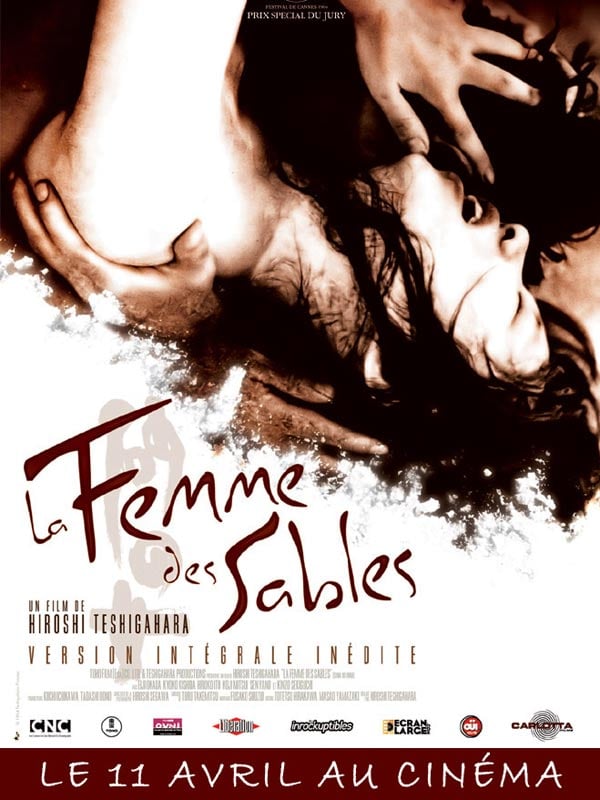
Hiroshi Teshigahara, La Femme des Sables, (Japon, 1964)
Ex: http://cerclenonconforme.hautetfort.com
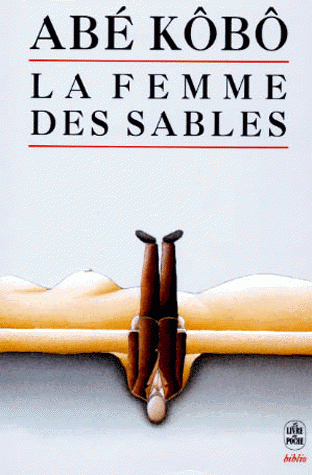 La deuxième des quatre œuvres issues de la collaboration de Teshigahara avec l’écrivain Kobo Abe, La Femme des Sables, est son long métrage le plus célèbre. C’est aussi certainement celui qui laisse l’impression la plus forte et la plus durable.
La deuxième des quatre œuvres issues de la collaboration de Teshigahara avec l’écrivain Kobo Abe, La Femme des Sables, est son long métrage le plus célèbre. C’est aussi certainement celui qui laisse l’impression la plus forte et la plus durable.
Si l’on peut rester de marbre devant Le Traquenard ou Le Visage d’un Autre, à cause notamment de certaines longueurs franchement pénibles, d’un style parfois curieux et d’un propos relativement décousu, le flot d’images surréalistes et envoûtantes de La Femme des Sables, en revanche, constitue une expérience esthétique fascinante, et ce malgré un director’s cut de 147 minutes bien tassées.
Visuellement, cette œuvre regorge de trouvailles : superpositions de plans, alternance entre les gros plans d’insectes, de grains de sable ou du grain de la peau humaine, et de longues étendues désertiques animées par le vent ou par les traces laissées par un être humain… La photographie en noir et blanc est franchement splendide, et du point de vue de l’atmosphère générale, le terme « hanté » ne semble pas usurpé.
La trame du film elle-même est plutôt originale : un citadin, instituteur de son état dans une mégapole japonaise et entomologiste amateur, se rend dans le désert à la recherche de spécimens rares, dans l’espoir de voir son nom passer à la postérité dans une encyclopédie. Après une longue marche, il s’allonge sur le sable et laisse ses pensées vagabonder. Il songe aux papiers, aux archives, aux dossiers, aux permis, à la masse effroyable de paperasse qui donne à chacun un sentiment ambigu : celui d’appartenir à une société et d’être reconnu par celle-ci, tout en étant au fond qu’un nom parmi tant d’autres – un grain de sable parmi les grains de sable.
Il s’assoupit, et à son réveil il se laisse convaincre par un inconnu de se laisser guider jusqu’à un village au beau milieu du désert où il pourra se restaurer et passer la nuit. Arrivé au village, notre homme découvre une maison de bois passablement délabrée, encaissée au fond d’une fosse de sable. Le voyageur descend par une échelle de corde à la rencontre de son hôte, une femme vivant seule dans cette tombe à ciel ouvert. Au cours du repas, l’homme plein d’orgueil et sûr de sa supériorité de citadin, prend son hôte de haut lorsque celle-ci lui parle de son quotidien et des étranges phénomènes dont elle est régulièrement témoin.
L’homme se rend compte au cours de la nuit que la femme vit d’un labeur peu commun : elle entasse des kilos de sable dans de grandes caisses de métal, que des paysans hissent depuis le sommet de la fosse à l’aide d’un treuil. On pense tout d’abord qu’il s’agit d’une méthode fastidieuse destinée à éviter que la maison ne finisse par être intégralement ensevelie ; on apprend plus tard que ce sable est revendu à des entrepreneurs peu scrupuleux qui mettent en œuvre ce matériau peu coûteux et dangereux dans leurs constructions.
La condescendance du voyageur vis-à-vis de la femme qui le nourrit et l’héberge est bien vite vengée : le matin venu, l’homme s’aperçoit en effet que l’échelle de corde a disparu… Il ne tarde pas à comprendre qu’il est tombé dans un piège et que sa survie dépend de l’aide qu’il voudra bien apporter à la femme des sables dans sa tâche absurde et sans fin. L’homme passe de la révolte et de l’espoir à la résignation, puis au dépassement de sa condition tout au long de ce film en forme de quête initiatique.
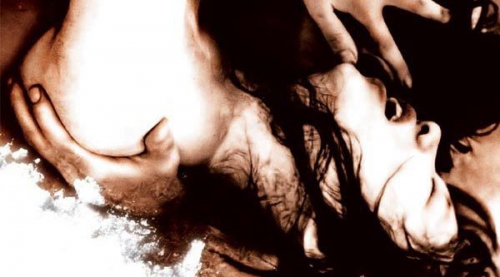
Le film tourne autour de la notion d’identité : la place que l’homme occupe dans la société, instituteur au sein d’une grande ville, semble largement suffire à son épanouissement ; pourtant son incursion d’entomologiste amateur en quête de renommée et les réflexions qu’il se formule au cœur du désert, au sujet de ce qui fonde l’identité en tant que citadin, sont deux éléments qui montrent bien que notre homme redoute déjà au fond de lui de n’être rien d’autre qu’un grain de sable dans le désert. Lorsqu’il se retrouve confronté à une villageoise recluse au fin fond du désert pourtant, son statut officiel lui fournit une assurance mâtinée d’orgueil qui se mue vite en condescendance ; plus tard encore au cours de sa captivité, il nourrit toujours l’espoir d’être secouru, il place tous ses espoirs dans la certitude que le monde moderne auquel il appartient finira par le rattraper, qu’on viendra le chercher, que tout rentrera dans l’ordre pour lui.
A mesure que le film se déroule, toutes les craintes de l’homme s’avèrent fondées. Il comprend qu’il n’a jamais rien acquis d’autre qu’une identité de façade, intégralement administrative et sans réalité charnelle. Sa solitude cauchemardesque trouve un écho direct dans cette image du prisonnier au fond d’une tombe de sable. De nombreux plans du film viennent alimenter l’analogie, parfois en exacerbant le caractère futile des tentatives d’évasion : l’homme est semblable aux insectes qu’il collectionne, s’agitant vainement pour s’extirper de cette fosse où il lui faut maintenant apprendre à vivre.
Toute la futilité et l’absurdité de la condition humaine sont mises en évidence de façon tragique ; le labeur quotidien, infiniment renouvelé, infiniment absurde, rappelle bien évidemment le mythe de Sisyphe. Il ne faut pas s’en étonner : l’ouvrage de Kobo Abe semble en effet largement redevable à la philosophie existentialiste. La conclusion de la Femme des Sables est d’ailleurs fidèle, en substance, à celles que Kierkegaard, Sartre ou Camus ont pu formuler dans leurs travaux : Teshigahara nous suggère en effet à la fin de son long métrage que l’homme doit trouver sa liberté intérieure en acceptant sa condition, en collaborant avec la femme des sables et en se livrant à une activité intellectuelle.
Au-delà de cette lecture philosophique, qu’il ne faut bien évidemment pas se sentir obligé de partager, il reste un petit bijou du cinéma japonais des années 60, à l’ambiance particulièrement soignée, et dont la beauté formelle n’est certainement pas la moindre des qualités.
Lydéric / C.N.C.
Note du C.N.C.: Toute reproduction éventuelle de ce contenu doit mentionner la source.
00:05 Publié dans Cinéma, Film, Littérature | Lien permanent | Commentaires (0) | Tags : cinéma, film, 7ème art, cinéma japonais, japon, lettres, lettres japonaises, littérature japonaise, littérature, abé kobo |  |
|  del.icio.us |
del.icio.us |  |
|  Digg |
Digg | ![]() Facebook
Facebook
dimanche, 11 mai 2014
Tout le monde il est gentil, tout le monde il est raciste
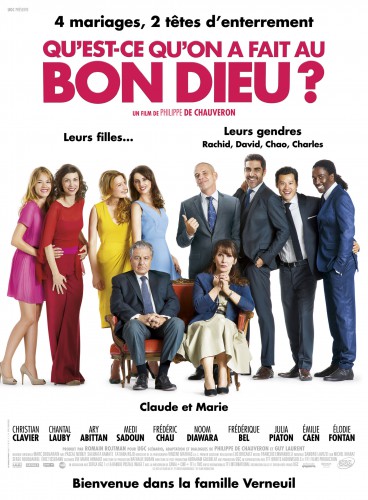
Tout le monde il est gentil, tout le monde il est raciste
«Qu’est-ce qu’on a fait au bon dieu»
Le film qui fait rire jaune l’idéologie antiraciste
Jean Ansar
Ex: http://metamag.fr
 Ce racisme sans conséquences n’est plus d’actualité. C’est une France où l’on accueille l’autre avec méfiance et bienveillance mais où l’autre ne tente pas d‘imposer, de dominer. On est très loin des « racailles » de banlieue même si elles sont présentes, car le jeune algérien marié à une fille Verneuil est avocat et on le voit défendre, commis d’office, ceux qu’il qualifie de « capuches sans cerveaux ». Une France avec une diversité marginale et exotique et pas, comme c’est le cas, une diversité de peuplement et de substitution de populations et de mode de vie. La comédie est exploitée par les antiracistes politiques pour prouver que le pays a changé et que finalement, il faut accepter dans la bonne humeur d’être tous des Verneuil, des familles «Benneton » comme le dit, lors d’une messe, un habitant de la localité.
Ce racisme sans conséquences n’est plus d’actualité. C’est une France où l’on accueille l’autre avec méfiance et bienveillance mais où l’autre ne tente pas d‘imposer, de dominer. On est très loin des « racailles » de banlieue même si elles sont présentes, car le jeune algérien marié à une fille Verneuil est avocat et on le voit défendre, commis d’office, ceux qu’il qualifie de « capuches sans cerveaux ». Une France avec une diversité marginale et exotique et pas, comme c’est le cas, une diversité de peuplement et de substitution de populations et de mode de vie. La comédie est exploitée par les antiracistes politiques pour prouver que le pays a changé et que finalement, il faut accepter dans la bonne humeur d’être tous des Verneuil, des familles «Benneton » comme le dit, lors d’une messe, un habitant de la localité.
 De son coté Le Monde constate. « Le film de Philippe de Chauveron, fait actuellement exploser tous les compteurs du box-office français. Accueil critique ? Inexistant, aucune projection de presse n’ayant précédé sa sortie. Bouche-à-oreille ? Exceptionnel, à tel point que les deux plus gros succès du cinéma français, Intouchables (19,44 millions d’entrées) et même Bienvenue chez les Ch’tis (20,48 millions) ne paraissent pas hors d’atteinte. Visible sur Internet, l’efficace bande-annonce laisse présager le pire : 1,58 min de clichés raciaux ou racistes, on ne sait trop, en tous genres. Quel est donc ce film qui fait salle comble aussi bien à Paris qu’en régions ? Un ersatz cinématographique des thèmes chers au Front national ? L’affaire est plus compliquée. »
De son coté Le Monde constate. « Le film de Philippe de Chauveron, fait actuellement exploser tous les compteurs du box-office français. Accueil critique ? Inexistant, aucune projection de presse n’ayant précédé sa sortie. Bouche-à-oreille ? Exceptionnel, à tel point que les deux plus gros succès du cinéma français, Intouchables (19,44 millions d’entrées) et même Bienvenue chez les Ch’tis (20,48 millions) ne paraissent pas hors d’atteinte. Visible sur Internet, l’efficace bande-annonce laisse présager le pire : 1,58 min de clichés raciaux ou racistes, on ne sait trop, en tous genres. Quel est donc ce film qui fait salle comble aussi bien à Paris qu’en régions ? Un ersatz cinématographique des thèmes chers au Front national ? L’affaire est plus compliquée. »
00:05 Publié dans Cinéma | Lien permanent | Commentaires (0) | Tags : cinéma, film, 7ème art |  |
|  del.icio.us |
del.icio.us |  |
|  Digg |
Digg | ![]() Facebook
Facebook
jeudi, 24 avril 2014
300. Naissance d’une nation
300. Naissance d’une nation
par Thomas Ferrier
Ex: http://thomasferrier.hautetfort.com
 La suite attendue du film « 300 » de Zach Snyder, intitulée « l’Avènement d’un Empire » (Rise of an Empire), est récemment sortie sur nos écrans. A la musique, Tyler Bates a cédé la place à Junkie XL, qui nous propose une bande originale brillante, finissant en apothéose en mêlant son dernier morceau à une mélodie de Black Sabbath.
La suite attendue du film « 300 » de Zach Snyder, intitulée « l’Avènement d’un Empire » (Rise of an Empire), est récemment sortie sur nos écrans. A la musique, Tyler Bates a cédé la place à Junkie XL, qui nous propose une bande originale brillante, finissant en apothéose en mêlant son dernier morceau à une mélodie de Black Sabbath.
Comme dans le premier film, c’est un récit qui nous est proposé, jusqu’à l’extrême fin. La reine spartiate Gorgo raconte ainsi la vie de Thémistocle, le héros athénien du film, jusqu’à ce que ses troupes interviennent d’une manière décisive à Salamine. Les nombreuses invraisemblances et les libertés prises avec l’histoire sont ainsi justifiées. Il faut les admettre pour profiter pleinement du message optimiste du film.
L’ouverture avec un Xerxès décapitant Léonidas mort correspond au récit traditionnel. Quant à la « naissance » du dieu-roi, concept contraire à la tradition zoroastrienne, grande oubliée du film, la jeunesse de Xerxès, assistant impuissant au parcours d’une flèche de Thémistocle perforant l’armure de Darius, son père, est narrée, ainsi que la manipulation dont il est la victime par Artémise, jouée par Eva Green, mégère inapprivoisée avide de sang vengeur.
A l’incendie de Sardes par les Athéniens, qui sera le véritable déclencheur de la guerre avec les Perses, le scénariste a préféré « accuser » Thémistocle, personnage tragique, à la fois responsable des malheurs de son peuple et vainqueur ultime de ses ennemis.
A la grandeur sobre et un peu égoïste de Léonidas dans le premier film, Thémistocle est un idéaliste, rêvant d’une Grèce rassemblée et même d’une nation grecque. Le voici émule avant l’heure d’Isocrate. Son discours sur la nécessaire unité de la Grèce au-delà des querelles de cités rappelle celui des véritables européistes, partisans d’une Europe-Nation. Gorgo est davantage souverainiste, estimant que Sparte a « assez donné », mais elle saura faire son devoir et venir en renfort. C’est ainsi que Spartiates et Athéniens unis écrasent la marine perse, tandis qu’Artémise meure dans les bras de son ennemi.
Et même le traître du premier film, le bossu Ephialtès, sert à sa manière la Grèce en invitant Xerxès à attaquer Thémistocle, alors qu’il sait que ce dernier a prévu un piège dans lequel les Perses vont s’engouffrer. Les Spartiates, à l’instar des Rohirrim menés par Gandalf dans « Les deux tours », arrivent à la rescousse, avec à leur tête une nouvelle Valkyrie, une Gorgo marchant l’épée dressée. Même si la Sparte historique traitait ses femmes avec une quasi égalité, on ne verrait pourtant jamais une femme au combat.
Si le message du premier film était celui opposant 300 Européens au monde entier, la dimension cosmopolite de l’armée perse a été adoucie. A l’exception d’un émissaire perse, vu dans le premier film, les généraux et soldats perses pourraient passer pour des Iraniens. En revanche, le message du second est offensif. Après la résistance, la reconquête. Certes, au bord de l’abîme, tout comme l’Europe ne s’unira qu’à proximité du tombeau, selon Nietzsche. La reconquête et l’unité. Tous les Grecs combattent désormais ensemble. Historiquement, c’est bien sûr faux. Thessaliens et Grecs d’Asie mineure étaient dans l’armée perse, et Thèbes jouait double jeu. La mort héroïque de Léonidas, habilement exploitée par Thémistocle, sert de mythe mobilisateur. La Grèce a eu ses martyrs. L'Europe n'a pas encore eu les siens.
Le message politique de Thémistocle, appliqué à la Grèce mais qui pourrait tout aussi bien l’être à l’Europe, est fort. La ruine d’Athènes, incendiée par Xerxès, est également un moment décisif du film. Bien que nous sachions que Salamine fut une victoire grecque, la dimension tragique de leur combat apparaît nettement. Monté sur un cheval de guerre qui saute de bâteau en bâteau comme s’il était Pégase, Thémistocle pourfend les ennemis de son épée, jusqu’à combattre et vaincre Artémise, tandis que Xerxès s’éloigne, sentant l’ombre de la défaite.
Le film est un hymne à l’unité de l’Europe, ce qui est bien surprenant pour une production américaine, au cœur même de l’assemblée d’Athènes. En pleine crise, la Grèce se retrouve à nouveau comme préfiguration de l’Europe de demain, qui reste à bâtir. Une Grèce qui lutte pour la démocratie autour d’Athènes, aidée d’une Sparte qui pourtant n’y croit guère. L’alliance d’Athènes et de Sparte, c’est l’alliance de l’Union Européenne et de la Russie face à un empire qui menace ses libertés, un empire qui a reçu l’aide de renégats (Artémise, Ephialtès) qui agissent contre leur propre peuple.
Thomas FERRIER (LBTF/PSUNE)
00:05 Publié dans Cinéma | Lien permanent | Commentaires (0) | Tags : cinéma, film, 7ème art, 300, thomas ferrier, grèce, grèce antique, antiquité grecque, hellenisme |  |
|  del.icio.us |
del.icio.us |  |
|  Digg |
Digg | ![]() Facebook
Facebook
mercredi, 23 avril 2014
Hercule, un Jésus européen ?
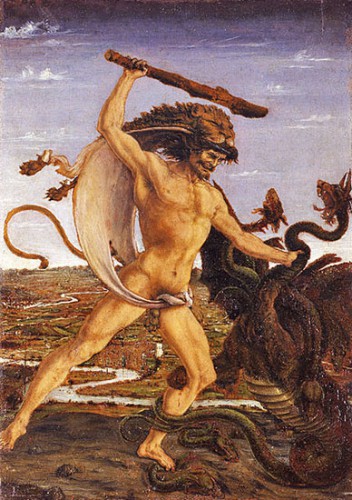
Hercule, un Jésus européen?
par Thomas Ferrier
Ex: http://thomasferrier.hautetfort.com
« Hercules, the legend begins » est enfin sorti sur les écrans français après avoir connu un terrible échec commercial, il y a deux mois, aux Etats-Unis. On pouvait donc craindre le pire, malgré une bande annonce des plus alléchantes. Après avoir vu ce film, que j’ai pour ma part beaucoup apprécié, je m’interroge sur le pourquoi de cette descente en flammes et de ce qui a déplu à la critique.
Bien sûr, dans cette Grèce du XIIIème siècle avant notre ère, il y a de nombreux anachronismes comme des combats de gladiateurs ou encore la conquête de l’Egypte. Si de beaux efforts graphiques ont été faits, on se trouve dans une Grèce de légende, à mi-chemin entre la Grèce mycénienne et la Grèce classique. Et de même, la légende du héros, avec les douze travaux, est absente ou malmenée, alors que de nouveaux éléments s’ajoutent, comme une rivalité entre Héraclès et son frère Iphiclès. Tout cela a pu surprendre un public habitué à ces classiques.
Et pourtant de nombreuses idées audacieuses se sont glissées dans ce film et le rendent passionnant. Ainsi, la vie d’Hercule s’apparente par certains aspects à celle de Jésus. De nombreux films américains, à l’instar de Man of Steel, la comparaison implicite est patente. Dans « Hercules », elle est voulue mais détournée. Alcmène s’unit à Zeus sans que le dieu apparaisse, se manifestant par une tempête accompagnée d’éclairs. Cela ne vous rappelle rien ? De même, Hercule est fouetté et attaché par les deux bras dans une scène rappelant la crucifixion. Mais il en sort vainqueur, brisant ses liens, et écrasant grâce à deux énormes blocs de pierre attachés par des chaînes à ses bras tous ses ennemis. Enfin, il devient concrètement roi à la fin de son aventure, ne se revendiquant pas simplement « roi de son peuple » mais roi véritable.
Bien sûr, ce « Jésus » aux muscles imposants mais sobres, à la pigmentation claire et aux cheveux blonds, n’a pas la même morale. Fils du maître de l’univers, dont il finit par accepter la paternité, Zeus en personne, il tue ses ennemis, jusqu’à son propre père adoptif, combat avec une férocité qui en ferait l’émule d’Arès, et semble quasi insensible à la douleur. Une scène le présente même recevant sur son épée la foudre de Zeus qu’il utilise ensuite comme une sorte de fouet électrique pour terrasser les combattants qui lui font face.
Par ailleurs, la « diversité » est réduite à sa plus petite expression, limitée à des mercenaires égyptiens, crédibles dans leur rôle. Les Grecs en revanche sont tous bien européens, avec des traits parfois nordiques. Il n’est pas question comme dans « Les Immortels » ou « Alexandre » de voir des afro-américains en armure ou jouant les Roxanes. En revanche, on retrouve davantage l’esprit de Troie, l’impiété en moins. En effet, cette fois les athées ont le mauvais rôle à l’instar du roi de Tirynthe Amphitryon. Hercule lui-même, qui ne croit pas dans l’existence des dieux pendant une bonne partie du film, finit par se revendiquer explicitement de la filiation de Zeus et la prouver. En outre, Hercules rappelle par certains côtés le premier Conan, puisque le héros est trahi et fait prisonnier, puis s’illustre dans des combats dans l’arène d’une grande intensité, bondissant tel un fauve pour fracasser le crâne d’un ennemi, mais il reste toujours chevaleresque, protégeant les femmes et les enfants.
A certains moments, le film semble même s’inspirer des traits guerriers qu’un Breker donnait à ses statues. Kellan Lutz n’est sans doute pas un acteur d’une expression théâtrale saisissante mais il est parfaitement dans son rôle. Si les douze travaux se résument à étrangler le lion de Némée, à vaincre de puissants ennemis mais qui demeurent humains, et à reconquérir sa cité, son caractère semi-divin, même si le personnage refuse tout hybris, est non seulement respecté mais amplifié. En ce sens, Hercule apparaît comme un Jésus païen et nordique, mais aussi un Jésus guerrier et vengeur, donc très loin bien sûr du Jésus chrétien. Fils de Dieu, sa morale est celle des Européens, une morale héroïque.
Toutefois, bien sûr, certains aspects modernes apparaissent, comme la relation romantique entre Hercule et Hébé, déesse de la jeunesse qu’il épousera après sa mort dans le mythe grec, et le triomphe de l’amour sur le mariage politique. C’est bien sûr anachronique. Mais « la légende d’Hercule » ne se veut pas un film historique.
Enfin, la morale est sauve puisque dans le film, Héra autorise Zeus à la tromper, alors que dans le mythe classique elle met le héros à l’épreuve par jalousie, afin de faire naître un sauveur. Zeus ne peut donc être « adultère ». Cela donne du sens au nom du héros, expliqué comme « le don d’Héra », alors qu’il signifie précisément « la gloire d’Héra », expression énigmatique quand on connaît la haine de la déesse envers le héros. Pour s’exprimer, Héra pratique l’enthousiasme sur une de ses prêtresses, habitant son corps pour transmettre ses messages. C’est conforme à la tradition religieuse grecque.
Les défauts du film sont mineurs par rapport à ses qualités, graphiques comme scénaristiques, mais ce qui a dû nécessairement déranger c’est qu’il est trop païen, trop européen, trop héroïque, qu’il singe le christianisme pour mieux s’y opposer. Le fils de Dieu est marié et a un enfant (à la fin du film). Le fils de Dieu n’accepte pas d’être emmené à la mort mais triomphe de ses bourreaux. Le fils de Dieu devient « roi des Grecs ». Enfin le fils de Dieu apparaît comme tel aux yeux de tous et n’est pas rejeté par son propre peuple. Ce film ne pouvait donc que déranger une société américaine qui va voir des films où Thor lance la foudre, où Léonidas et ses « 300 » combattent jusqu’à la mort avec une ironie mordante, mais qui reste très chrétienne, très puritaine et hypocrite.
Thomas FERRIER (LBTF/PSUNE)
00:05 Publié dans Cinéma, Traditions | Lien permanent | Commentaires (0) | Tags : herakles, hercule, mythologie, mythe, religion, traditions, mythologie grecque, grèce antique, antiquité grecque, hellenisme, film, cinéma, 7ème art |  |
|  del.icio.us |
del.icio.us |  |
|  Digg |
Digg | ![]() Facebook
Facebook
vendredi, 29 novembre 2013
Taxi Driver
00:05 Publié dans Cinéma, Evénement, Film | Lien permanent | Commentaires (0) | Tags : événement, film, cinéma, italie, toscane, florence, firenze, casa pound |  |
|  del.icio.us |
del.icio.us |  |
|  Digg |
Digg | ![]() Facebook
Facebook
mercredi, 27 novembre 2013
Feminism versus Marriage
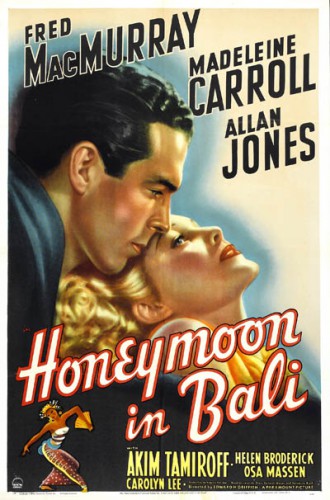
Feminism versus Marriage in Virginia Van Upp’s Honeymoon in Bali (1939)
By Andrew Hamilton
Ex: http://www.counter-currents.com
Feminism is a major destructive force. Anti-male, anti-family, and anti-white, it is today a key ideological pillar of the ruling class. It is therefore necessary to look to the past in an attempt to identify healthy folkways associated with male-female relationships, sex, marriage, and family.
A 1939 romantic comedy called Honeymoon in Bali (1939) starring Scottish (or part-Scottish) American actor Fred MacMurray and English-born half-Irish (father), half-French (mother) actress Madeleine Carroll (born Marie-Madeleine Bernadette O’Carroll), sheds light on the conflict between feminism and marriage in 1930s America from the perspective of a successful, high-level female executive, Hollywood screenwriter Virginia Van Upp, who lived the feminist dream.
MacMurray is best known as the dishonest insurance salesman in Double Indemnity (1944), the star of several 1960-era Disney comedies, and the affable, pipe smoking dad in the TV series My Three Sons (1960–1972). Madeleine Carroll’s romantic appeal can be seen to best advantage in two movie classics, Alfred Hitchcock’s The 39 Steps (1935) and The Prisoner of Zenda (1937).
Honeymoon in Bali bore the alternative titles Husbands or Lovers (in the UK) and My Love for Yours (on video). Prior to release the working title—revealingly—was Are Husbands Necessary? Paramount, the studio that produced the film, later used that title for an unrelated 1942 movie starring Ray Milland and Betty Field.
Bali was based on short stories by Grace Sartwell Mason [2] in the Saturday Evening Post and the novel Free Woman (1936) by New York City WASP writer Katharine Brush, whose work was often compared to that of F. Scott Fitzgerald. At her death at age 49 in 1952, the New York Times characterized Brush’s fiction as “entertaining, brittle, superficial and in revolt against sentimentality and other qualities of the Victorian period.”
The real force behind Honeymoon in Bali, however, was Paramount Pictures screenwriter Virginia Van Upp. Though little-known today, she was an influential behind-the-scenes figure in the Jewish movie colony. (The Chicago-born Van Upp was apparently of Dutch descent.)
Van Upp’s mother had been an editor and title writer for silent movie producer Thomas H. Ince, the son of English immigrants. Ince was a seminal figure in the history of motion pictures. A visionary who died at age 42, he pioneered the studio system and shaped the art, craft, and business of motion picture producing as much as D. W. Griffith did that of directing.
Virginia, who was born in 1902 and began as a child actress in silent films, worked her way up from script girl, cutter, reader, and casting director to screenwriter at Paramount in the mid-1930s. As executive producer of Columbia Pictures in the 1940s, she was second-in-command to Jewish studio boss Harry Cohn, which made her one of the most powerful women in Hollywood. The scriptwriter of Cover Girl (1944) and producer of Gilda (1946), she was responsible for making Rita Hayworth a star. According to Cohn’s biographer Bob Thomas, “Miss Van Upp did not want to assume the heavy duties of executive producer because she had a husband and daughter. But she succumbed to Cohn’s overwhelming persuasion.”
Besides her energy, talent, and work ethic, a major reason for Van Upp’s success was her instinctive grasp of the need for teamwork and compromise, meeting schedules and deadlines, turning a profit, and making a product people would pay to see—in other words, the nitty-gritty of getting things done in the real world, consistently turning out film after film that would entertain millions of viewers and eventually provide endless fodder for critics and academics to analyze. Many Hollywood writers and directors never entirely mastered this essential skill, as Van Upp’s uncredited cleaning up of director Orson Welles’ sloppy and over-budget The Lady from Shanghai (1948) demonstrated.
It is only because Bali undoubtedly reflected Van Upp’s sensibility about male-female relationships to a high degree that it is worth examining. Unfortunately, the film itself is unexceptional, even as entertainment. It is a routine Hollywood programmer, nothing more. Using the 1- to 4-star scale employed by Leonard Maltin’s Movie Guide, I rate it **1/2 (average). (The Movie Guide rates it ***—above average. Under its system, even that half-star is significant.)
That said, a black blogger, a former TV host on cable’s VH1, caught the movie by accident recently (I watched it because I knew Van Upp had written it) and had a response to it as strongly positive as mine was to Van Upp’s romantic comedy The Crystal Ball (1943). So colorblind and lacking in racial rancor was his review [4] that I thought the writer was white until I saw his picture beside the article after finishing it.
Van Upp first came to my attention after watching The Crystal Ball (I closely study movie credits), a much better Paramount romantic comedy she authored starring half-Jewish actress Paulette Goddard, Welshman Ray Milland (who had a colorful background as an expert marksman and rider in an elite unit of the British Army, the Household Cavalry, before becoming an actor), and English beauty Virginia Field, whose mother was a cousin of General Robert E. Lee.
To my mind, The Crystal Ball was exceptionally well-written and acted—very funny, highly enjoyable entertainment. I consider it better than many more famous romantic comedies of the period, including The Lady Eve and The Male Animal.
Honeymoon in Bali contains the usual quota of character conflicts. To cite one example, Carroll has a rival for MacMurray’s attention, a young woman played by Osa Massen, a light-hearted, “horribly rich” European Balinese girl who attempted suicide after MacMurray rejected her lovelorn advances when she was 17. I mistakenly assumed from Massen’s accent and appearance that she was German. In fact she was Danish. She was profiled in the book Strangers in Hollywood: The History of Scandinavian Actors in American Films from 1910 to World War II (1994).
However, the primary theme of the movie is the internal conflict Carroll experiences between her desire to continue her unfettered lifestyle and professional career as the successful manager of a Fifth Avenue department store in New York City, and her desire to marry a romantic stranger, a businessman from Bali (MacMurray).
Madeleine Carroll’s internal conflict between her desire for independence and the feeling that she should subordinate herself to a man (with the latter impulse ultimately winning out), parallels similar themes in the Broadway play and movie The Women (1939) by Clare Boothe Luce, about which I have previously [5] written. Luce, too, came down strongly on the side of marriage and family. (Interestingly, “family” there consisted merely of a husband, wife, and one biological child—a notably truncated conception of family. That story, like Van Upp’s, was really focused on the dyadic husband-wife relationship rather than family in the true sense.) Yet, like Van Upp, Luce maintained an independent professional life immeasurably superior to the vast majority of American men, making her something of a heroine among mainstream feminists.
I noted that the Norma Shearer character in The Women embodied Luce’s family-oriented values. I also said that only one other female in the cast came off sympathetically—Miriam Aarons, played in the movie by Paulette Goddard. Aarons was a somewhat hardboiled but independent-minded and sympathetic character with a Jewish name, but no discernible Jewish characteristics. (Luce was a shameless philo-Semite, which was enormously beneficial to her professionally, as I’m sure she knew perfectly well.)
What initially escaped me was that Aarons also represented Luce. Rather than establishing an internal conflict within a single character as Van Upp did in Bali, Luce split herself in two as it were, presenting her nurturing values in the form of Shearer’s character, and her harder-edged, feminist-oriented sensibility in the person of Aarons.
In Bali, Carroll’s conviction that career success and non-marriage represent the superior option are expressed throughout the film. She insists that she is perfectly happy and doesn’t want to get married. A disdainful running counterpoint to Carroll’s philosophy is provided by her second cousin and best friend, Smitty (actress Helen Broderick), a successful “old maid” novelist (as Carroll/Van Upp calls her).
After MacMurray responds to Carroll’s statement that she doesn’t believe in marriage by asserting that women “need the protection of a man,” she snorts, “The protection of a man! I know of more women taking care of no-good husbands and loafing brothers.”
In a key piece of dialogue she continues, “I earn a salary that makes most men’s look sick. I’m the boss. I have a charming apartment run by a competent maid, and I’m the boss there too. I have plenty of escorts—whenever I want them . . .” MacMurray: “I suppose you’re the boss there, too.” Carroll, ignoring him: “. . . and I haven’t a single encumbrance to worry me, and the most precious thing of all—absolute personal freedom. [Emphasis added.] Now for what reason under the sun do I need a husband?”
 [6]
[6]
Are husbands necessary? Contemporary Italian-American TV producer Alison Martino relaxing at home. A baby boomer, her show business family/career background is similar to, if far less illustrious than, Van Upp’s.
The only “positive” she raises—in order to reject it—is “love,” averring, “I don’t intend to fall in love, either. Love muddles you up . . . it throws you.”
She’s referring to fleeting, evanescent romantic love, which is as rooted in egoism as are the other values she enumerates. Over time, it vanishes under the pressure of everyday life. There must be a stronger foundation than “love”—whatever it may be—to sustain a successful, long-term marriage and family.
Carroll informs her friend Smitty that MacMurray is “lazy, not very good-looking, makes $50 a week, and ruins my disposition. I’m as cross as a bear when I’m around him.” Of course, she’s already in love at that point. But outside of a romance novel or movie such as this, a marriage between two such different people who hardly know one another represents a crapshoot. Such a union requires romantic “love” to carry far more weight than it can possibly bear. MacMurray’s paltry “$50 a week” and “laziness” alone would eventually kill the deal.
Only a tiny portion of the story at the end actually takes place in Bali, an island province of Indonesia. The main setting is New York City. “Bali” functions as a delusive, exotic, Rousseauian-, Shangri-La-, Margaret Mead-style utopian backdrop signifying fantasy happiness someplace else.
Of course, factors other than Van Upp’s personal views impinged upon the story. For example, producers must have had an influence. The director, too, though in this case Van Upp was undoubtedly the primary auteur, not Edward H. Griffith, a competent but undistinguished director. An eagle eye on box office appeal would also have played a role. Finally, important elements of the tale must have been derived from the underlying stories by Mason and Brush. Nevertheless, everything was filtered through Van Upp’s sensibility. To the extent that the original stories were a factor, they nevertheless represented white women’s views also. At least partially representative of the population, they, like the movie, fed back into the populace, altering and shaping, consciously and unconsciously, the values and beliefs of readers and moviegoers.
In real life MacMurray was 31 and Madeleine Carroll 33 when the movie was made, so they were not spring chickens in terms of marriage or reproductive fitness. If Carroll’s character is assumed to be the same age as the actress—which is implied by her status and career accomplishments—the couple would have had to work fast in order to have two or three children before her fertility window closed [7]. A large family would have been out of the question. (In demographic terms, two children per couple represents replacement of themselves; it does not signify replacement of the population as a whole, much less population expansion, due to people who die young or otherwise fail to marry, reproduce, or have more than one child.)
While the film is laser-focused on landing a husband (thus, a male companion in the context of marriage), the idea of a traditional large family with many children, or any children at all, for that matter, is downplayed. The only child in the picture is a small orphan girl the couple eventually adopt—and she’s primarily consigned to the care of the help, both in New York and Bali.
Thus, the idea of “family” remains implicit at best. Indeed, it is probably subordinate to the idea of companionate marriage [8]. Even as they age, the two principals remain “young” and attractive and do not embrace, or advance into, the maturity, responsibility, and unglamorousness of motherhood and fatherhood. It is interesting that ’30s moviegoers readily accepted this extension of youth into relatively mature adulthood.
When Carroll first meets MacMurray and learns he is from Bali, she is deeply intrigued by the unusual sexual relationships this suggests. Much of their exchange on this subject is conveyed indirectly by subtle and sophisticated innuendo, including facial expressions.
Are Balinese girls really that pretty? she asks. Yes. There aren’t many white women out there, are there? No. Do you marry the Balinese girls? A flat “No,” accompanied by a decisive shake of the head. I suppose some of the (white) men . . . (have sex with the Balinese girls). Yes (indirectly). “Do you have a girl out there?”
MacMurray replies that he has five: one to do the cooking, one the housecleaning, one to care for his clothing . . . and one to dance for him. “But that’s only four,” she protests. He responds with a significant look. (The fifth is for sex.) This does not put Carroll off, but makes him more intriguing in her eyes. Later, after she abandons New York to follow MacMurray to Bali, narrowly averting his impending marriage to Osa Massen, she learns that he’s a decent chap after all—he only has one woman, an elderly Balinese servant who keeps house for him. But, of course, she didn’t know that when she abandoned career and country to pursue him.
This raises the interesting presence of a conspicuous alpha male/beta male distinction in Van Upp’s film.
MacMurray, of course, is the alpha male, a fact conveyed by a variety of different methods. From the outset he pursues Carroll aggressively, unabashed by her status, position, or superior wealth, yet somehow remaining aloof and seemingly indifferent to her at the same time. In a key scene, after pursuing her to the Bahamas when she flees his marriage proposal, he forces himself upon her, kissing her against her will as she struggles, saying, “You’re lying that you don’t love me. You’re afraid you’ll have to give up Morrissey’s and go back to being Miss Nobody. I’m only doing this because you don’t want me to. It’s the only way I know to hurt you, and it’s killing you, and I’m laughing,” before thrusting her contemptuously to the sand and departing. Keep in mind that this was written by a woman—indeed, a highly successful career woman. (A white conservative lady who saw the movie opined on her blog [9] that MacMurray’s character was “too aggressive.”)
 The beta rival for Carroll’s affection is Eric Sinclair, played by Welsh American singer-actor Allan Jones, a professional opera singer who has known Carroll for many years. His attitudes toward marriage are much different from MacMurray’s. He believes a woman can have marriage and a career both, as Carroll tells MacMurray while the three are returning to her apartment in Eric’s chauffeur-driven car. “He even believes,” she adds, “that if a [married] woman wanted to have her own apartment, and he [the husband] his own apartment . . .” her voice trailing off lamely because the words sound so foolish when spoken aloud. Eric thinks MacMurray’s view of marriage “sounds a bit barbaric.” (At another point in the film, though, he wonders, “What’s this guy got? What’s his technique?”) When MacMurray escorts Carroll to her door, she scolds him, saying, “That was rude of you, trying to hold my hand in another man’s car.”
The beta rival for Carroll’s affection is Eric Sinclair, played by Welsh American singer-actor Allan Jones, a professional opera singer who has known Carroll for many years. His attitudes toward marriage are much different from MacMurray’s. He believes a woman can have marriage and a career both, as Carroll tells MacMurray while the three are returning to her apartment in Eric’s chauffeur-driven car. “He even believes,” she adds, “that if a [married] woman wanted to have her own apartment, and he [the husband] his own apartment . . .” her voice trailing off lamely because the words sound so foolish when spoken aloud. Eric thinks MacMurray’s view of marriage “sounds a bit barbaric.” (At another point in the film, though, he wonders, “What’s this guy got? What’s his technique?”) When MacMurray escorts Carroll to her door, she scolds him, saying, “That was rude of you, trying to hold my hand in another man’s car.”
When Carroll eventually proposes marriage to Eric under the mistaken impression that MacMurray has married rival Osa Massen, and Eric accepts (note the irony of the woman proposing to the man), she receives contrary advice from a plebeian window washer at Morrissey’s (Armenian actor Akim Tamiroff) whose counsel she sometimes heeds. Tamiroff is decisive in his preference for MacMurray over the highly cultured Eric:
“The first gentleman may be a fine gentleman, but he’s no gentleman for you. Your kind of a woman needs a guy, not a fine gentleman. The second one, he’s a guy. The first gentleman will let you be the boss, and a woman ain’t supposed to be the boss. Your kind of a woman needs a boss man.”
To top it off, Eric ultimately steps gallantly aside after he has won the lady’s hand (“He’s the nicest man I know,” Carroll praises him at one point) in order to facilitate MacMurray’s and Carroll’s hooking up.
Two religious passages play a key role in the plot.
First, MacMurray calls off his marriage to Massen at the last minute because of a chance remark by a priest the day before the wedding:
The Balinese never marry except for love, and once they are married only death parts them. Marriage is such a wonder to me. The thing that happens between a man and a woman to make them want no one on this earth but each other. It is a frightening thing, really, because it is their responsibility to keep that fragile bond intact and living. In every union there is a mystery, a certain invisible bond which must not be disturbed.
Marrying Massen, whom MacMurray does not love, would be a mistake because of the absence of this invisible bond. Apart from being right about the “fragile bond,” this is an overly romantic view of marriage.
Madeleine Carroll’s epiphany comes after she falls ill and is hospitalized in New York. The doctors couldn’t discover what was wrong with her. But finally “a wise man” informed her that long ago it was said that “It is not good for man to live alone”—and that this meant women, too. (Though not mentioned, this is a paraphrase of Genesis 2:18—I always pay attention to whether someone is quoting the Old or the New Testament, and how much from either.)
She confesses to MacMurray, “He said that however carefully a woman may have organized her life, that a husband and children were necessary to make her complete. It’s like going about with one arm . . . you’re missing something. But you don’t always know how important those things are until you’ve let them go by. Then you have to pay, any woman does, with an awful loneliness.” The unidentified wise man further explained that this loneliness had been lying in wait for Carroll for a long time, and closed in on her after MacMurray left, making her sick.
End of a Career
Van Upp’s departure from Columbia and moviemaking in 1947 was the result of an unspecified falling out with studio boss Harry Cohn, a legendary jerk. (Of Cohn’s impressively-attended funeral in 1958, comedian Red Skelton joked, “It proves what Harry always said: give the public what they want and they’ll come out for it.”)
Under Cohn Columbia was run like “a private police state,” which, Nineteen Eighty-Four-style, included listening devices concealed on every sound stage through which Cohn could, and did, secretly monitor conversations on any set at will. This kind of mentality and behavior obviously lifts one race far above others. It doesn’t require exceptional imagination to comprehend the immeasurable advantage and tremendous power conferred, particularly when combined with unscrupulousness and criminality. Yet whites will not grasp this and many other simple realities, no matter how much evidence they have about Communism, Zionism, or Jewish behavior generally. The victims in such cases are bound to lose unless they take adequate compensatory measures to protect themselves and then strike back.
According to Bob Thomas’ King Cohn: The Life and Times of Harry Cohn (1967), the producer was an admirer of Mussolini prior to the latter’s link-up with Hitler. Cohn met the dictator in Italy, where he received an award after releasing the successful and flattering documentary Mussolini Speaks (1933). (This has never been released on DVD. You can watch a 10-minute clip from the film here [10]. The narrator is radio newsman Lowell Thomas.) Bob Thomas includes a short chapter in his book entitled “A Visit to Il Duce, and How It Affected the Cohn Style.”
Cohn also maintained connections with organized crime, including Chicago’s John Roselli and Jewish gangster Abner “Longie” Zwillman. Like many Jews he used violence or the threat of violence to obtain and keep money and power. (It was mob money from Zwillman that enabled Cohn to buy out a partner during his early years, giving him full control of the studio.)
Married twice to white women, Cohn regularly demanded and received sexual favors from white actresses in exchange for employment. Like so many Hollywood executives of the time, he was a forerunner of today’s ubiquitous “adult film industry” pimp-pornographers.
With respect to Van Upp, Bob Thomas observed that Cohn “needed to find one area of vulnerability [in order to dominate and control her]. It wasn’t drinking. It wasn’t any secret in her personal life [note the Jew’s systematic probing for vulnerabilities and deliberate, callous exploitation of human frailties—another unflattering reason why the race is dominant]; she was happily married to a radio director, Ralph Nelson. [Nelson was her second husband; they had a daughter together, but divorced in 1949.] It wasn’t even money, the temptation with which Cohn had snared many a victim.”
Instead, he used his authority as studio head to attempt to extort sex from her. Van Upp spurned his unwelcome advances, convinced, according to Thomas, that Cohn was “a verbal rapist” who had no intention of going through with the affair. Even so, she demanded that her contract as executive producer include a clause prohibiting her boss from engaging in “verbal rape.” Appalled at how this would look, after a two-hour argument Cohn finally agreed to a handshake deal instead. (He had not lied to her in the past.) The issue never came up again.
By 1947 Van Upp had wearied of overseeing Columbia’s entire motion picture output and “felt the need to resume her marriage.” She therefore took an extended leave of absence, but by the time she returned, “Cohn’s need for her was over” (Thomas, King Cohn).
It is easy to see how the feminist/anti-feminist themes that dominate Honeymoon in Bali overlap with actual tensions in Van Upp’s life between her role as a highly successful businesswoman and her desire to be a wife and mother. Of course, such a desire was more widespread in Van Upp’s day than ours. Today such values have largely been eliminated from the white population, as many bizarre pronouncements by women, men, and authority figures make agonizingly clear. The economic prerequisites necessary for successful family formation so often emphasized by Benjamin Franklin also militate against the family, as do hostile laws and police behavior courtesy of the state.
Article printed from Counter-Currents Publishing: http://www.counter-currents.com
URL to article: http://www.counter-currents.com/2013/11/feminism-versus-marriage-in-virginia-van-upps-honeymoon-in-bali-1939/
URLs in this post:
[1] Image: http://www.counter-currents.com/wp-content/uploads/2013/11/Honeymoon_in_Bali_film_poster.jpg
[2] Grace Sartwell Mason: http://www.bradfordera.com/news/article_7e49db5a-d7f0-5949-8389-306e7beb5935.html
[3] Image: http://www.counter-currents.com/wp-content/uploads/2013/11/Virginia-Van-Upp-R.-with-Rita-Hayworth-Glenn-Ford.jpg
[4] his review: http://bobbyriverstv.blogspot.com/2013/08/fred-macmurray-gets-bali-high.html
[5] about which I have previously: http://www.counter-currents.com/2013/02/clare-boothe-luces-the-women-2/
[6] Image: http://www.counter-currents.com/wp-content/uploads/2013/11/TV-Producer-Alison-Martino-West-Hollywood-home1.jpg
[7] before her fertility window closed: http://www.counter-currents.com/2012/07/population-age-structure-fertility/
[8] companionate marriage: http://www.thefreedictionary.com/companionate+marriage
[9] opined on her blog: http://laurasmiscmusings.blogspot.com/2009/12/tonights-movie-honeymoon-in-bali-1939.html
[10] here: http://www.youtube.com/watch?v=O1ZJVgB8POg
00:05 Publié dans Cinéma | Lien permanent | Commentaires (1) | Tags : féminisme, cinéma, 7ème art, film |  |
|  del.icio.us |
del.icio.us |  |
|  Digg |
Digg | ![]() Facebook
Facebook
dimanche, 09 juin 2013
Mesrine : L’instinct de mort
Chronique de film:
Mesrine : L’instinct de mort / L’ennemi public n°1, des films de Jean-François Richet (France, 2008)
Ex: http://cerclenonconforme.hautetfort.com/

 Le « Grand Jacques »… Non, nous n’évoquerons pas ici Jacques Doriot mais un autre Jacques qui fut parfois nommé tel de par son singulier parcours criminel : Mesrine, l’homme qui fut, dans les années 1970, celui après qui couraient toutes les polices de France et fut alors désigné « ennemi public n°1 ». Il y a 5 ans, le cinéaste français Jean-François Richet consacra au légendaire bandit deux films de grande qualité dont nous allons parler maintenant. Ce n’est pas la première fois que Mesrine est honoré au cinéma (il l’a déjà été plusieurs fois) mais l’on constate que l’intérêt - la fascination ?- est toujours vif envers certaines grandes figures du banditisme de ces années-là, pensons par exemple à Albert Spaggiari… Pourquoi ? Car dans notre époque morne et aseptisée, l’audace et les prises de risque qui furent réelles de la part de ces hommes qui détroussaient les riches et les banques font parfois que l’on a tendance à voir en eux de grands rebelles qui osaient décider de ce qu’était leur liberté et de s’opposer d’une certaine façon à la société de leur temps. Quoi qu’on pense de leur parcours, il laisse rarement indifférent.
Le « Grand Jacques »… Non, nous n’évoquerons pas ici Jacques Doriot mais un autre Jacques qui fut parfois nommé tel de par son singulier parcours criminel : Mesrine, l’homme qui fut, dans les années 1970, celui après qui couraient toutes les polices de France et fut alors désigné « ennemi public n°1 ». Il y a 5 ans, le cinéaste français Jean-François Richet consacra au légendaire bandit deux films de grande qualité dont nous allons parler maintenant. Ce n’est pas la première fois que Mesrine est honoré au cinéma (il l’a déjà été plusieurs fois) mais l’on constate que l’intérêt - la fascination ?- est toujours vif envers certaines grandes figures du banditisme de ces années-là, pensons par exemple à Albert Spaggiari… Pourquoi ? Car dans notre époque morne et aseptisée, l’audace et les prises de risque qui furent réelles de la part de ces hommes qui détroussaient les riches et les banques font parfois que l’on a tendance à voir en eux de grands rebelles qui osaient décider de ce qu’était leur liberté et de s’opposer d’une certaine façon à la société de leur temps. Quoi qu’on pense de leur parcours, il laisse rarement indifférent.
L’Instinct de mort traite des débuts de Jacques Mesrine dans la criminalité tandis que L’ennemi public n°1 se base sur son parcours dans les années 1970. Du début des années 1960 à sa mort le 2 novembre 1979, ce sont donc la vingtaine d’années de carrière de Mesrine dans le banditisme qui sont ici évoquées en deux films durant, en tout, près de 4 heures. Malgré cette longueur, il est évident que tout ne pouvait être dit sur Mesrine mais les choix réalisés ont été heureux et les inévitables éléments de fiction accolés aux faits habilement choisis.
Jacques Mesrine, qui servit comme soldat durant la guerre d’Algérie, rentre en France en 1959. Originaire d’une famille bourgeoise de Clichy, il ne tarde pas à réaliser que la vie de monsieur-tout-le-monde n’est pas pour lui et intègre un groupe de truands plus ou moins affiliés à l’OAS avec qui il réalise ses premiers coups. Ceci n’est que le début d’une longue fresque criminelle où Mesrine va défrayer la chronique, tant en France qu’à l’étranger (au Canada notamment) et alterner avec différents complices, parfois hauts en couleurs eux aussi, attaques à main armée (sur des banques, maisons de haute couture, casinos…), kidnappings de riches personnages, périodes de prison et spectaculaires évasions d’établissements de haute sécurité (la Santé à Paris par exemple). Entretenant son image d’ « ennemi public n°1 », Mesrine écrit en prison mais surtout utilise la presse pour magnifier son personnage, faire différentes revendications et critiquer voire menacer le Système et son arsenal judicaire. Incapable de freiner ses ardeurs, il va même jusqu’à torturer et laisser pour mort un journaliste de Minute qui l’avait calomnié. Recherché, traqué par toutes les polices de France, il est froidement abattu le 2 novembre 1979 à Paris, porte de Clignancourt par les hommes du commissaire Broussard, qui lui courait après depuis des années.
Le scénario décrit plus haut suit donc Mesrine d’une manière chronologique en s’arrêtant évidemment sur les évènements les plus marquants de sa vie. Le personnage est quant à lui traité d’une manière assez objective à mon sens même si l’on sent bien une certaine sympathie pour lui de la part du réalisateur… Mesrine nous est montré comme un homme ne doutant jamais de lui-même ou de ses choix de vie : seule importe pour lui sa liberté d’action qu’il n’hésite jamais à défendre de la manière la plus violente possible. Extrêmement charismatique, il joue beaucoup de ce trait de personnalité envers les autres, en particulier les femmes, mais a des relations parfois difficiles avec ses associés effrayés par sa trop grande impulsivité. Assoiffé d’une liberté totale, il ne peut la conjuguer avec une vie dite normale, ce qui le pousse à des relations tendues avec ses proches, notamment ses parents ou la mère de ses enfants dont il ne s’occupa que très peu. Bon vivant, il aime les femmes, l’alcool, le jeu, la gastronomie mais surtout l’action. Cette action vaut pour elle-même et pour ce qu’elle rapporte tant sur le plan financier que médiatique. Comme il est dit plus haut, Mesrine soignait la mise en scène de son personnage et cherchait grandement la notoriété médiatique (elle ne se démentit pas pendant des années… et même encore aujourd’hui).

Ce personnage haut en couleurs est joué à la perfection par un Vincent Cassel qui semble réellement habiter son personnage : mimiques, attitude générale, tout y est. Il est accompagné par de très bons seconds rôles, en particulier Gérard Depardieu campant Guido, un vieux truand aux sympathies OAS, et la jolie Ludivine Sagnier qui prend le rôle de Sylvia Jeanjacquot, dernière compagne du criminel. Et quant à Jean-François Richet, réalisateur connu pour ses sympathies d’extrême-gauche mais surtout pour le tristement célèbre Ma 6T va crack-er ? On trouvera à différents moments du film des indices sur les opinions de celui-ci, notamment dans les propos qu’il met dans la bouche de Guido ou du journaliste de Minute étant donné que ces hommes n’ont forcément pas ses idées… Toutefois, force est de constater que les délires politiques assez flous qu’a pu avoir Mesrine dans ses derniers mois sont habilement présentés pour ce qu’ils sont : des élucubrations peu sérieuses d’un truand voulant se muer en révolutionnaire d’extrême-gauche… Bref, hormis le très fin soupçon de politiquement correct que l’on trouvera en cherchant bien, Richet a réalisé avec ses deux Mesrine des films policiers de tradition française comme on savait les faire avant. Des films qui certes contiennent de l’action mais se basent avant tout sur les personnages et l’ambiance d’une France qui a bien changé. Il rejoint en cela Olivier Marchal qui a, lui aussi, réalisé de très bons films ces dernières années. Si le cinéma français actuel est plus que déplorable, il reste tout de même certains réalisateurs qui sauvent l’honneur, notamment dans le genre policier. Richet fait désormais partie de ceux-là.
Rüdiger
Note du C.N.C.: Toute reproduction éventuelle de ce contenu doit mentionner la source.
00:05 Publié dans Cinéma | Lien permanent | Commentaires (0) | Tags : mesrine, film, cinéma, 7ème art |  |
|  del.icio.us |
del.icio.us |  |
|  Digg |
Digg | ![]() Facebook
Facebook
lundi, 18 mars 2013
Werner Herzog’s Encounters at the End of the World
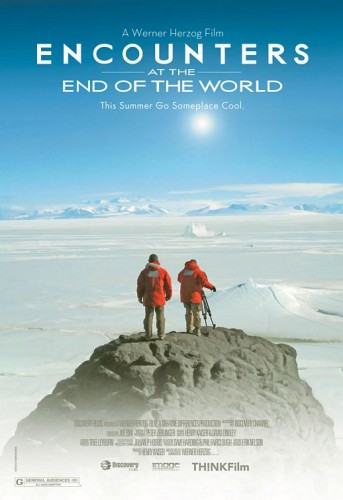
Werner Herzog’s Encounters at the End of the World
By James Holbeyfield
Ex: http://www.counter-currents.com/
Bavarian director Werner Herzog’s Antarctic odyssey Encounters at the End of the World [2] was released in 2008. It is not a work of fiction, with all the inspirational, mythological, and crystallizing power of high art; it is a documentary. It is not even, overtly at least, on the grandiose IMAXimal scale at the top of the funding ladder for conventional documentaries. But it is a film by Werner Herzog, and when a white man of Herzog’s artistic caliber has spoken, we do well to listen.
And on the very subject of Herzog’s speech, from the film’s start I was struck by the utter appropriateness of his physical voice, and I then realized that this had been true of his other films I have seen since he entered his “follow your fancy” phase of documentaries; movies that surely have the most favorable ratio of directorial talent to production budget of any in recent history.
Of course as an American, one is easy prey to certain variants of European-accented English; perceptions of discriminating taste in the received pronunciation of Oxbridge or perceptions of scientific precision in a German accent. But it was a real revelation to consider that, after three generations of blond, ice-cold, German-accented pure evil emanating from Hollywood, Herzog’s distinctly German harmonics and cadence seem to me a very appealing combination of soothing avuncularity and quiet passion.
Next, I was struck by the challenge to character that Antarctica must offer. The film opens with what seems the ultimate in gen-Y rootlessness: the gaping cargo hold of a US Air Force C-17 on wing from New Zealand to McMurdo. Travelers are snuggled under massive, lashed-down equipment like hipsters scattered about the summer decks of the Alaska State Ferry. But that must be deceptive; presumably one does not get to McMurdo, even as a janitor or barkeep, simply by buying a ticket. There must be some screening going on, probably explicit and definitely some implicit self-screening, involving the personality and character of the people who apply.
Once landed “in town,” Herzog wastes little time in showing disdain for the place. That is understandable; he must immediately have felt that he didn’t come to the end of the world to hang around its dreary, entirely artificial, service sector, necessary though dormitories, gyms, restaurants, cinema, fuel tank farms, watering holes and even an ATM are, in modern Antarctica as in modern everywhere. Still, Herzog recognized the unfairness of that attitude, and furthermore recognized a potential opportunity that he should be the last director on earth to lose; sprinkled through the film, he more than makes up for this disdain for the artificial quality of McMurdo, by inserting many neatly focused character vignettes that capture the “ultimate wanderer” nature of many McMurdo denizens.
Among them is Scott Rowland, a Colorado banker turned ice-bus driver, whose eight-ton vehicle is nicknamed “Ivan the Terra-bus.” There is William Jirsa, a linguist and computer analyst who ironically now finds himself in the one continent without native languages. And among several others, there is equipment operator and offbeat philosopher, Bulgarian Stefan Pashov, who interprets the particular role of the full-time travelers/part-time workers, the “cosmic dreamers” who are drawn to McMurdo, via a quote from Allan Watts. “Through our eyes, the universe is perceiving itself. Through our ears, the universe is listening to its harmonies. We are the witnesses through which the universe becomes conscious of its glory, of its magnificence.”
Most of the film is devoted to portraying slices, many of intoxicating visual richness, from various scientific projects in Antarctica, including studies of glaciology (“the iceberg I’m studying is not only larger than the one the Titanic hit, and larger than the Titanic itself, it’s larger than the country that built the Titanic”), seals, invertebrate ecology, a volcano, the South Pole, a neutrino detector, and yes, even a touching scene with some penguins, despite Herzog telling us, early on in the film, that he informed the National Science Foundation “I would not come up with another film on penguins.” (This last presumably referred to avoiding any accusations of trying to piggyback onto the blockbuster — for a documentary — March of the Penguins [3], first released in 2005.) And from what I have seen, most of the commentary on the film has been content to concentrate on its interesting science and visual wealth.
However, I think it is an inescapable conclusion that Herzog had an even larger theme in mind as this film came into being, one that would eventually determine its entire narrative direction. Not for nothing did Werner Herzog title this movie Encounters at the End of the World. To me, and evidently to Roger Ebert [4], to whom the film is dedicated, it is quite clear that, in addition to the obvious spatial meaning of his title, with Antarctica objectively existing at one end of our spinning planet, Herzog meant it temporally as well. In other words, Herzog recognizes that exploration and research on Earth’s last continent can be symbolic of, at the very least, the deceleration of human progress in the modern world, and perhaps of outright stagnation or even reversal. Werner Herzog definitely has some insight into Kali Yuga.
Herzog visits the remains of Shackleton’s ship, now a sort of museum. He alludes to the triumph of Amundsen and the tragedy of Scott in their epic race to the Pole. Though he does not find these Antarctic pioneers praiseworthy in every single respect, noting a degree of arrogance in the last-gasp imperialism of the contest, particularly for the Britons, Herzog is quite deliberate in distinguishing the achievements of these giants of the quite recent past to the pursuits of today’s continental Americans. To me, it is extremely telling that, to make the strongest contrast with the heroic achievements of the early Antarctic explorers directly, Herzog chose scenes, filmed in America, of a very fit and very chipper man, riding the tiger I suppose in his own way, by attaining literally hundreds of odd titles in the Guinness Book of World Records, including such novelties as Marmite eating and marathon somersaulting (his goal was to set at least one record on every continent, and that included Antarctica, thus the connection).
At this point it must be said, for white nationalist purposes at the very least, that this chipper man, born Keith Furman [5] in Brooklyn, is rather obviously a Jew; indeed so far as I can tell, the only Jew in the whole film. And I want to be clear that I do not concentrate on his Jewishness purely out of malice; in fact I can only wish I were as fit, motivated, and possessed of good habits as Mr. Furman appears to be, even if I would certainly wish any such assets on my part to lead in a quite different direction.
But I do feel two quite important points emerge from the fact of this Jewish presence. The lesser one is that it is impossible to believe that Werner Herzog, who has spent four decades in the movie industry after all, could have been completely blind as to the non-random ethnicity of this character. In investigating Antarctica, he pays high tribute to the spirit of the early explorers, explicitly Imperial European and implicitly Aryan as they were, and wishing to reach for the most striking possible contrast in post-modern heroics, a mere century after Scott and Amundsen, he settles on a Jewish holder of a world record in hula hoop racing while balancing a milk jug on the head [6]? No, no, it is quite impossible that Herzog was entirely unaware, that it was all fluke.
But regardless of the degree of intent on Herzog’s part, the larger point is that a Jew is, in fact, an excellent symbol for this particular species of last man. A Jew has to be content with somersaulting twelve miles on a rubberized track, a century after a team of Aryans has each man-hauled [7] hundreds of pounds on sledges, for ten hours a day over four months across crevassed Antarctic glaciers in weather down to forty degrees below and worse, without the benefit of modern fabrics and materials, only to die in the end so nobly that one does not wish to depress one’s comrades further and so tells them one is “just going outside [8] and may be some time”; as if to the park for a stroll. A Jew has to be content with building eyesores of the month [9] instead of the Hagia Sophia [10]. Content with filming Holes [11] instead of The Tree of Life [12]. Content with writing up a Portnoy instead of an Isabel Archer. Content with dreaming up theories of repressive mothers [13] instead of creating the evolutionary synthesis [14]. And on and on in like fashion.
One could try to argue that all this is cherry picking, sour versus sweet, except that the Jews have actually been proud of this unmitigated trash, and have convinced entire generations of the gullible that much of it represented the next big thing, the more advanced development in each field of endeavor; whereas in fact, to put the matter in Wagnerian terms, their accomplishments often are mere clumsy, ludicrous imitations of our own.
So where does this brand of nihilism lead us? Where did it lead Herzog? Not nearly as far as we would like, I’m sure. Still, I think there are a few messages. One is that we can never be certain about the future, and about the possibility of reaching for the stars. My own negativism inclines me toward Scott Locklin’s view [15] more than transhuman inevitability [16]. But Locklin and I could both be wrong. There may be more opportunities for future Amundsens and Edisons out there than we guess. Certainly I found the greatest boyish enthusiasm, ironically metaphysical, out of all the many enthusiastic white scientists portrayed in this film, to be that of the most cosmic one, physicist Peter Gorham, the neutrino researcher.
And even if it turns out such opportunities really are in decline, is that exactly the end of the world? You young white nationalists, some no doubt stewed in the internet for hours a day over almost as many years as I have been, some unwilling to travel with hipsters because they vote Democrat, and unwilling to join the Army because they die for Israel, and unwilling to roughneck the oil rigs because there they have no higher purpose; at least some of you should join these eccentrics of Werner Herzog.
So far as I could tell, again without going to foolish extremes, not one of some twenty people Herzog introduces us to by name in Antarctica is a Jew, although the jury is still out on Clive Oppenheimer, whose internet footprint does display at least a tendency to self-aggrandizement. Even brunette, accented Regina Eisert appears by googling to be German, though in the film she is wearing a snood over her hair reminiscent of those now worn by some married Orthodox Jewish women, but not so very long ago worn by white women throughout much of Europe.
The reason I’ve done this spot of googling is not so I can seethe inwardly over who is a Jew and who is not, but to demonstrate that, even at the service level, never mind the scientific level, never mind the level of a Shackleton, the cold natural beauty, the cool natural science, and the sheer adventure of Antarctica still make it the kind of place that calls to our people, and pretty much only our people. In contrast to this openness to experience, Furman’s visit to Antarctica consisted of 90 minutes pogo-sticking down a runway [17]. These people, adapted to the white brain instead of to a piece of this beautiful earth, truly know the price of every continent and the value of none.
So calling all suitable young Aryans! Some of you should apply for McMurdo, go work in Alaska, bide awhile in North Dakota or even Siberia. I have little doubt that most of Herzog’s Antarctic subjects would be Obama voters in America, but I’m saying that their actions are more implicitly Aryan than some of ours. And many of us are just as eccentric as they are, even if our eccentricity does not run to trying to save endangered languages or hitchhiking through Africa.
But if anyone does go, it would be well to shut up about whiteness for awhile. One has a better chance to be convincing later if one is first quiet and strong in such places, which are never for blowhards. Try to prove your character to yourself; it doesn’t have to be the character of Robert Falcon Scott, it just has to get better and tougher. And at the very least, you will have traveled, had some interesting experiences in unusual or difficult spots, and, if you need to earn a grubstake, it seems fair to say that barkeep pay in McMurdo must be a lot higher than in N’Awlins [18].
Article printed from Counter-Currents Publishing: http://www.counter-currents.com
URL to article: http://www.counter-currents.com/2013/03/werner-herzogs-encounters-at-the-end-of-the-world/
URLs in this post:
[1] Image: http://www.counter-currents.com/wp-content/uploads/2013/03/encounters_at_the_end_of_the_world_2007_580x435_710896.jpg
[2] Encounters at the End of the World: http://www.amazon.com/gp/product/B001DWNUD8/ref=as_li_ss_tl?ie=UTF8&camp=1789&creative=390957&creativeASIN=B001DWNUD8&linkCode=as2&tag=countercurren-20
[3] March of the Penguins: http://www.amazon.com/gp/product/B000N3SSA8/ref=as_li_ss_tl?ie=UTF8&camp=1789&creative=390957&creativeASIN=B000N3SSA8&linkCode=as2&tag=countercurren-20
[4] Roger Ebert: http://rogerebert.suntimes.com/apps/pbcs.dll/article?AID=/20080707/PEOPLE/657811251
[5] Keith Furman: http://en.wikipedia.org/wiki/Ashrita_Furman
[6] hula hoop racing while balancing a milk jug on the head: http://www.ashrita.com/records/all_records
[7] man-hauled: http://artofmanliness.com/2012/04/22/what-the-race-to-the-south-pole-can-teach-you-about-how-to-achieve-your-goals/
[8] just going outside: http://www.englishclub.com/ref/esl/Quotes/Last_Words/I_am_just_going_outside_and_may_be_some_time._2690.htm
[9] eyesores of the month: http://www.dezeen.com/2011/11/17/dresden-museum-of-military-history-by-daniel-libeskind-more-images/
[10] Hagia Sophia: http://en.wikipedia.org/wiki/Hagia_Sophia
[11] Holes: http://3.bp.blogspot.com/_OyXJF_PLAKM/TT-J-wdleuI/AAAAAAAAAFc/NOIARFtXlZI/s1600/1999+boys+of+d+tent2.jpg
[12] The Tree of Life: http://www.twowaysthroughlife.com/
[13] theories of repressive mothers: http://en.wikipedia.org/wiki/Freud#Psychosexual_development
[14] evolutionary synthesis: http://en.wikipedia.org/wiki/Julian_Huxley
[15] Scott Locklin’s view: http://takimag.com/article/the_myth_of_technological_progress/print#axzz2M4aOvuQE
[16] transhuman inevitability: http://en.wikipedia.org/wiki/Ray_Kurzweil
[17] 90 minutes pogo-sticking down a runway: http://www.ashrita.com/records/record_descriptions/pogo_stick_jumping
[18] N’Awlins: http://www.youtube.com/watch?v=kXpwAOHJsxg
00:05 Publié dans Cinéma | Lien permanent | Commentaires (0) | Tags : allemagne, cinéma, film, werner herzog |  |
|  del.icio.us |
del.icio.us |  |
|  Digg |
Digg | ![]() Facebook
Facebook
dimanche, 17 mars 2013
Youth Without Youth

Youth Without Youth
By Trevor Lynch
Ex: http://www.counter-currents.com/
Youth Without Youth [2] (2007) is Francis Ford Coppola’s stunning film adaptation of a novella of the same name [3]
by Mircea Eliade [4] (1907–1986), the Romanian scholar of comparative religion and Iron Guard sympathizer. I highly recommend this beautiful, mysterious, endlessly captivating movie. In style, it is classic; in substance, it is eternal.
Filmed on location in Romania, Switzerland, India, and Malta, Youth Without Youth looks, feels, and sounds like a European movie from the 1950s. The color is sumptuous and the cinematography astonishingly detailed, almost tactile. The pacing and editing are generally languid and sinuous, although they are often intercut with annoying, herky-jerky interludes, to farcical effect. The special effects date from the silent age and are entirely effective. The score [5] by Osvaldo Golijov (who describes himself as an East European Jew born in Argentina) is in the lush, late Romantic idiom, although it avails itself of Oriental and “modernist” styles when the film requires it.
Since this movie is long gone from the theaters, I have no compunction about summarizing the whole story. Youth Without Youth strikes me as a retelling of the Faust myth, particularly Goethe’s Faust. As in Faust, the main character is a scholar who late in life despairs that his life’s work is a failure but who is given miraculous gifts, including restored youth, by which he might continue his quest for knowledge.
Youth Without Youth begins in Piatra Neamț, Romania in 1938. Dominic Matei (played by Tim Roth), a former teacher in a provincial college or lycée, has just turned 70. He is experiencing the onset of senility and despairs of finishing his life’s work, an investigation into the origins of language and consciousness that has stalled before the dark abysses of prehistory. He decides to kill himself and chooses a particularly horrible death: strychnine.
He travels to Bucharest on Easter weekend to take the poison far from home, where nobody will know him. But as he approaches his final destination, he is caught in a sudden downpour and struck by lightning, which incinerates his clothes and burns every inch of his body.
Astonishingly, he is not killed. He is taken to a hospital, where he is bandaged from head to toe and watched over by doctors who fully expect him to die. But to everyone’s surprise, he slowly recovers, and when the bandages are removed, they find a man in his 30s. Dominic Matei has been miraculously regenerated. He also discovers that his memory and other mental faculties have not just been regenerated but enormously enhanced, eventually developing into powers of telepathy and telekinesis. He can learn other languages telepathically and “read” books simply by holding them for a few seconds and concentrating on them.
Furthermore, he encounters a “double”: an entity that looks exactly like him but who is wiser and more powerful and who can thus offer him guidance and protection. (The double first appears in mirrors and dreams before being seen in the real world. We learn that he is not an illusion when another character sees him as well.) The double functions as a guardian angel, a daimon, a spiritual guide. Perhaps he can do this because he is Dominic, but a Dominic whose powers are fully actualized. As an interlocutor, however, the double has a Mephistophelean quality, for he clearly rejects Dominic’s Western ethical humanism in favor of a Hindu-like non-dualism and transhumanism, and the double urges Dominic to do and accept things he finds abhorrent.
As with Faust, Dominic’s new form of existence can, apparently, be prolonged indefinitely under the right conditions. But as with Faust, it can also end. When Faust feels satisfaction, he dies, and his soul if forfeit. Dominic’s double tells him he is free to accept or reject his gift and free to use it for good or for evil.
Word of Dominic’s astonishing transformation spreads around the world. He is placed under constant surveillance by the Romanian Secret Police, who are in a heightened state of alert because they are doing battle with the Iron Guard. (Corneliu Codreanu had been arrested in April, 1938 and was murdered that November.) They even suspect that Dominic may be an Iron Guard leader hiding in the hospital under a false identity. (There is, of course, something autobiographical about the character of Dominic Matei, for Eliade too was a scholar of language and myth who was suspected, rightly, of Iron Guard connections. Eliade also wrote the novella in old age, when time is short and the mind is given to nostalgia and fantasies of regeneration.)
The Gestapo also take an interest in Dominic because he seems to confirm the theories of a German scientist, Dr. Joseph Rudolf, who hypothesizes that high voltage electrocution might spark the evolution of a higher form of humanity. Matei’s doctor and host, Professor Stanciulescu (Bruno Ganz), realizes Dominic’s powers when he sees two roses from his garden materialize in Dominic’s room with the help of the double. Thus the Professor refuses to allow the Germans to take Matei, citing medical grounds. They threaten to return with a German doctor who will do their bidding. Thus Stanciulescu arranges false papers so that Matei can leave Romania for Switzerland.
Coppola’s treatment of the Germans is one of the few places the movie rings false and silly. He seems to think that Romania was under German occupation in 1938 or ’39, which never happened. The Germans, of course, are portrayed as fanatics and martinets, and their leader even gives the Hitler salute to Professor Stanciulescu. I have not read the novella, but it is impossible to believe that such farcical inaccuracies are found in the original.
Dominic Matei spends the Second World War in neutral Switzerland, where he leads a life that is part Mircea Eliade, part James Bond. He continues his research into the origins of language and consciousness. He also develops new powers, including abilities to create false identities and beat the house in casinos, which is how he supports himself.
One night, Dominic is confronted in an alleyway by the Nazi scientist Dr. Rudolf. Rudolf explains to Dominic that he must return with him to Germany, because only with his help can Rudolf construct a bridge from man to superman, which is the only way that mankind can survive the coming nuclear apocalypse. Rudolf wishes to preserve the high culture of the West: music, art, philosophy, and science. He claims that Dominic was sent by some sort of providence to help save mankind. He promises to admit him to the godlike presence of Adolf Hitler. But Dominic refuses to cooperate with the Nazis. Rudolf pulls a gun and tries to abduct Dominic. When a female Romanian agent of the Gestapo tries to defend Dominic, Rudolf shoots her. The double, who evidently wants Dominic to go with Rudolf, tells him that he has no choice in the matter. But Dominic does have a choice: he telekinetically forces Rudolf to shoot himself, then he escapes.
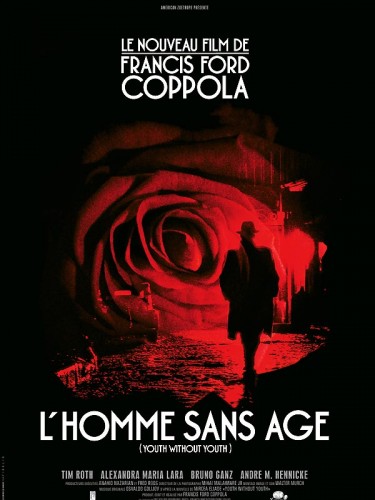
Dominic is also convinced that the Second World War will not be the last. He anticipates that mankind will be almost annihilated by nuclear warfare, and he fears that “post-historical man” will succumb to despair. Thus be begins to tape a record of his transformation, depositing the tapes in a bank vault. He hopes that they will somehow survive the end of history and be deciphered by men in the future, giving them hope that humanity might evolve. Of course he has no assurance that the tapes will survive, but believes it anyway, because without this belief, his life would have no meaning.
The second half of the movie begins in 1955, when Dominic encounters a young German woman on vacation in Switzerland (Alexandra Maria Lara). Her name is Veronica, but she is the very image of Laura, Dominic’s former fiancée, who a lifetime ago had broken off their engagement because he was too involved in his work. She then married another man and died in childbirth a year later. The double confirms that Veronica is the reincarnation of Laura. (She is roughly analogous to Gretchen in Goethe’s Faust.)
Veronica’s car is struck by lightning, and her companion is killed. When Dominic finds Veronica, she is speaking in an ancient Indian dialect and claims that her name is Rupini, a woman of the Kshatriya caste, a descendant of one of the first families to convert to Buddhism, who had left the world behind to meditate in a cave.
Veronica/Rupini becomes an international sensation, because she seemingly provides proof of reincarnation. (Veronica herself later suggests spirit possession as an alternative hypothesis.) Veronica/Rupini demonstrates knowledge that Veronica did not and could not have learned during her lifetime. Dominic becomes her caretaker. He summons leading orientalists to study her case, and eventually she is flown to India, where she finds Rupini’s cave, complete with her mortal remains. Then Rupini’s peronality disappears and Veronica’s re-emerges. She and Dominic fall in love. Veronica tires quickly of being a world celebrity, so she and Dominic flee India to a private villa on Malta.
On Malta, Dominic discovers he has to power to induce trances in which Veronica regresses to past lives, speaking Ancient Egyptian, then Akkadian and Sumerian, then unknown protolanguages which Dominic eagerly records and transcribes. He recognizes that Veronica might be the vehicle he needs to pierce the veil of prehistory and reach the origins of language and consciousness. The double confirms this.
But with each trance, Veronica becomes increasingly drained and begins to age rapidly. Dominic realizes that if he continues to induce regressions, she will wither and die, so he has to choose between Veronica and the completion of his life’s work. He tells Veronica that they must part. If they stay together, she will die. If they part, her youth and beauty will be restored.
In 1969, when he is 101 years old, Dominic sees Veronica and her two children get down from a train. Heartbroken, he surreptitiously photographs her. He returns to his home town in Romania. In the mirror of his hotel room, he has a conversation with his double. The double reveals that he is indeed the harbinger of a new race, which will arise from the electromagnetic pulse released by an approaching nuclear holocaust. Most of mankind will perish in the process, but a superhumanity will emerge. Disgusted at the sacrifice of man to create the superman, Dominic smashes the mirror, rejecting his gift. The double, gibbering some unknown language, disappears.
Dominic then goes to his old haunt, the Café Select, where he hallucinates an encounter with friends from the 1930s. During the conversation, he rapidly ages, then stumbles out into the night. The next morning, he is found frozen to death in the snow.
But the end is ambiguous, for at the very end of the film, we hear Veronica’s voice ask Dominic, “Where do you want me to put the third rose?” which then appears in his hand. So is Dominic Matei really dead? He has been all but dead before, remember. So is this just another start? Will he keep coming back until he learns his lesson and his mission is fulfilled? Or is he really dead, but under the protection of Veronica, like Faust whose soul is saved in the end by the intercession of the Eternal Feminine?
Youth Without Youth is a movie about transcending the human condition: backwards, toward the pre-human origins of language and consciousness, and forwards, toward the advent of the superhuman. Dominic Matei is given the power to do both.
He could have arrived at the origin of human language and consciousness through Veronica’s trances, but he was unwilling to sacrifice her to his quest for knowledge.
He is already superhuman, but he could choose to help prepare the way for superhumanity. He had a chance to assist Dr. Rudolf, but he rejected it because he thought that Hitler was the devil himself. In the end, he rejected his own superhumanity simply because he was repelled by the idea that superhumanity would emerge from the destruction of humanity.
In both cases, the path to transcendence of the human realm was blocked by Dominic’s humanistic ethics, the idea that every human being has a dignity or worth that forbids its sacrifice for higher values. Thus Youth Without Youth explores the same fundamental conflict that animates Christopher Nolan’s The Dark Knight Trilogy [6]: the ethic of egalitarian humanism versus the ethic of superhumanism, of the individuals who raise themselves above humanity either through a Nietzschean rejection of slave morality and a Heideggerian encounter with mortality and contingency (the Joker) or through the initiatory knowledge of the League of Shadows. (As I argue in my review [7] of The Dark Knight Rises, the two forms of superhumanism are compatible, but Nietzsche, Heidegger, and the Joker only grasp a small part of a much greater truth.)
Youth Without Youth is, in short, a deeply serious film: a feast for the intellect as well as the senses. A commercial and critical flop when it was released in 2007, Youth Without Youth is in truth one of Francis Ford Coppola’s finest films.
Article printed from Counter-Currents Publishing: http://www.counter-currents.com
URL to article: http://www.counter-currents.com/2013/03/youth-without-youth/
URLs in this post:
[1] Image: http://www.counter-currents.com/wp-content/uploads/2013/03/youth-without-youth.jpg
[2] Youth Without Youth: http://www.amazon.com/gp/product/B0014I4TR2/ref=as_li_ss_tl?ie=UTF8&camp=1789&creative=390957&creativeASIN=B0014I4TR2&linkCode=as2&tag=countercurren-20
[3] novella of the same name: http://www.amazon.com/gp/product/0226204154/ref=as_li_ss_tl?ie=UTF8&camp=1789&creative=390957&creativeASIN=0226204154&linkCode=as2&tag=countercurren-20
[4] Mircea Eliade: https://en.wikipedia.org/wiki/Eliade
[5] score: http://www.amazon.com/gp/product/B000WVPXD6/ref=as_li_ss_tl?ie=UTF8&camp=1789&creative=390957&creativeASIN=B000WVPXD6&linkCode=as2&tag=countercurren-20
[6] The Dark Knight Trilogy: http://www.counter-currents.com/tag/lynch-dark-knight/
[7] review: http://www.counter-currents.com/2012/07/the-dark-knight-rises/
00:05 Publié dans Cinéma, Littérature | Lien permanent | Commentaires (0) | Tags : cinéma, film, mircea eliade, lettres, lettres roumaines, roumanie, littérature, littérature roumaine |  |
|  del.icio.us |
del.icio.us |  |
|  Digg |
Digg | ![]() Facebook
Facebook
dimanche, 03 mars 2013
Depardieu veut faire un film sur la Tchétchénie
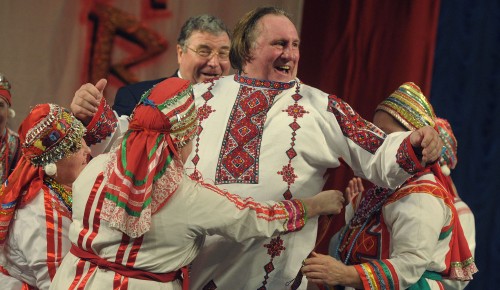
Depardieu veut faire un film sur la Tchétchénie
Source
00:12 Publié dans Actualité, Cinéma | Lien permanent | Commentaires (0) | Tags : depardieu, russie, tchétchénie, cinéma, film, 7ème art |  |
|  del.icio.us |
del.icio.us |  |
|  Digg |
Digg | ![]() Facebook
Facebook



